A Tourist in Rome - National Museum of Rome - Terme di Diocleziano
Because of that final Hall X, I would rate this museum as a second-tier museum, nearly as good as the National Museum of Rome - Palazzo Massimo. Since the two museums are covered by the same admission charge, and only a block apart from each other, you can easily tack this museum onto the back of a visit to the National Museum of Rome - Palazzo Massimo and spend the full 90 minutes I suggest, or just see Hall X for 20 minutes, whatever suits your timing needs and interests best.
Enter the museum on the side of the building on Viale Enrico de Nicola. You'll pass through a The Garden of the Cinquecento where you'll find the huge marble Krater in the 1st photo below, 6-feet tall, at the center of a round fountain. The entrance to the museum is near where the two people in the background are standing.
The Entrance Hall displays several sculptures and other artefacts. The marble statue of Junius Brutus is not from ancient times, but rather a sculpture inspired by the Capitoline Brutus.
The next section of the museum is the most "museum-like" part, an indoor section divided into rooms. It's called the Epigraphic Museum since it displays many inscriptions. Room V of the epigraph museum, split between the ground floor and the mezzanine, and subsequent rooms contain many sculptures of the Emperors, and that was my favorite part of the Epigraphic Museum. The photos below are from the Epigraphic Museum.
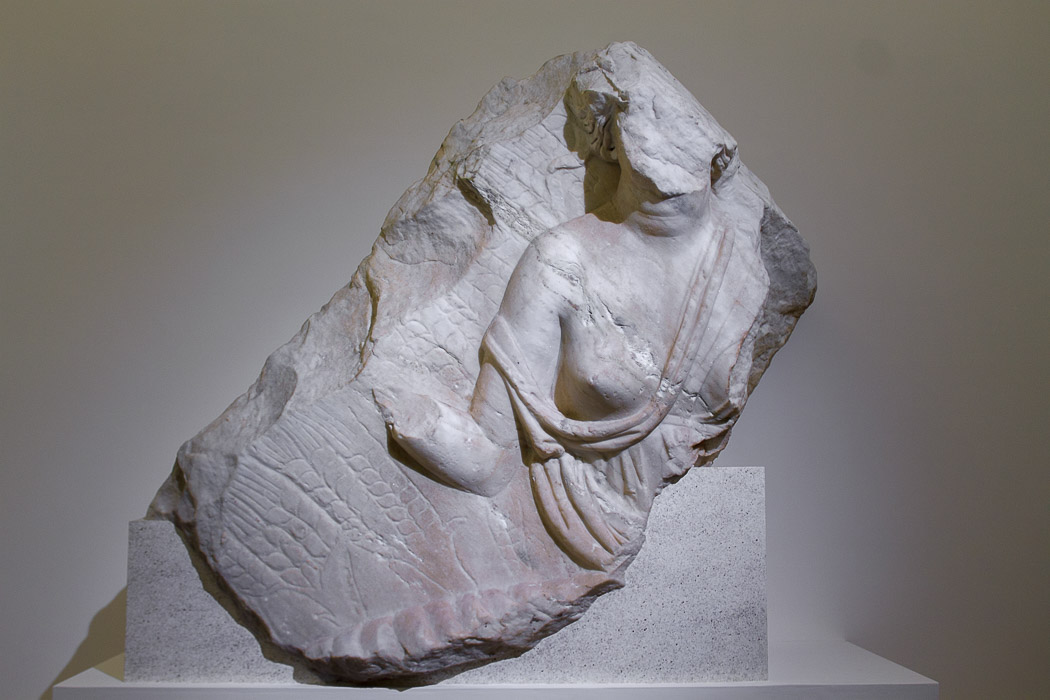
IMG_7723-20141007: The portion of a pediment which portrayed the goddess Ceres dressed in a lightweight tunic, which once occupied the area of the Baths of Diocletian, now in the National Museum of Rome, Terme di Diocleziano (Baths of Diocletian)
See all
National Museum of Rome - Terme di Diocleziano photos.
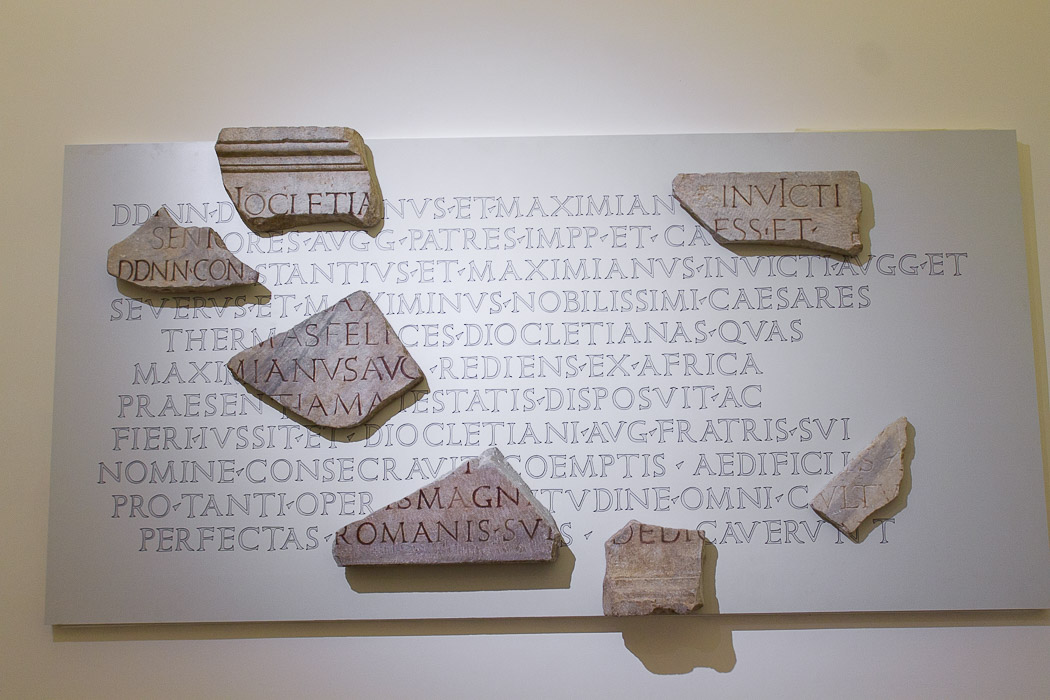
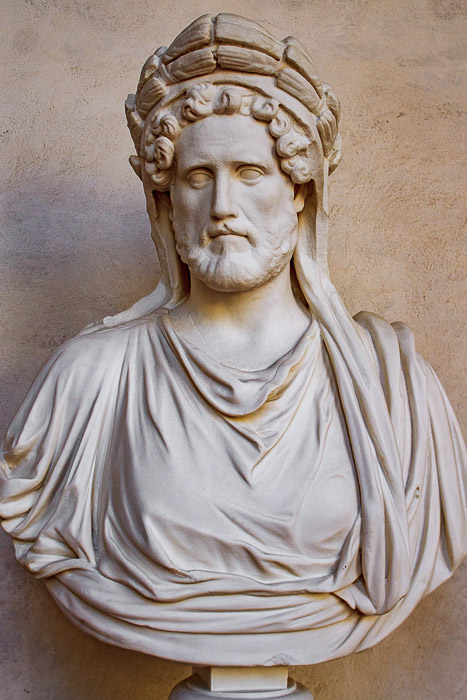

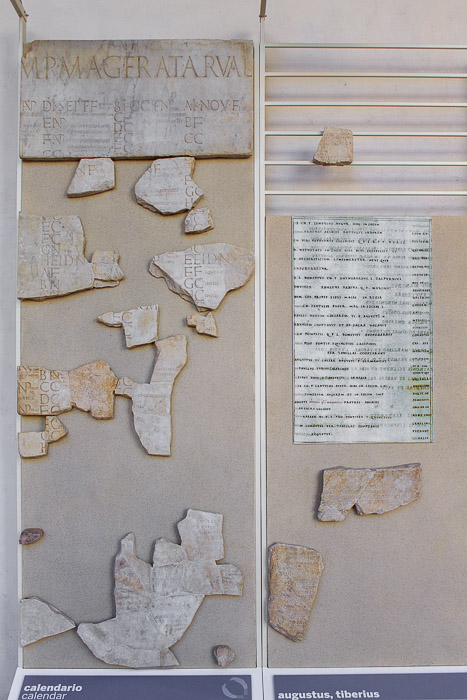
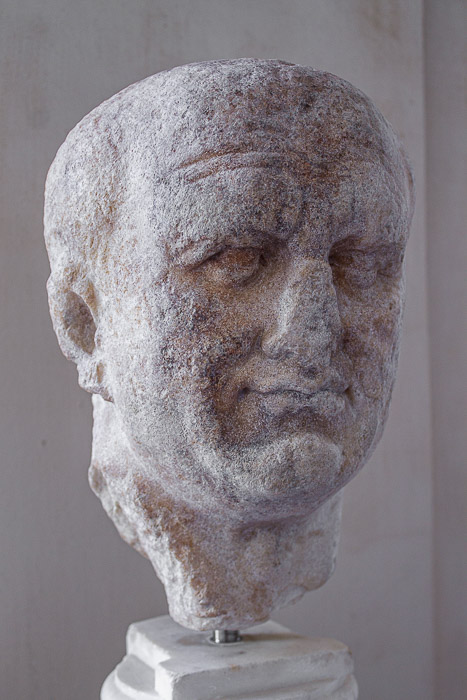
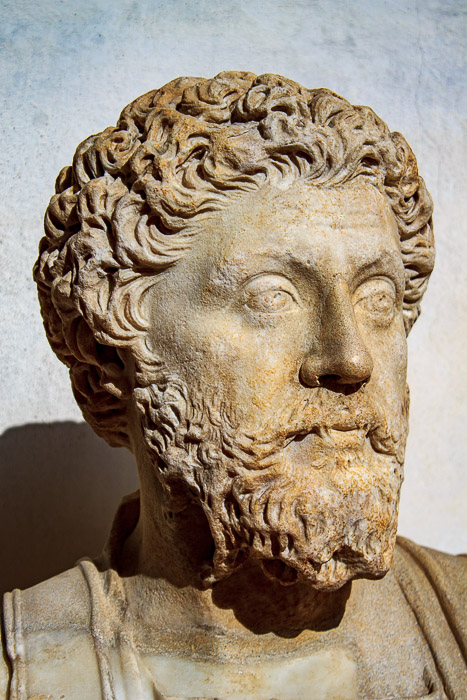
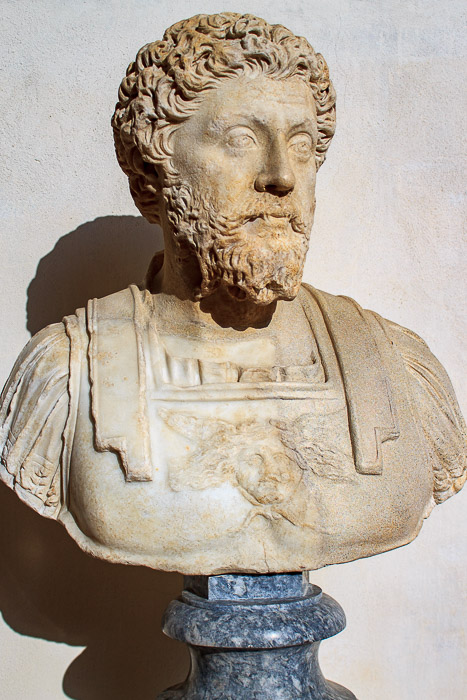
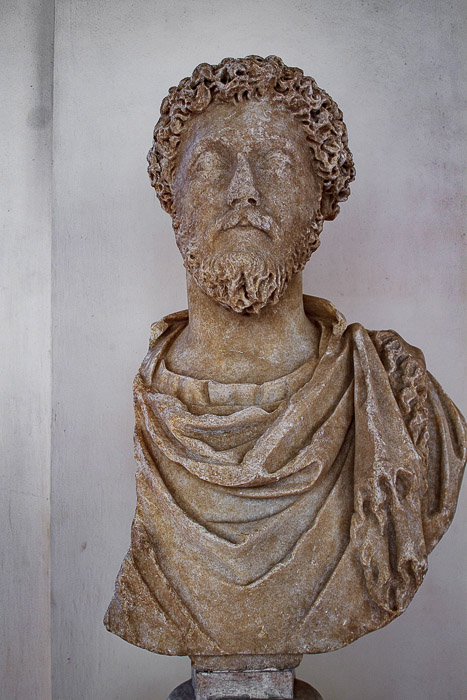
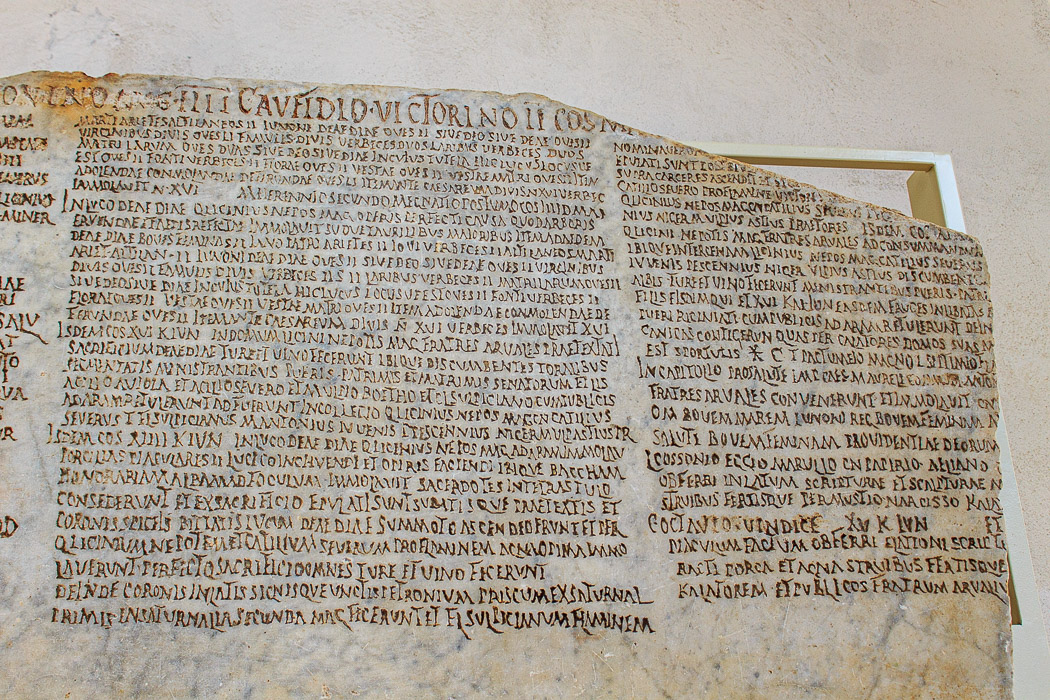
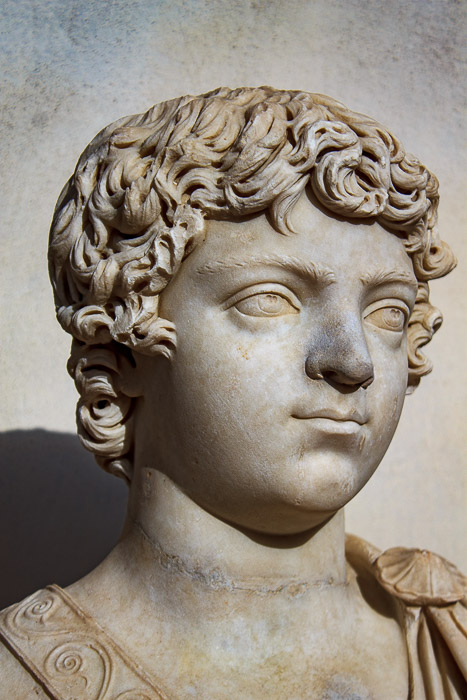
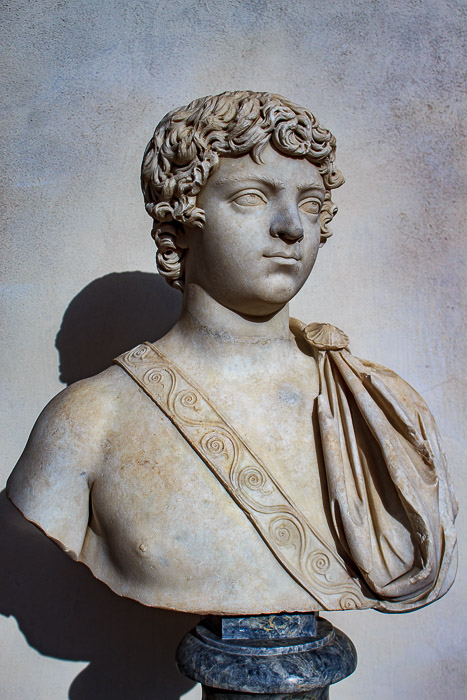
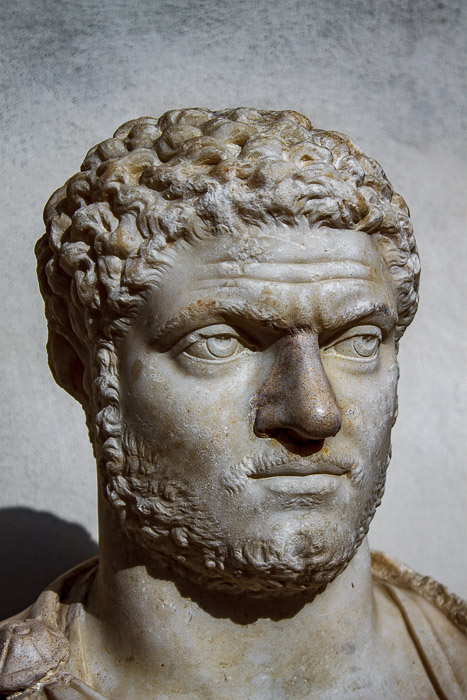
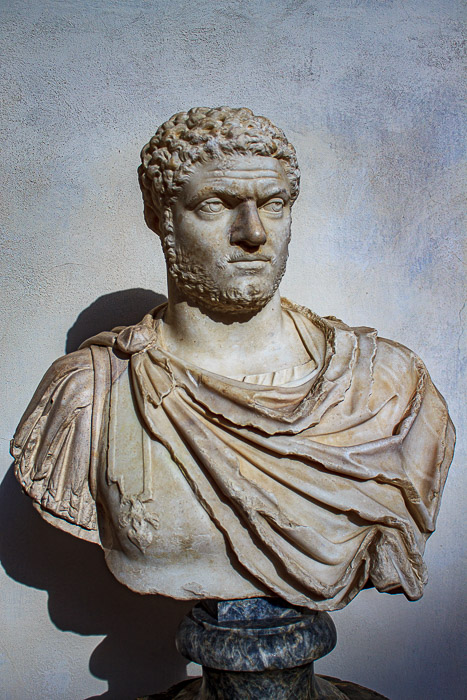
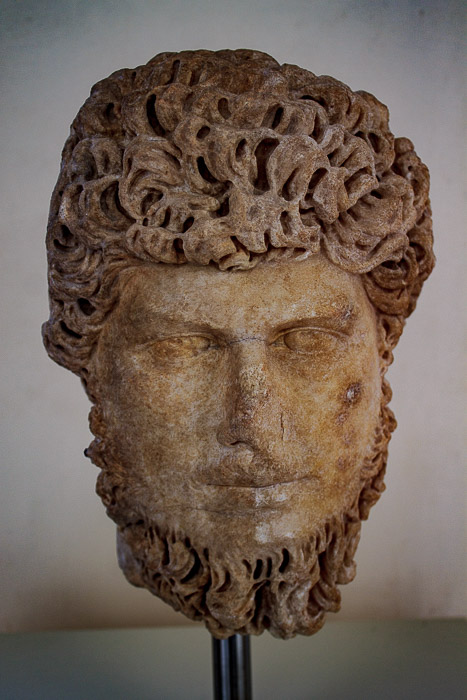

IMG_0205-20141012: A statue wearing a toga, with a different head, on whose right side there is a casket full of volumes representing copies of imperial letters, from the 3rd century AD, in the National Museum of Rome, Terme di Diocleziano (Baths of Diocletian)
See all
National Museum of Rome - Terme di Diocleziano photos.
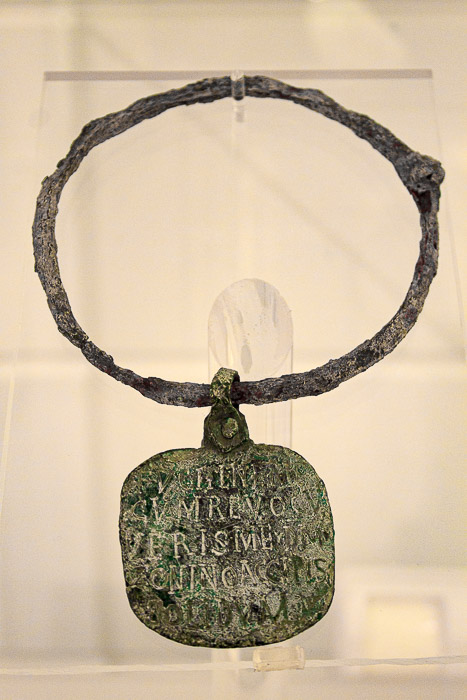
IMG_0208-20141012: A slave's iron collar with a bronze plate from the 4th-6th century AD, in Room VIII of the Epigraphic Museum in the National Museum of Rome, Terme di Diocleziano (Baths of Diocletian). The inscription requests whoever sees the would-be runaway slave to bring him back to his owner, Zonius, for the reward of a gold coin.
See all
National Museum of Rome - Terme di Diocleziano photos.
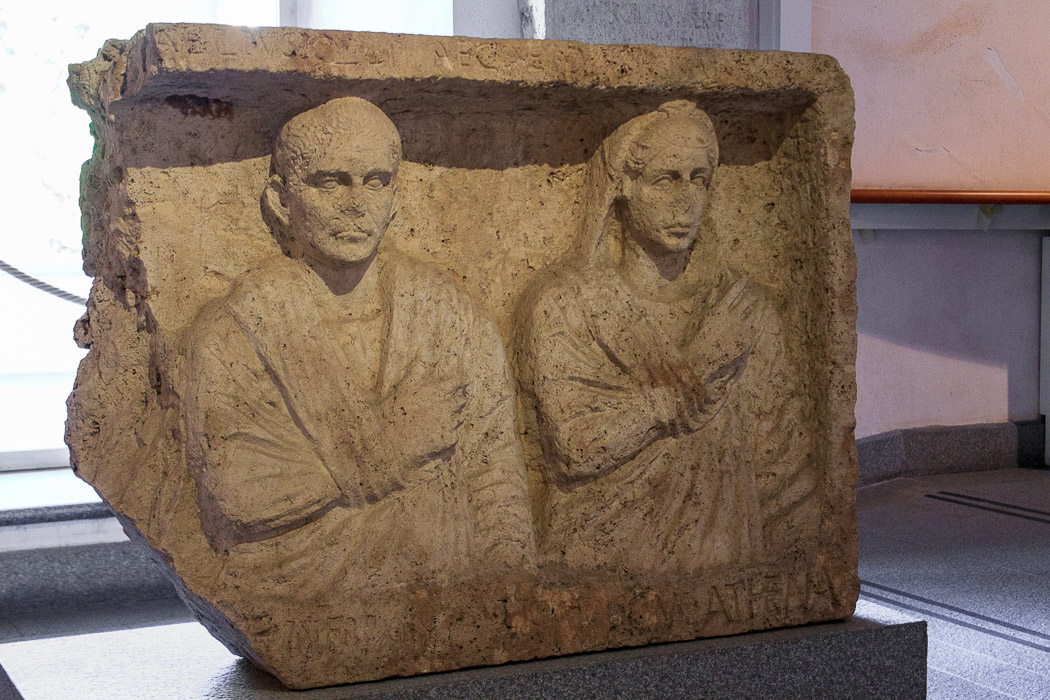
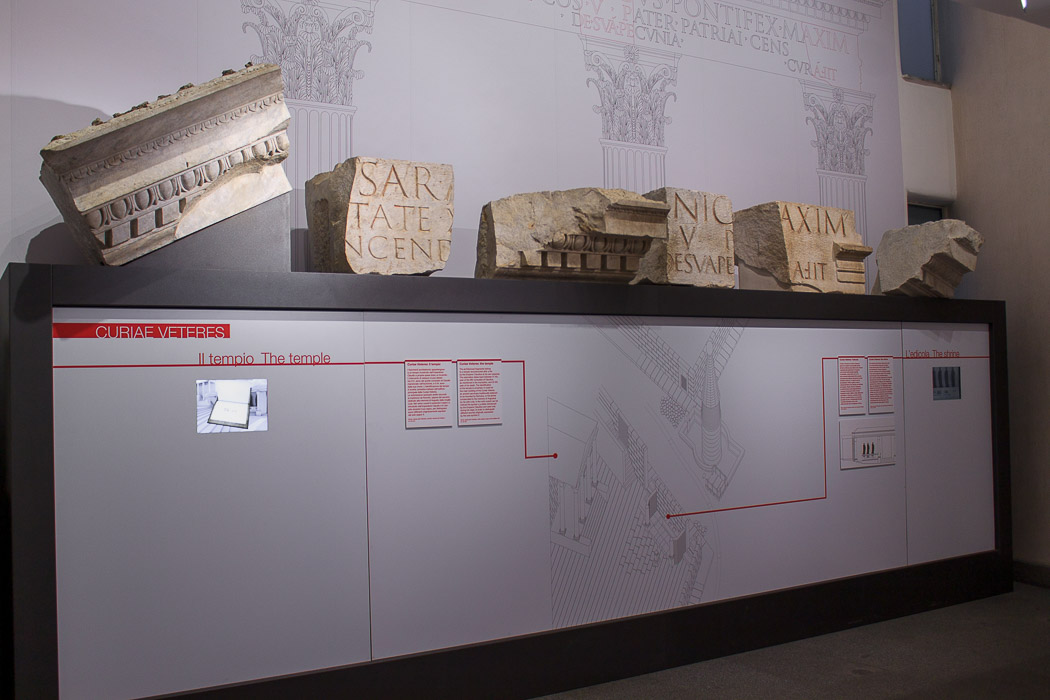
IMG_7782-20141007: A temple reconstructedin 51 AD by Emperor Claudius at his own expense after a fire. It might be the Temple of the Curiae Veteres, an ancient sanctuary believed to be founded by Romulus, or it might be the shrine consecrated to the memory of Augustus by his wife Livia, in the National Museum of Rome, Terme di Diocleziano (Baths of Diocletian)
See all
National Museum of Rome - Terme di Diocleziano photos.
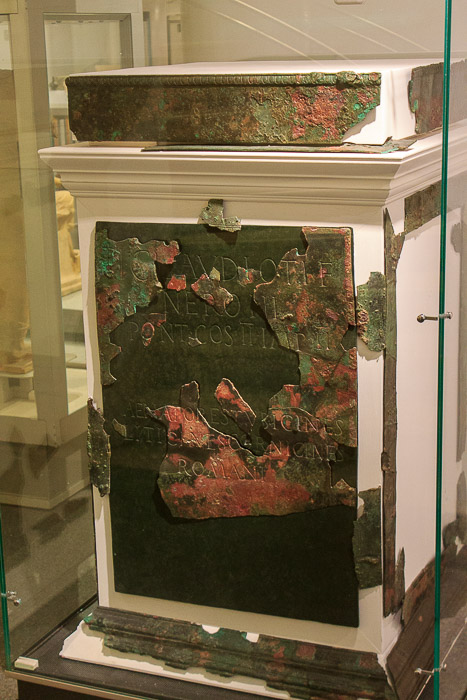
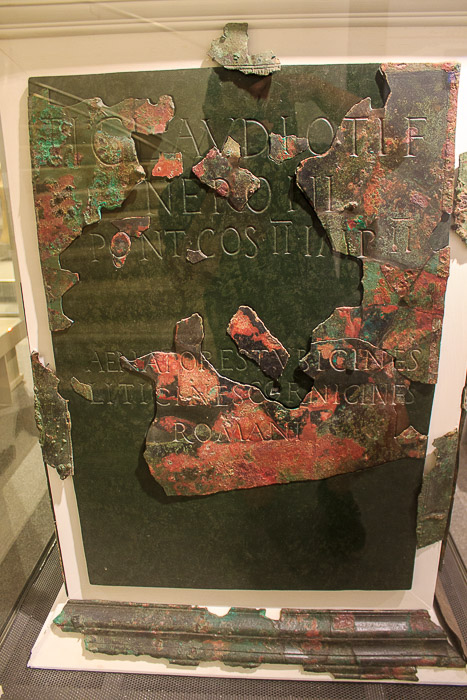
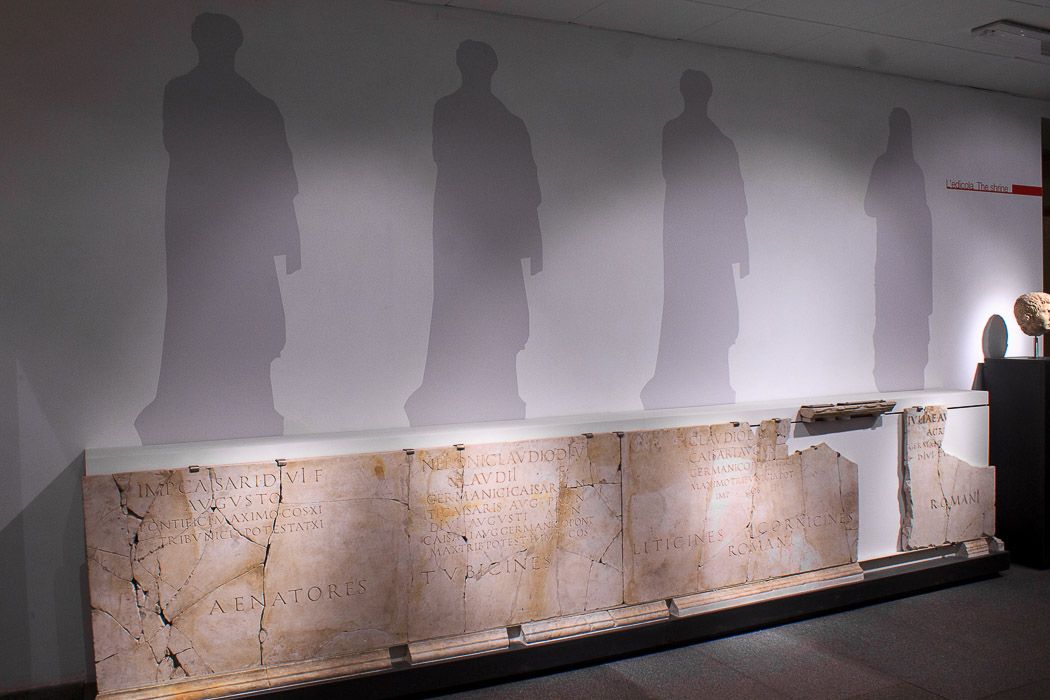
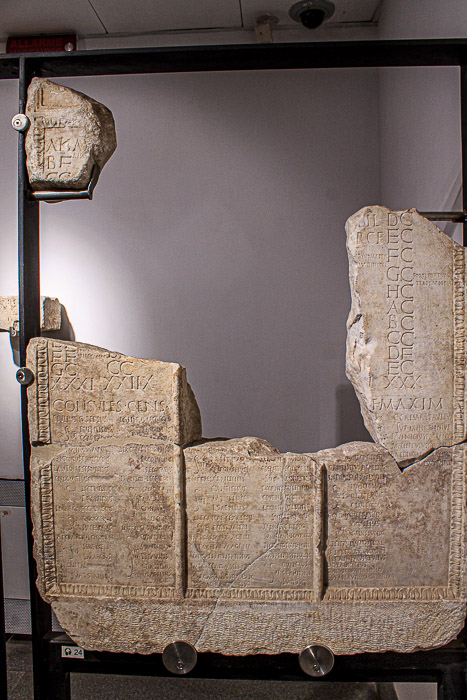
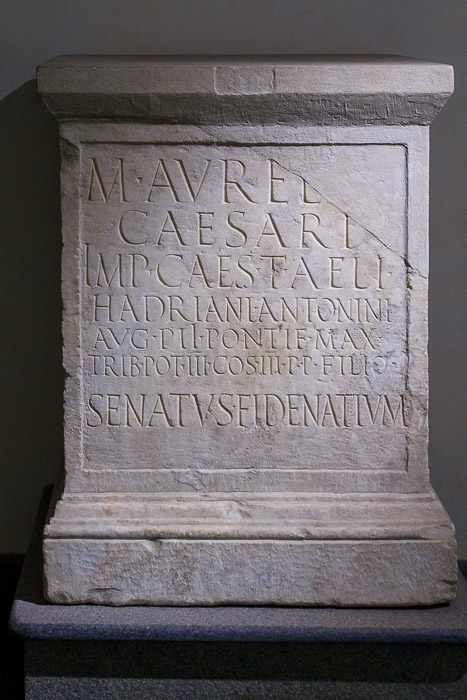
IMG_7792-20141007: A base dedicated to Marcus Aurelius, who was not yet emperor, by the senate of Fidene, in the National Museum of Rome, Terme di Diocleziano (Baths of Diocletian). The title of Caesar indicates his nomination as successor to his adopted father Antoninus Pius.
See all
National Museum of Rome - Terme di Diocleziano photos.
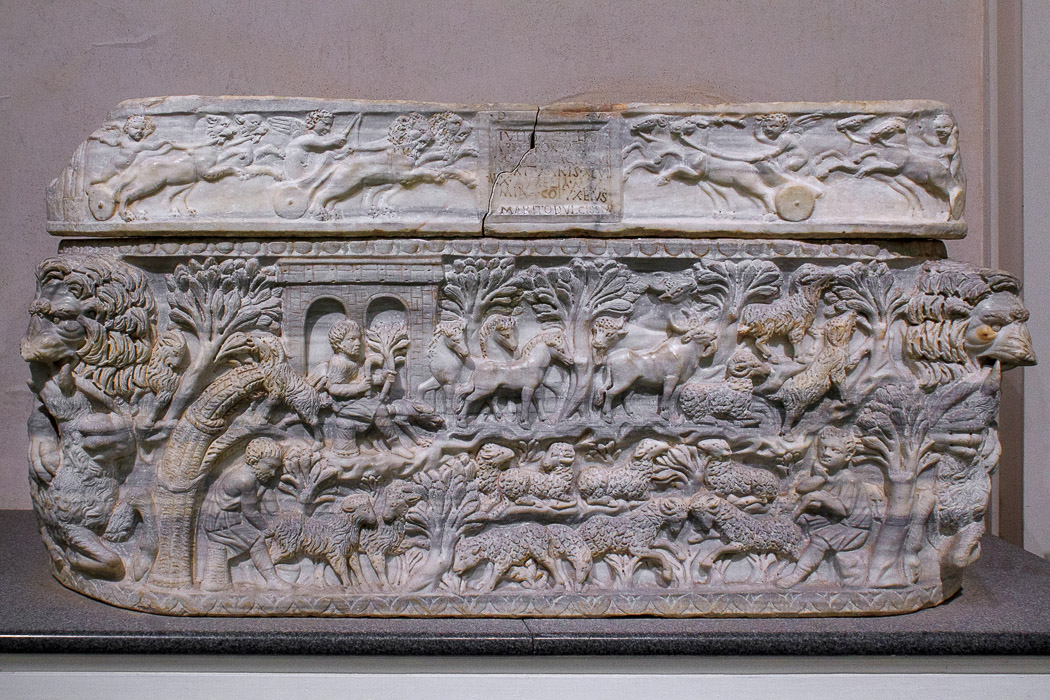
IMG_7794-20141007: Sarcophagus of Julius Achilleus with pastoral scenes, in Room VI of the Epigraphic Museum of the National Museum of Rome, Terme di Diocleziano (Baths of Diocletian). His wife dedicated this sarcophagus. He was a superintendant of the gladiatorial barracks of Rome at the Ludus Magnus.
See all
National Museum of Rome - Terme di Diocleziano photos.
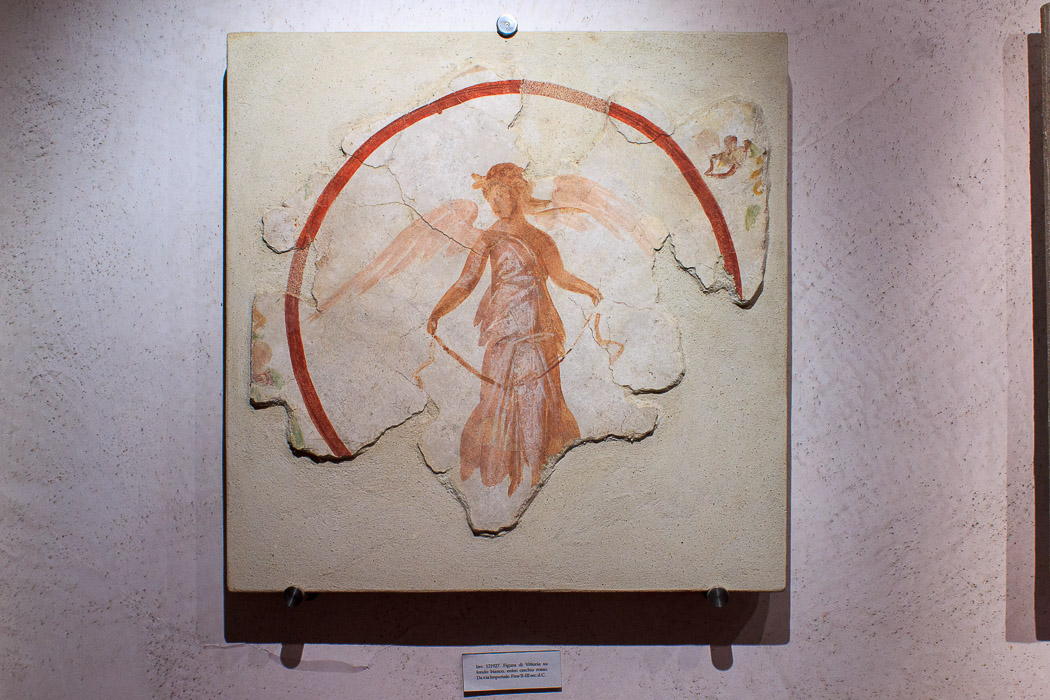
IMG_7795-20141007: Figure of Victory on white, within the red circle, from the 2nd-3rd century AD, found on Via di Fori Imperiali, now in the National Museum of Rome, Terme di Diocleziano (Baths of Diocletian)
See all
National Museum of Rome - Terme di Diocleziano photos.
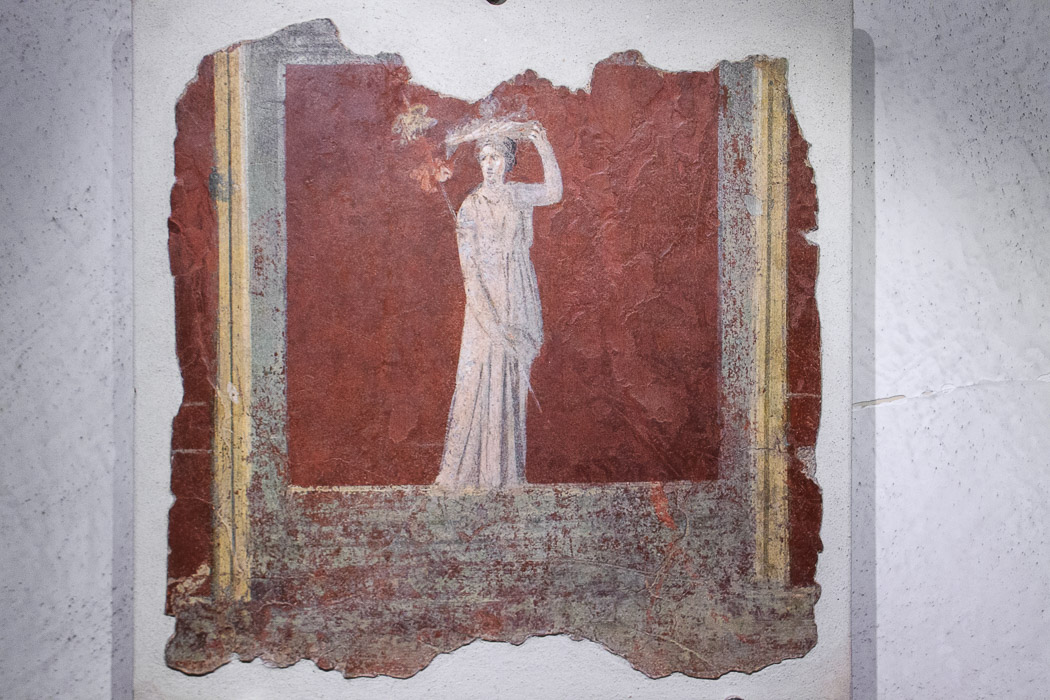
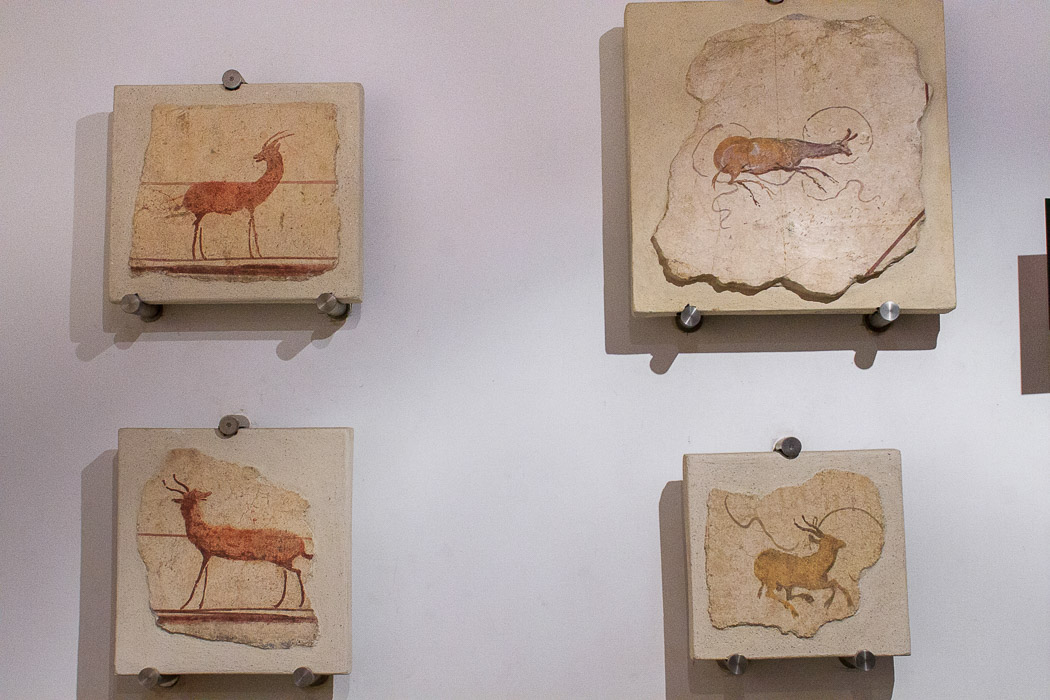
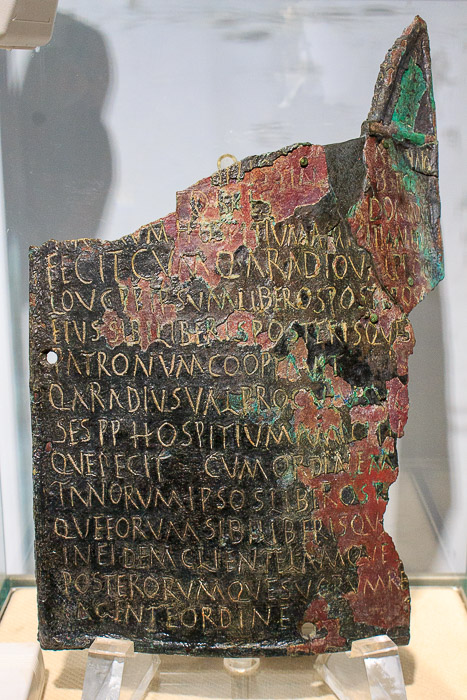
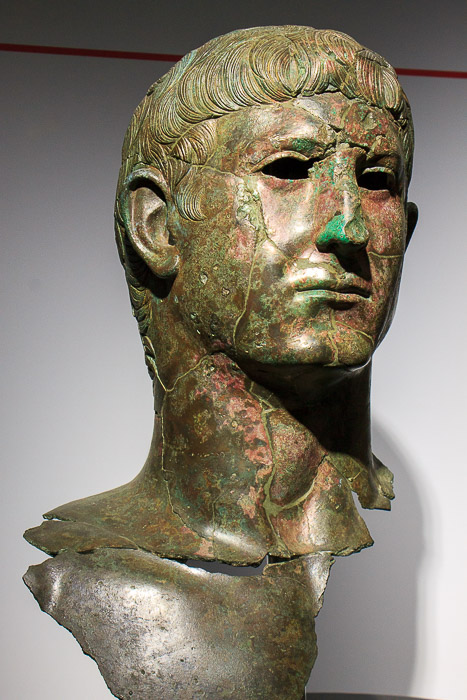
IMG_7801-20141007: Head and Inscription of a statue given by Marcus Vibrius Marcellus to his legion commander Lucius Cornelius Pusio in about 55 AD, on his return from battles in Germany, now in the National Museum of Rome, Terme di Diocleziano (Baths of Diocletian)
See all
National Museum of Rome - Terme di Diocleziano photos.
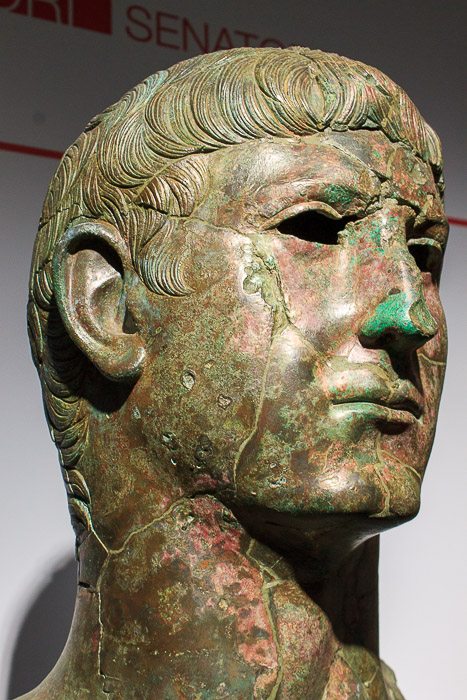
IMG_7802-20141007: Head and Inscription of a statue given by Marcus Vibrius Marcellus to his legion commander Lucius Cornelius Pusio in about 55 AD, on his return from battles in Germany, now in the National Museum of Rome, Terme di Diocleziano (Baths of Diocletian)
See all
National Museum of Rome - Terme di Diocleziano photos.
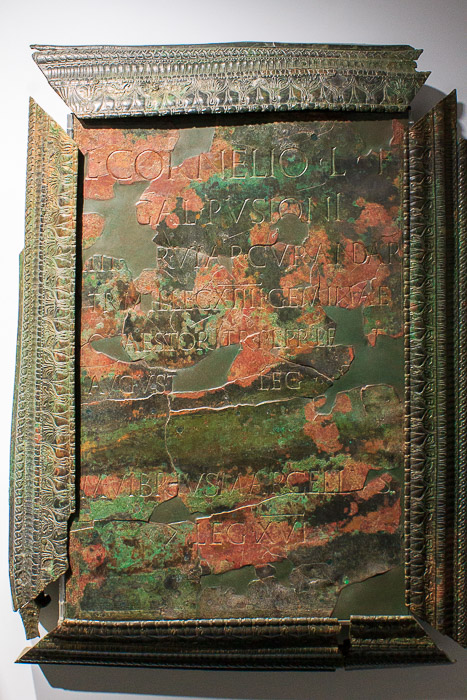
IMG_7803-20141007: Head and Inscription of a statue given by Marcus Vibrius Marcellus to his legion commander Lucius Cornelius Pusio in about 55 AD, on his return from battles in Germany, now in the National Museum of Rome, Terme di Diocleziano (Baths of Diocletian)
See all
National Museum of Rome - Terme di Diocleziano photos.
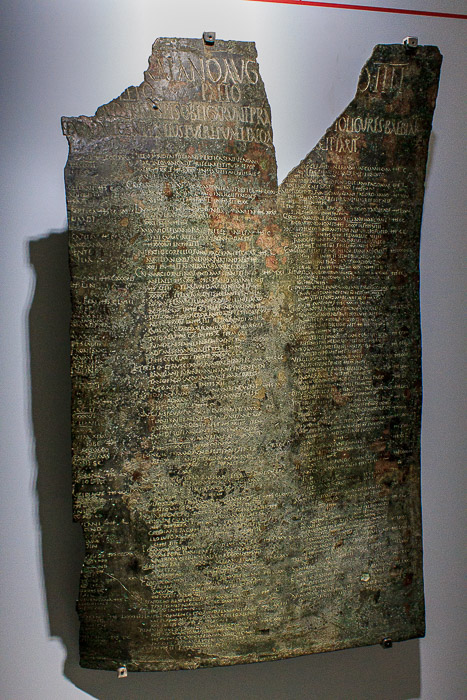
IMG_7805-20141007: The Tabula of the Ligures Baebiani, showing a list of non repayable loans granted to landowners in the area and secured by mortgages on land value, established by Trajan in 101 AD, now in Room VII of the Epigraphic Museum in the National Museum of Rome, Terme di Diocleziano (Baths of Diocletian)
See all
National Museum of Rome - Terme di Diocleziano photos.
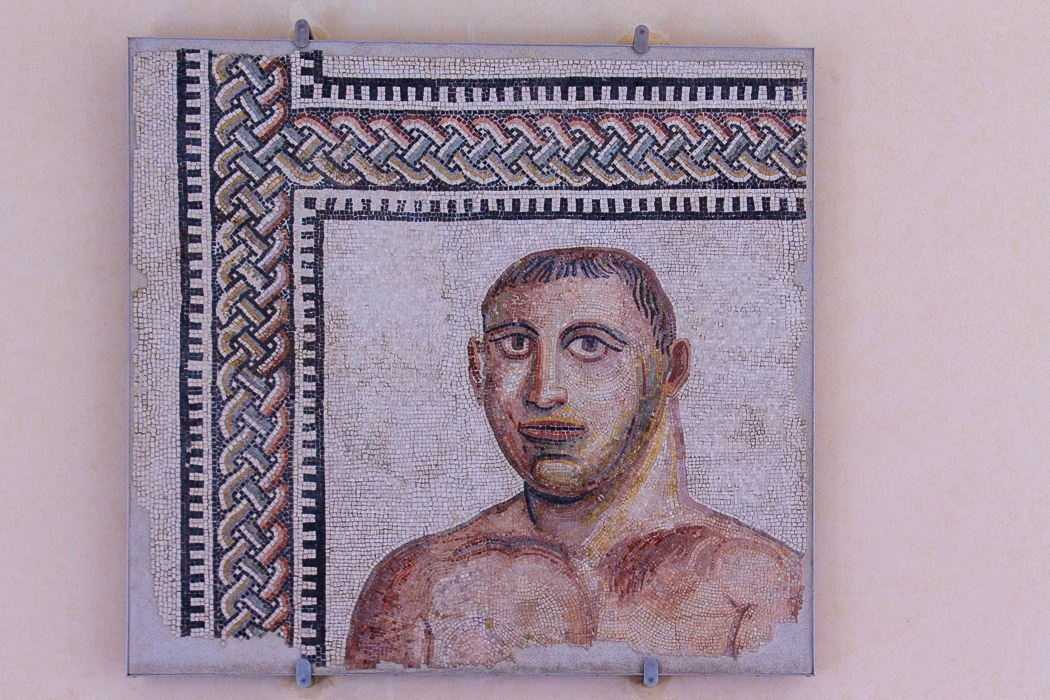
Another part of the museum is outdoors, Michelangelo's Cloister, so named because Michelangelo did at least the preliminary design of this cloister for the Church of Madonna degli Angeli before his death in 1564. The 1st photo below gives perhaps the best overview of the square cloister, and following photos show some more detailed views. The porticoes on the four sides contain sculptures, sarcophagi, and statue bases.
The center of the cloister has a fountain (1st photo below) surrounded by colossal heads of 7 animals (a Ram, an Elephant, a Rhinoceros, a Camel, a Horse, a Bull and an Ox) which were found in 1586 in an place suggesting they were originally inside the no-longer-existing Temple of Divine Trajan, in Trajan's Forum, except for the Rhino and Elephant heads which were carved during the Renaissance period. In 1878 the heads were moved to the Roman College, and they were moved in the early 1900s to the Michelangelo Cloister, circling the fountain of the garden which was built in 1695.
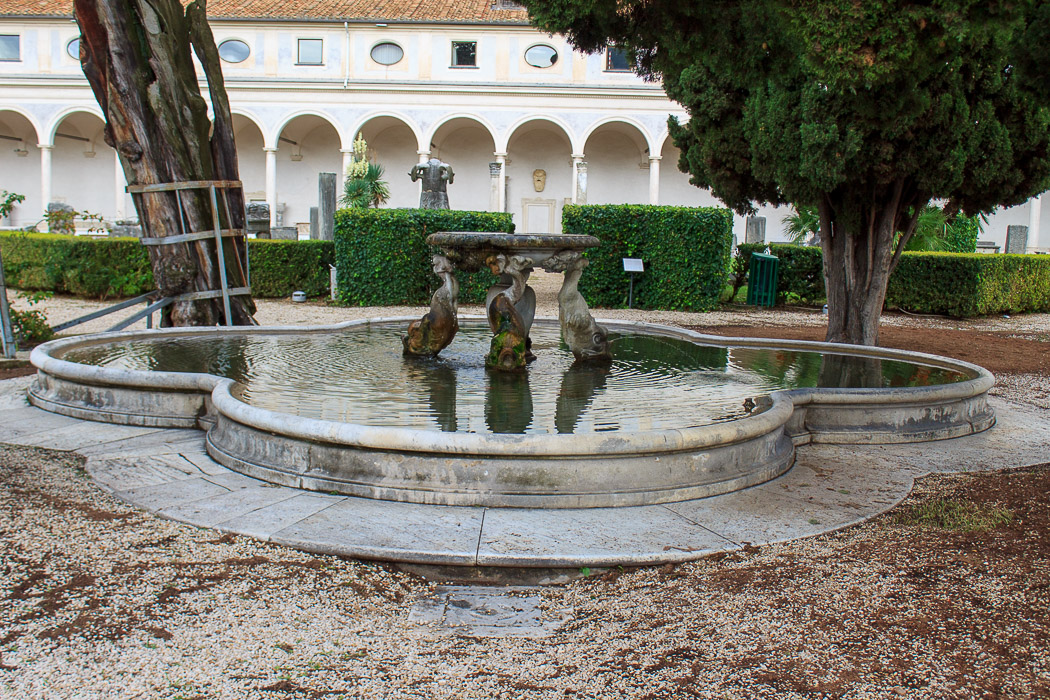
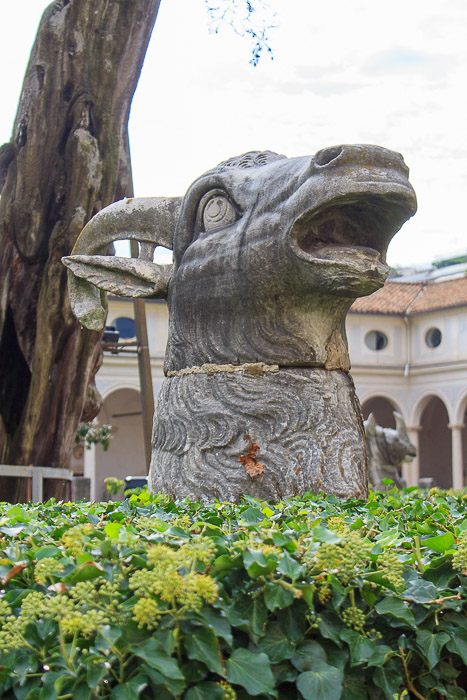
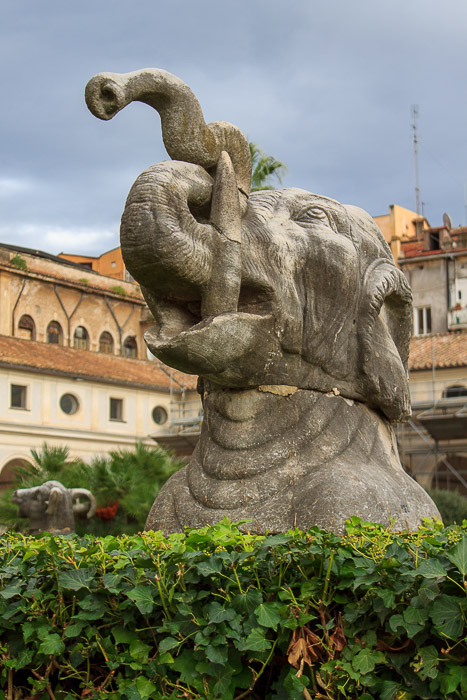
IMG_1505-20131005: Elephant Head, originally from inside the Temple of Divine Trajan, now in the center of the Michelangelo Cloister of the National Museum of Rome, Terme di Diocleziano (Baths of Diocletian)
See all
National Museum of Rome - Terme di Diocleziano photos.
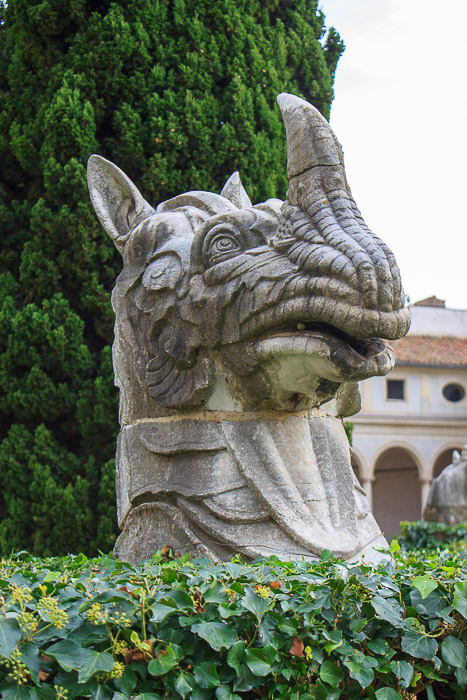
IMG_1506-20131005: Rhinoceros Head, originally from inside the Temple of Divine Trajan, now in the center of the Michelangelo Cloister of the National Museum of Rome, Terme di Diocleziano (Baths of Diocletian)
See all
National Museum of Rome - Terme di Diocleziano photos.
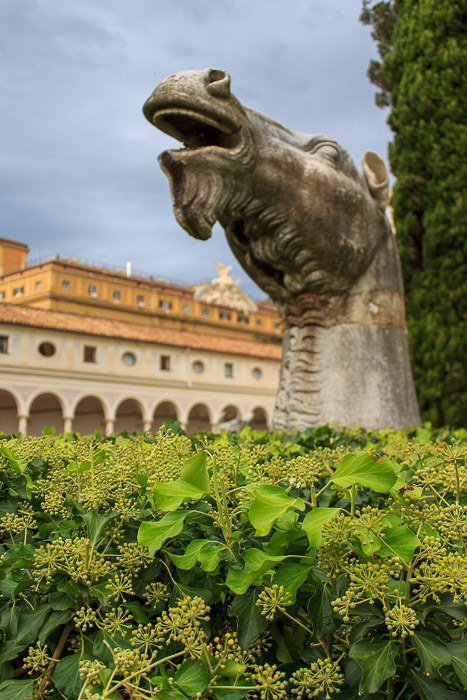
IMG_1502-20131005: Camel Head, originally from inside the Temple of Divine Trajan, now in the center of the Michelangelo Cloister of the National Museum of Rome, Terme di Diocleziano (Baths of Diocletian)
See all
National Museum of Rome - Terme di Diocleziano photos.
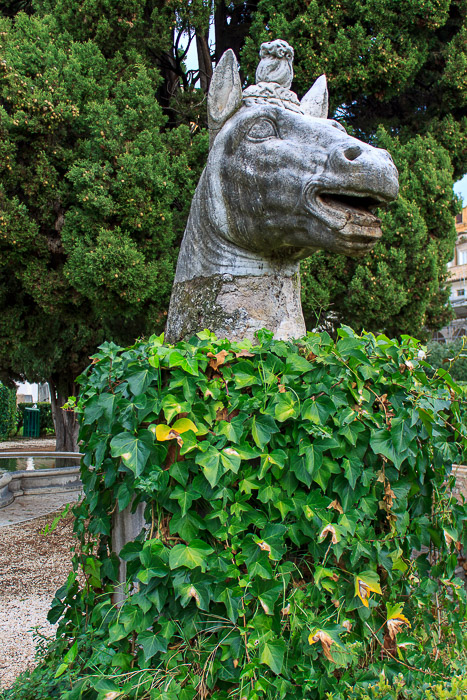
IMG_1501-20131005: Horse Head, originally from inside the Temple of Divine Trajan, now in the center of the Michelangelo Cloister of the National Museum of Rome, Terme di Diocleziano (Baths of Diocletian)
See all
National Museum of Rome - Terme di Diocleziano photos.
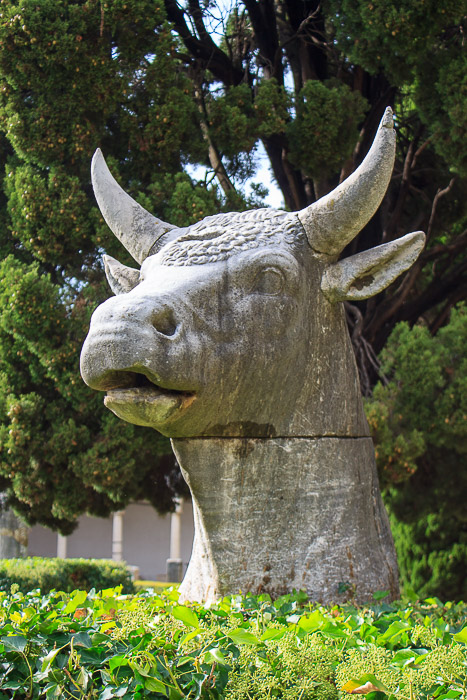
IMG_1510-20131005: Bull Head, originally from inside the Temple of Divine Trajan, now in the center of the Michelangelo Cloister of the National Museum of Rome, Terme di Diocleziano (Baths of Diocletian)
See all
National Museum of Rome - Terme di Diocleziano photos.
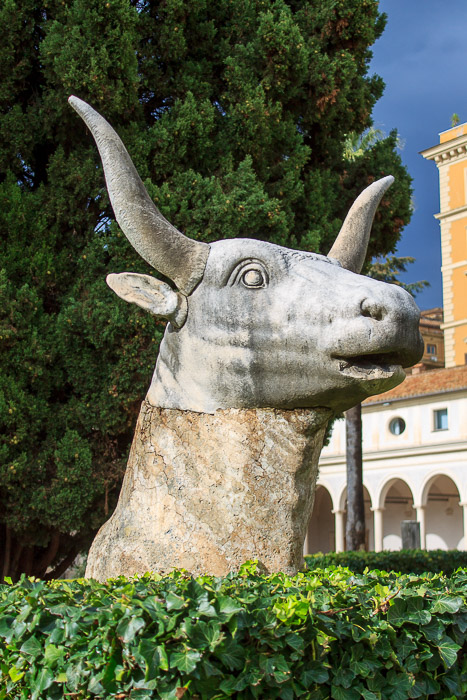
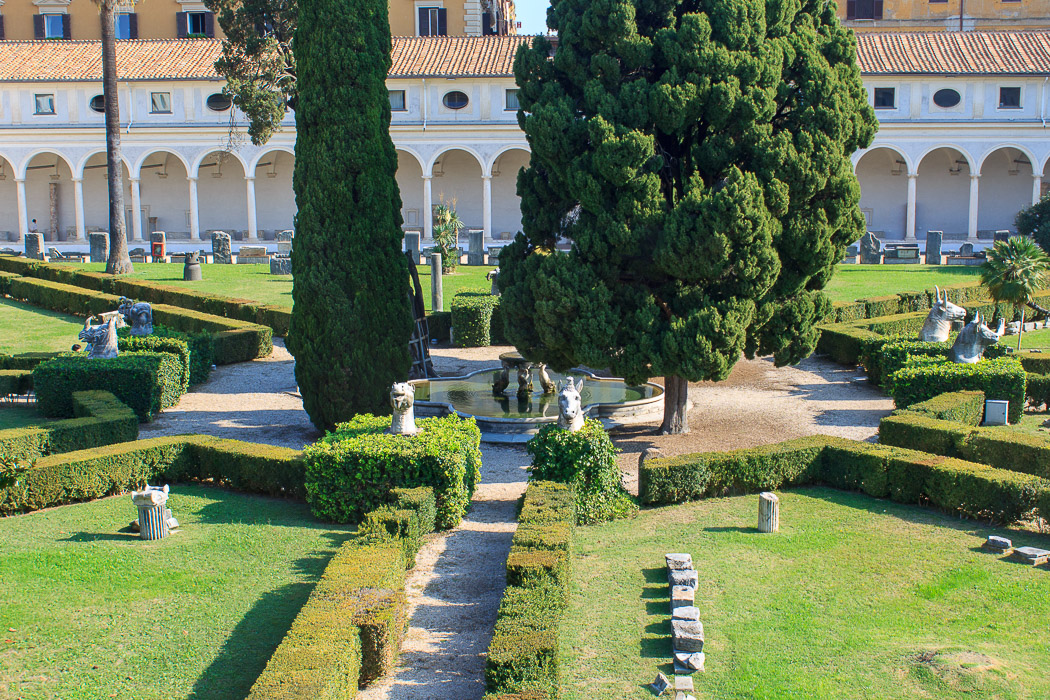
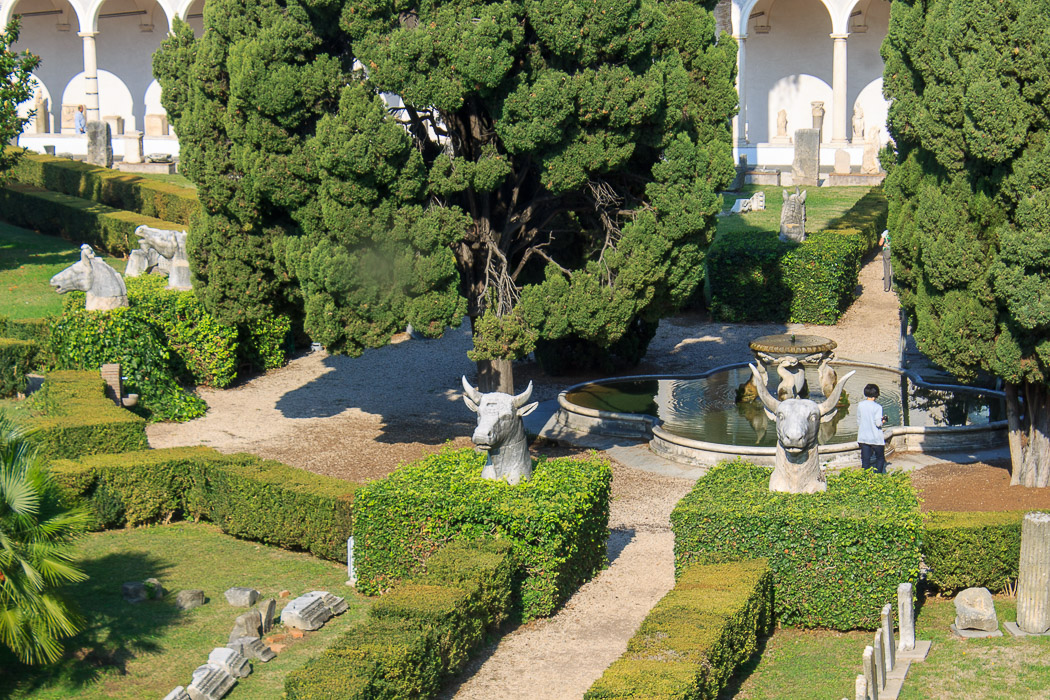
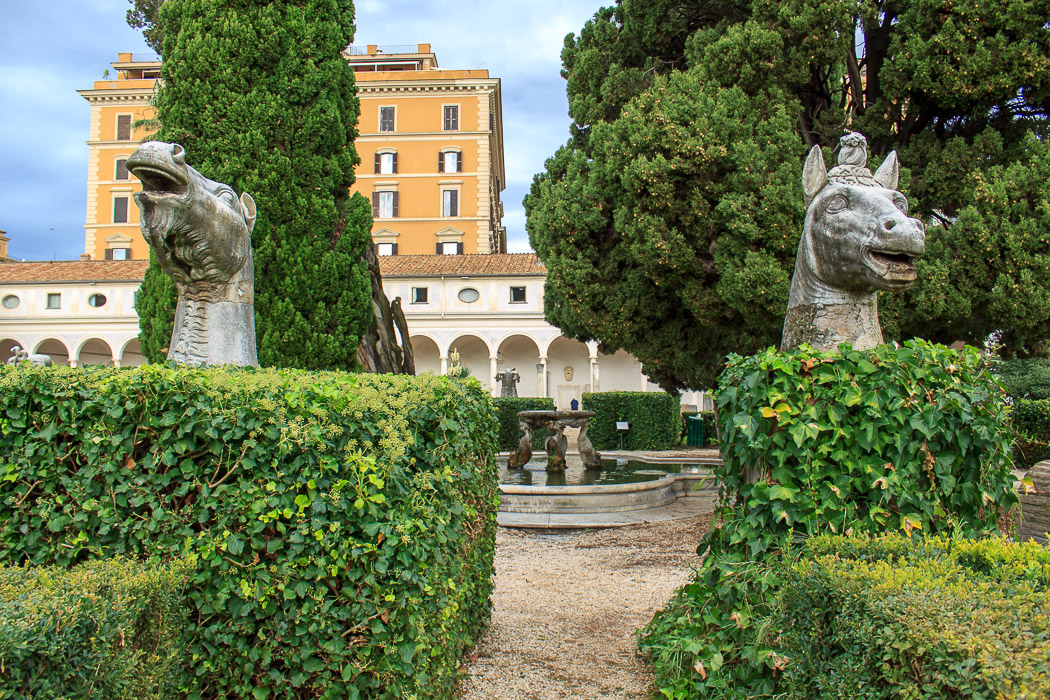
IMG_1499-20131005: Camel Head and Horse Head, originally from inside the Temple of Divine Trajan, now in the center of the Michelangelo Cloister of the National Museum of Rome, Terme di Diocleziano (Baths of Diocletian)
See all
National Museum of Rome - Terme di Diocleziano photos.
On the upper floor of the arcades Michelangelo's Cloister is a Museum of Prehistory which I didn't find interesting or photograph.
There is also a Small Cloister next to the Michelangelo Cloister. The small cloister of the charterhouse occupies around a third of the area previously occupied by the natatio (swimming pool) of the Baths of Diocletian. It was originally built alongside the church. Construction began in the mid-16th century but continued beyond the 17th century. The late 16th-century travertine well in the centre was added during the recent renovation of the cloister.
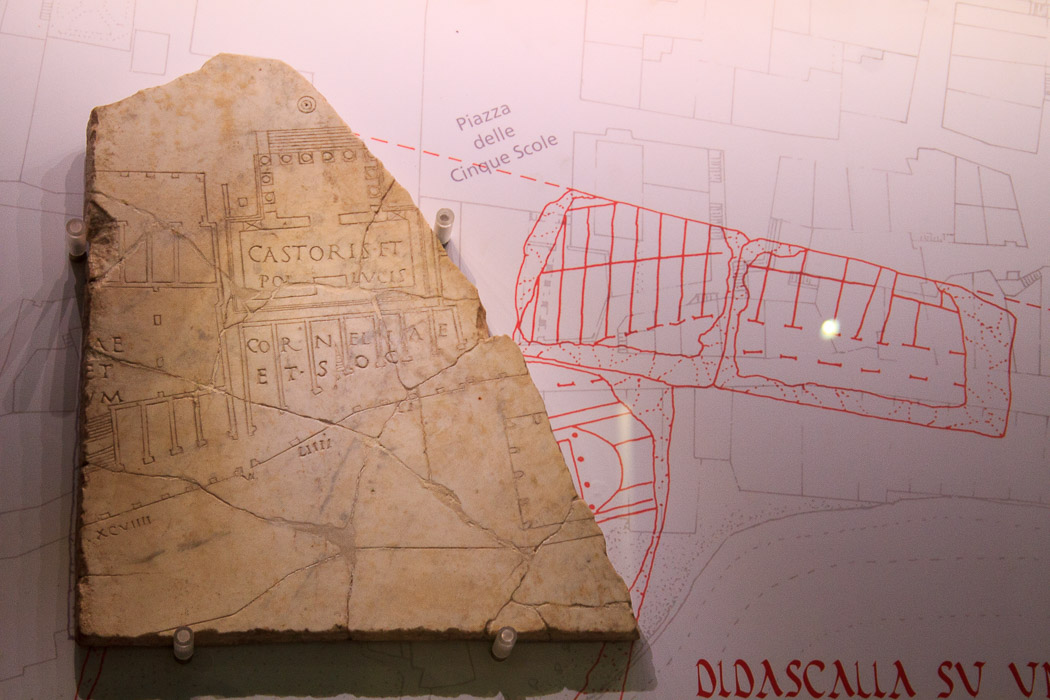
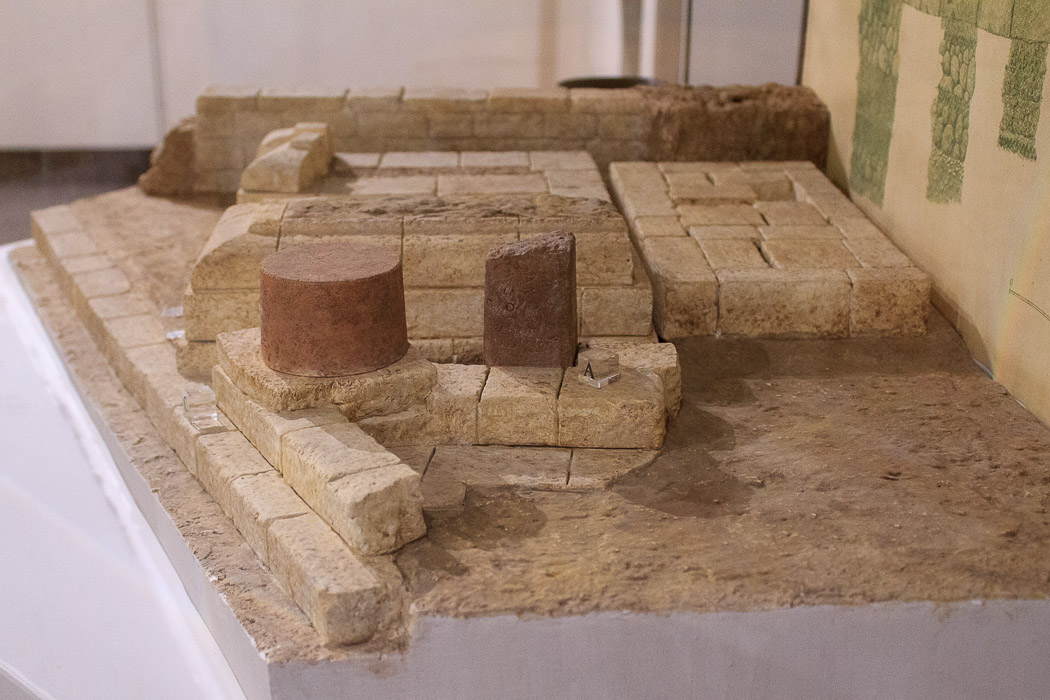
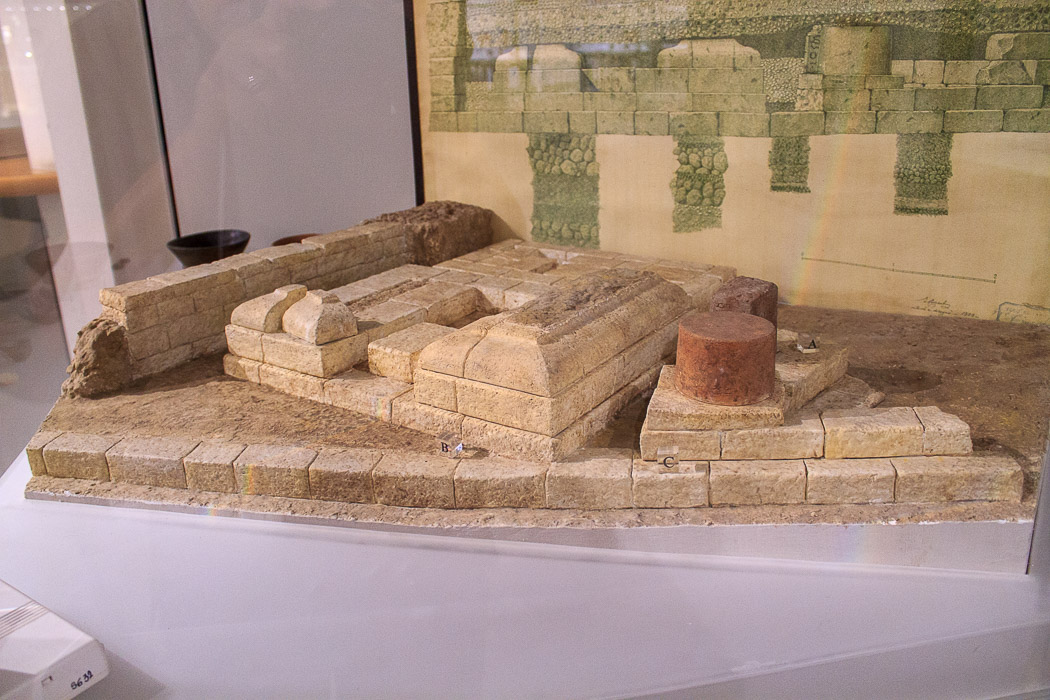
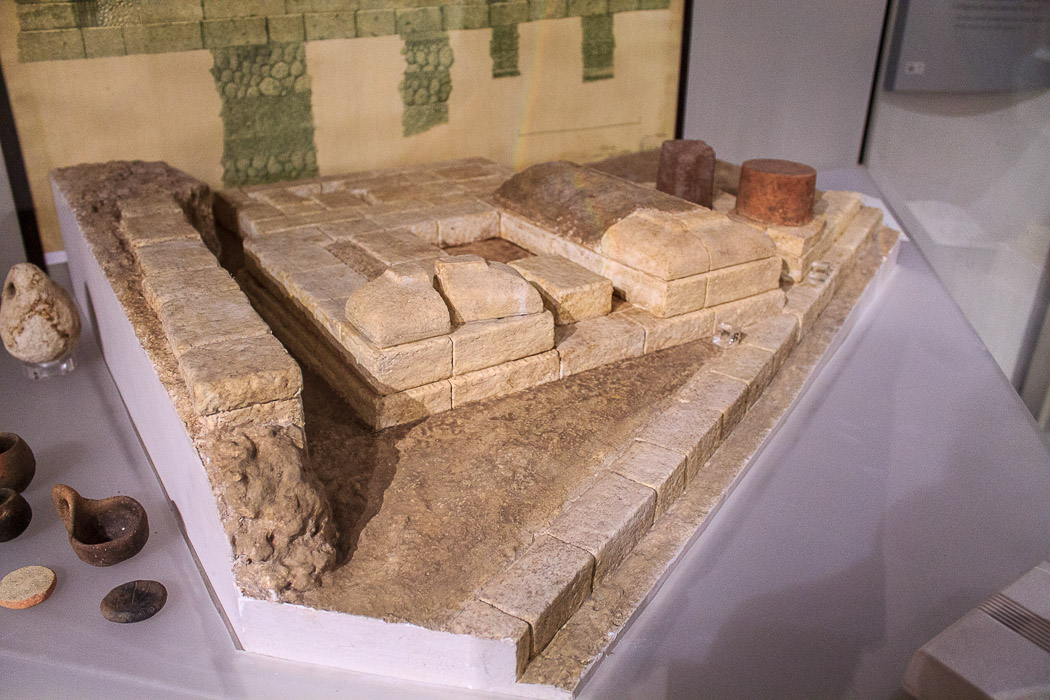
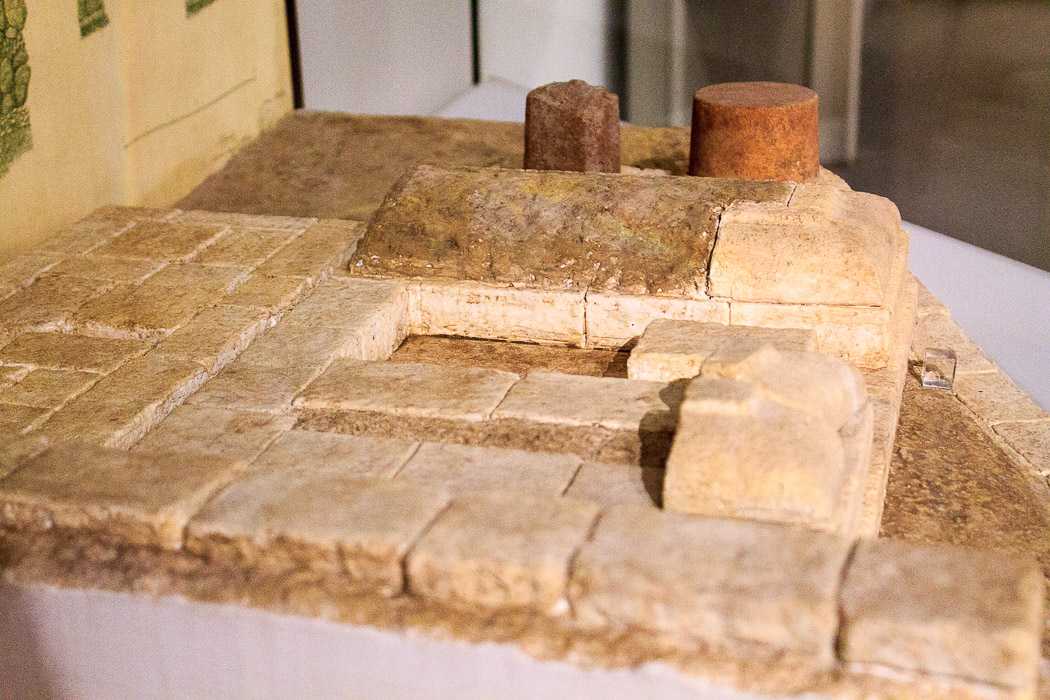
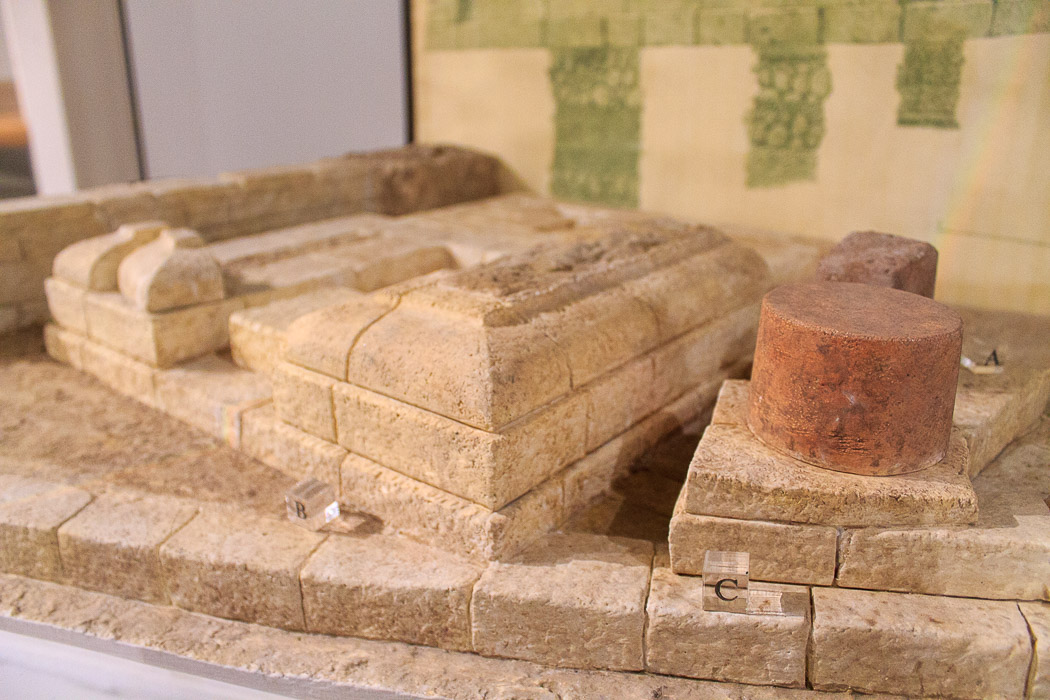
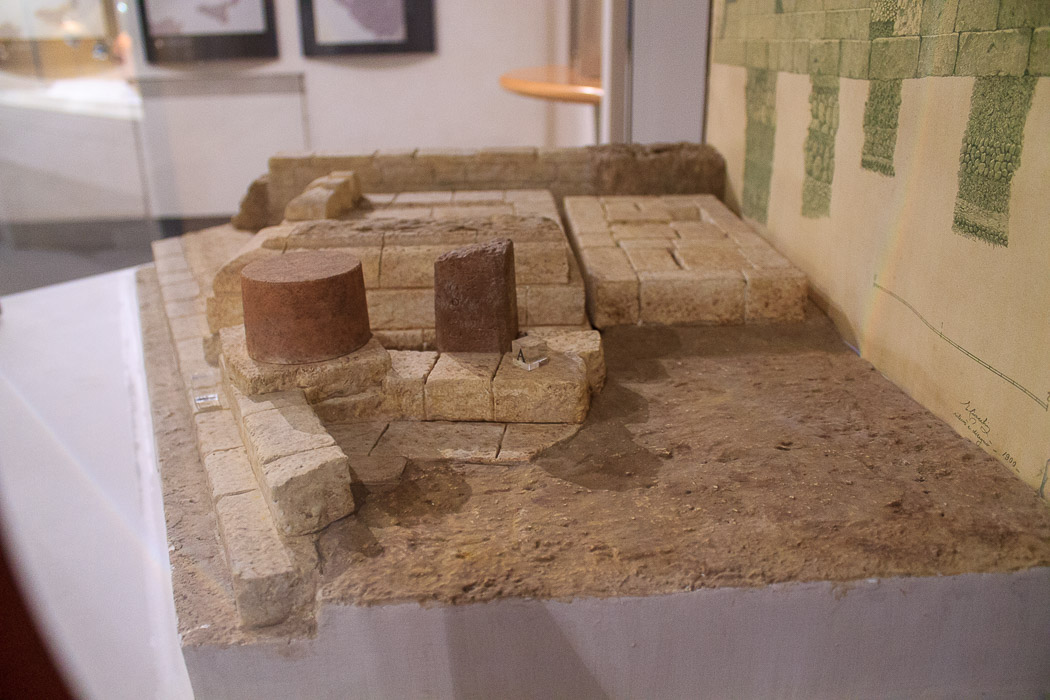
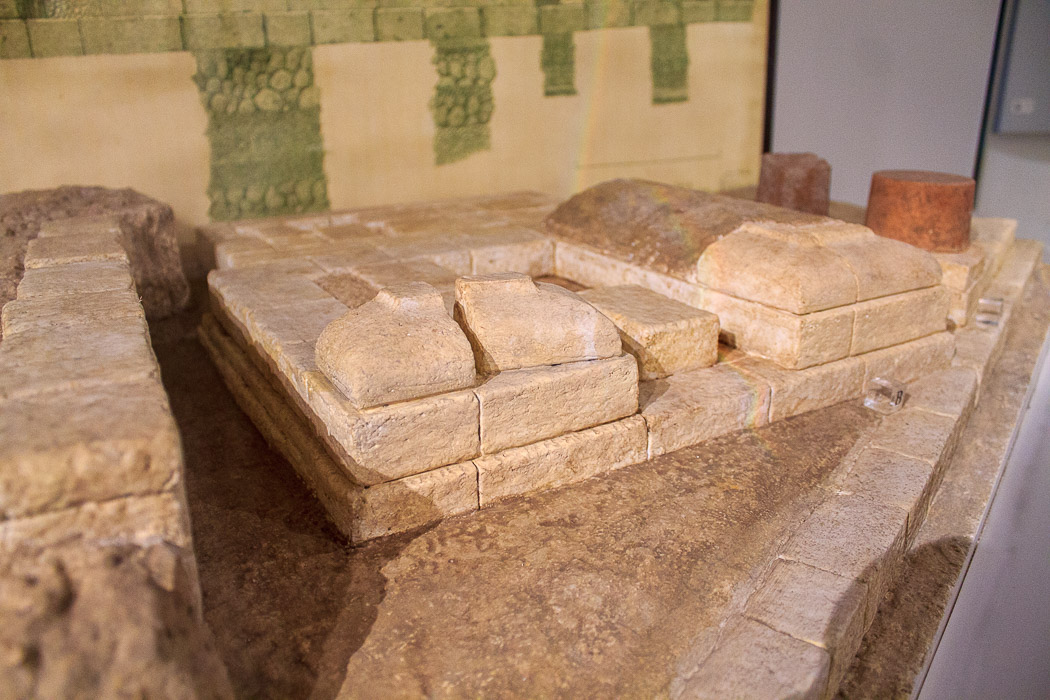
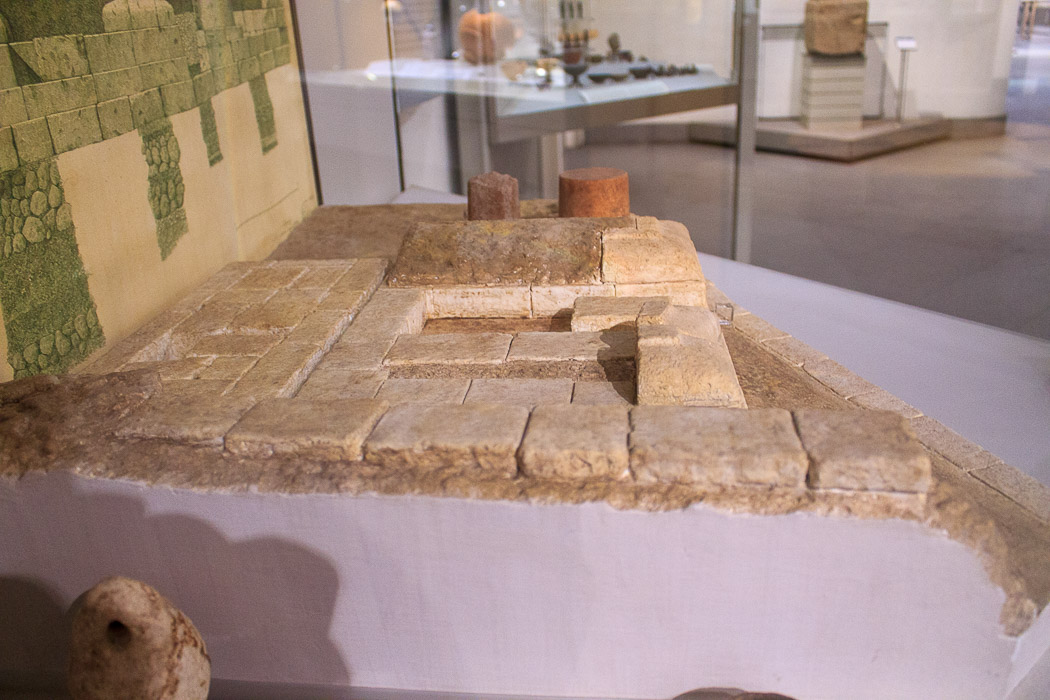
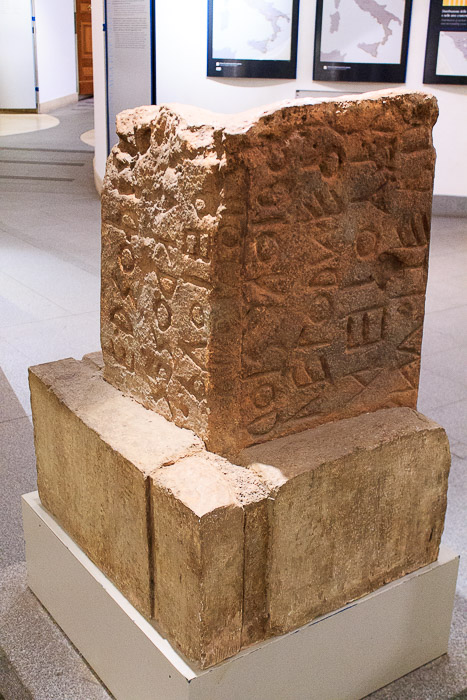
IMG_1515-20131005: A cast of a Cippus (engraved tombstone) from the 6th century BC, found in the Volcanal, beneath the Comitium, in front of the Curia in the Roman Forum, in the National Museum of Rome, Terme di Diocleziano (Baths of Diocletian)
See all
National Museum of Rome - Terme di Diocleziano photos.
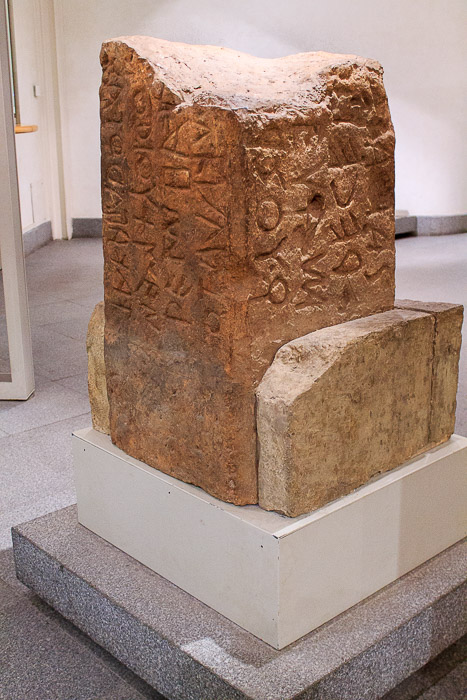
IMG_1516-20131005: A cast of a Cippus (engraved tombstone) from the 6th century BC, found in the Volcanal, beneath the Comitium, in front of the Curia in the Roman Forum, in the National Museum of Rome, Terme di Diocleziano (Baths of Diocletian)
See all
National Museum of Rome - Terme di Diocleziano photos.
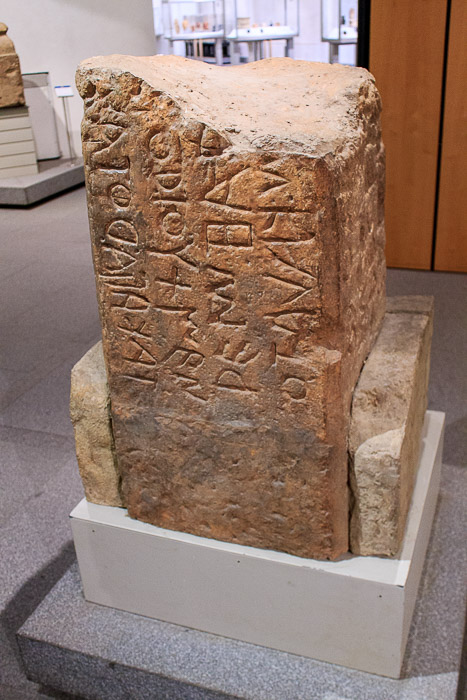
IMG_7760-20141007: A cast of a Cippus (engraved tombstone) from the 6th century BC, found in the Volcanal, beneath the Comitium, in front of the Curia in the Roman Forum, in the National Museum of Rome, Terme di Diocleziano (Baths of Diocletian)
See all
National Museum of Rome - Terme di Diocleziano photos.
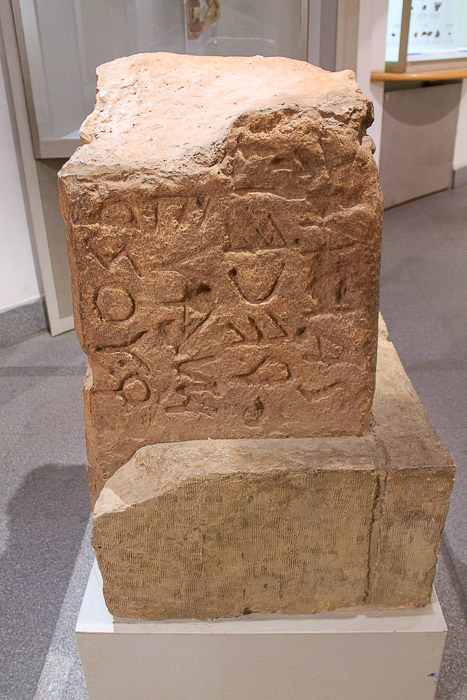
IMG_7761-20141007: A cast of a Cippus (engraved tombstone) from the 6th century BC, found in the Volcanal, beneath the Comitium, in front of the Curia in the Roman Forum, in the National Museum of Rome, Terme di Diocleziano (Baths of Diocletian)
See all
National Museum of Rome - Terme di Diocleziano photos.
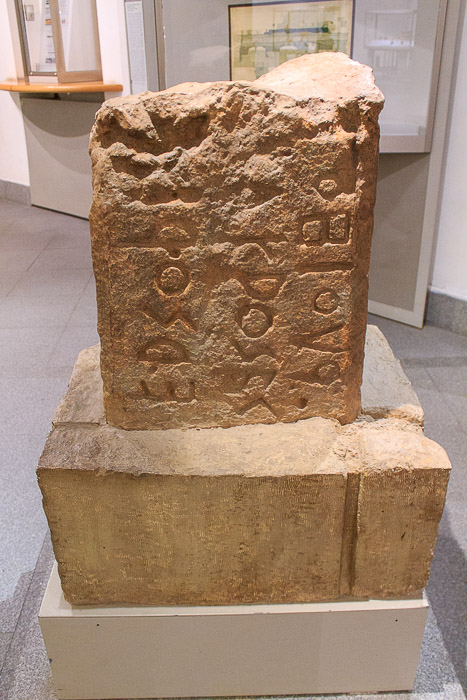
IMG_7762-20141007: A cast of a Cippus (engraved tombstone) from the 6th century BC, found in the Volcanal, beneath the Comitium, in front of the Curia in the Roman Forum, in the National Museum of Rome, Terme di Diocleziano (Baths of Diocletian)
See all
National Museum of Rome - Terme di Diocleziano photos.
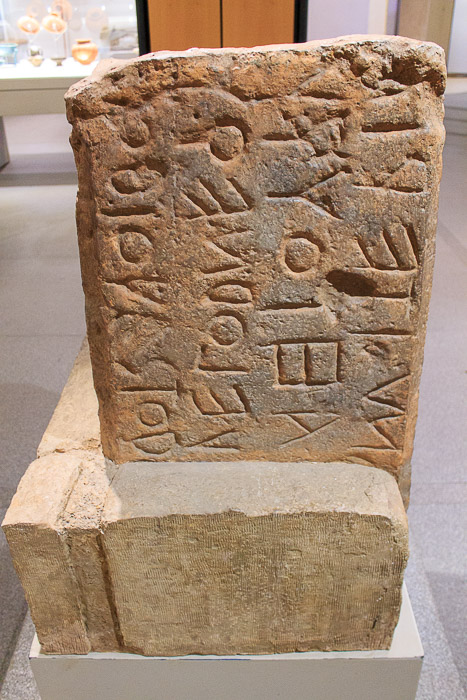
IMG_7763-20141007: A cast of a Cippus (engraved tombstone) from the 6th century BC, found in the Volcanal, beneath the Comitium, in front of the Curia in the Roman Forum, in the National Museum of Rome, Terme di Diocleziano (Baths of Diocletian)
See all
National Museum of Rome - Terme di Diocleziano photos.
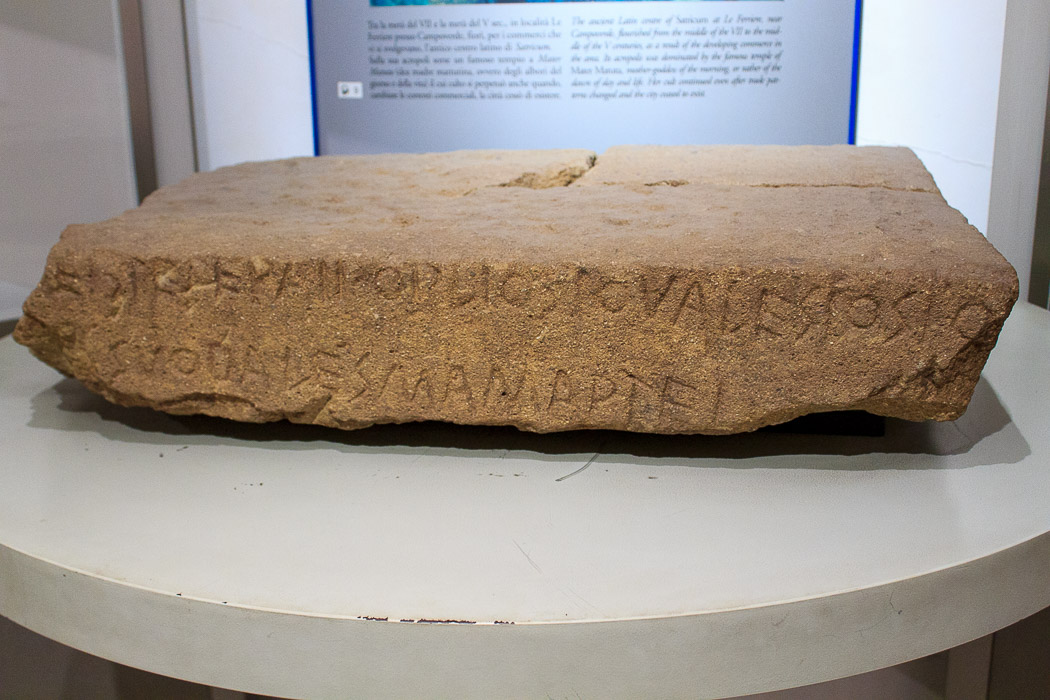
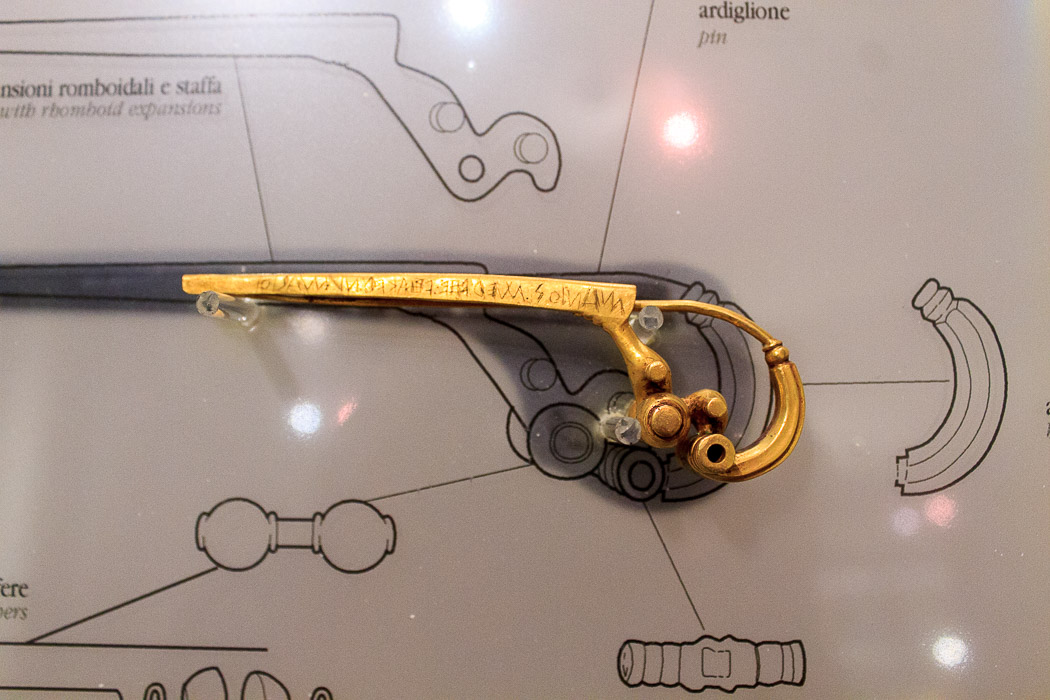
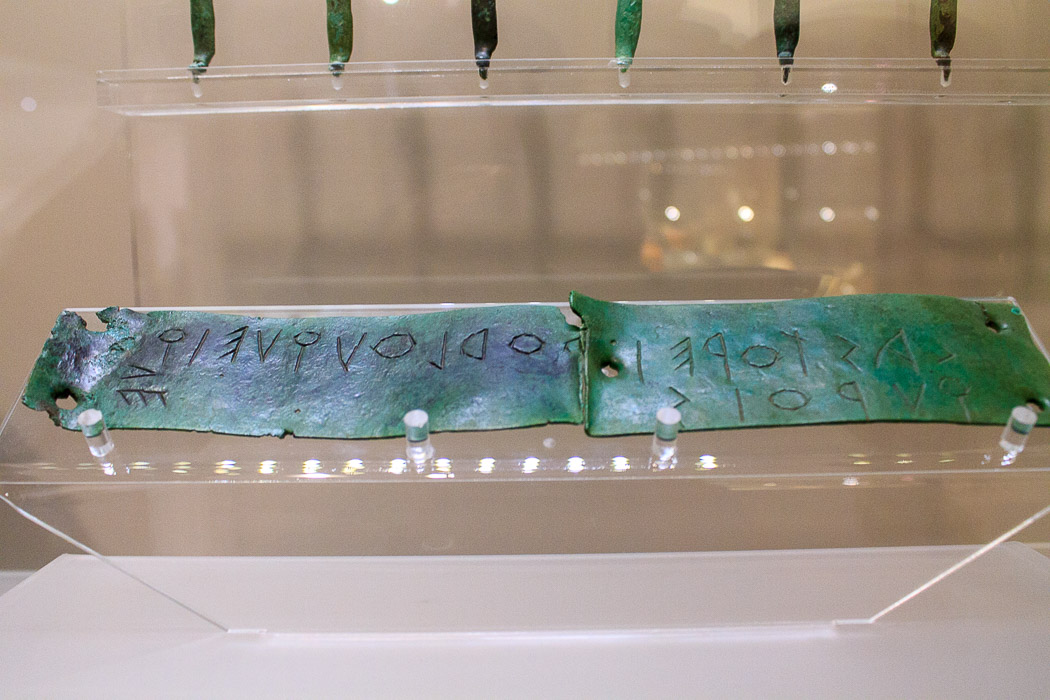
IMG_0190-20141012: Dedication to the Dioscuri (Castor and Pollux, twin sons of Zeus) from the Sanctuary of Thirteen Altars ad Lavinium, during the second half of the 6th century BC, in the National Museum of Rome, Terme di Diocleziano (Baths of Diocletian). This is the oldest evidence in Latium of the cult of the twins, called Castores by the Romans. In 484 BC a temple to them was built in the Roman Forum.
See all
National Museum of Rome - Terme di Diocleziano photos.
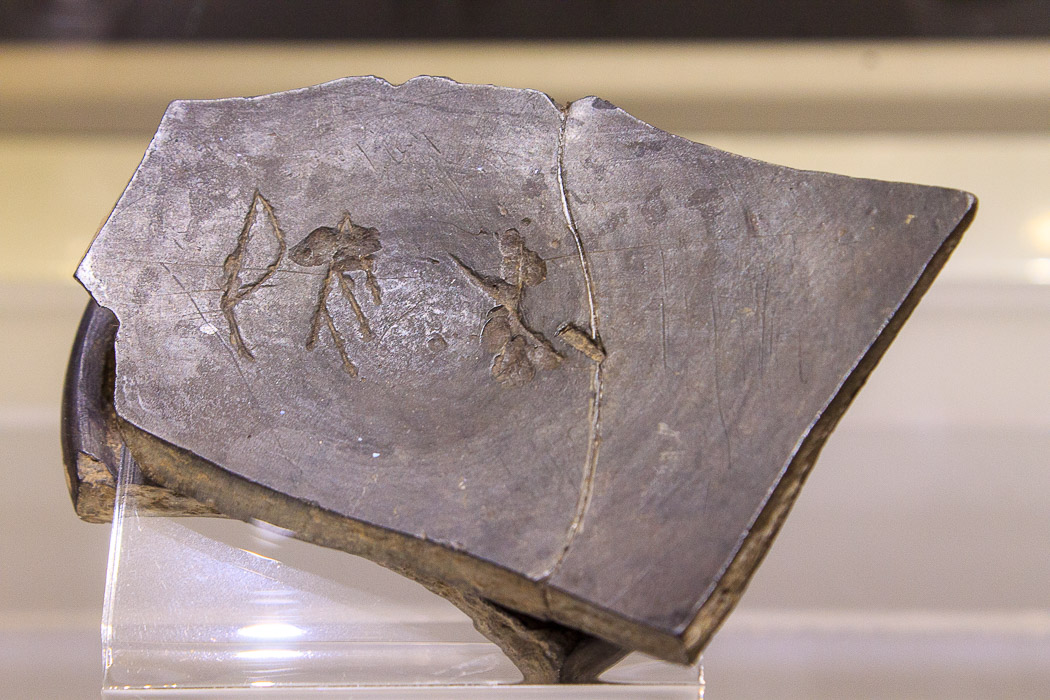
IMG_0196-20141012: The inscription, rex, on this fragment of a cup, indicates the owner was one of the last kings of Rome, or the rex sacrorum, the priest who took over the king's sacred functions after the establishment of the Republic, found in the Regia of the Roman Forum, from the end of the 6th century BC, now in the National Museum of Rome, Terme di Diocleziano (Baths of Diocletian)
See all
National Museum of Rome - Terme di Diocleziano photos.

IMG_0198-20141012: A marble basin, now in the National Museum of Rome, Terme di Diocleziano (Baths of Diocletian), used as a fountain at the Temple of Hercules at Borgo San Giovanni near Lavunium is inscribed on the lip using letters incised and then infilled with bronze - prehaps the most ancient known example of this technique - reading that the aedilis L. Scantius had this basin made, and also made provision for the water supply to the temple
See all
National Museum of Rome - Terme di Diocleziano photos.
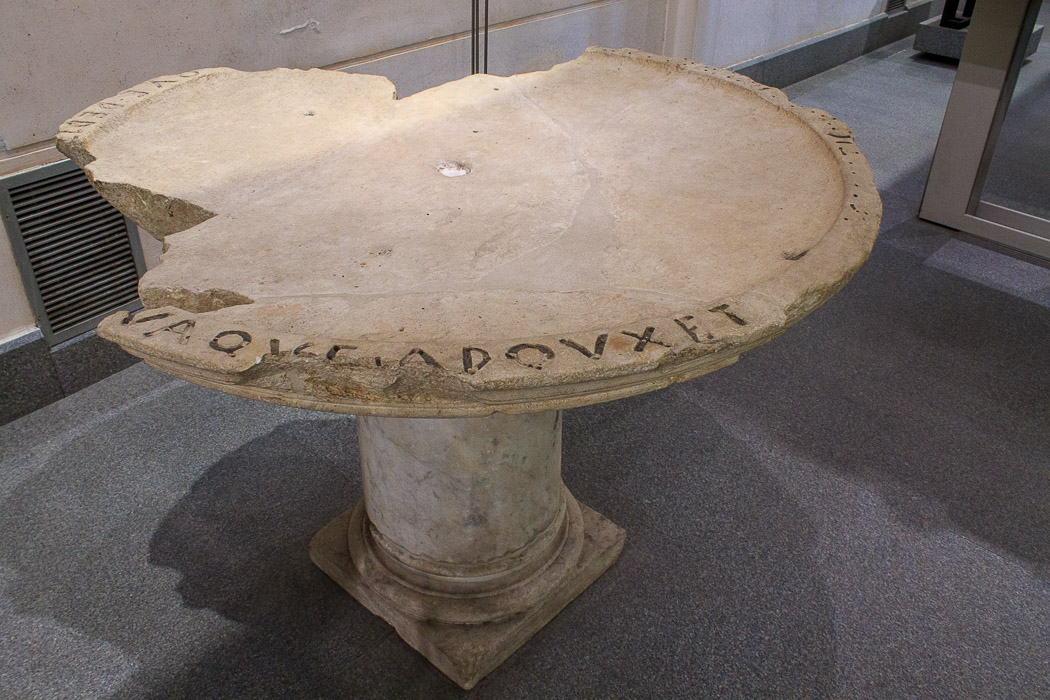
IMG_0199-20141012: A marble basin, now in the National Museum of Rome, Terme di Diocleziano (Baths of Diocletian), used as a fountain at the Temple of Hercules at Borgo San Giovanni near Lavunium is inscribed on the lip using letters incised and then infilled with bronze - prehaps the most ancient known example of this technique - reading that the aedilis L. Scantius had this basin made, and also made provision for the water supply to the temple
See all
National Museum of Rome - Terme di Diocleziano photos.
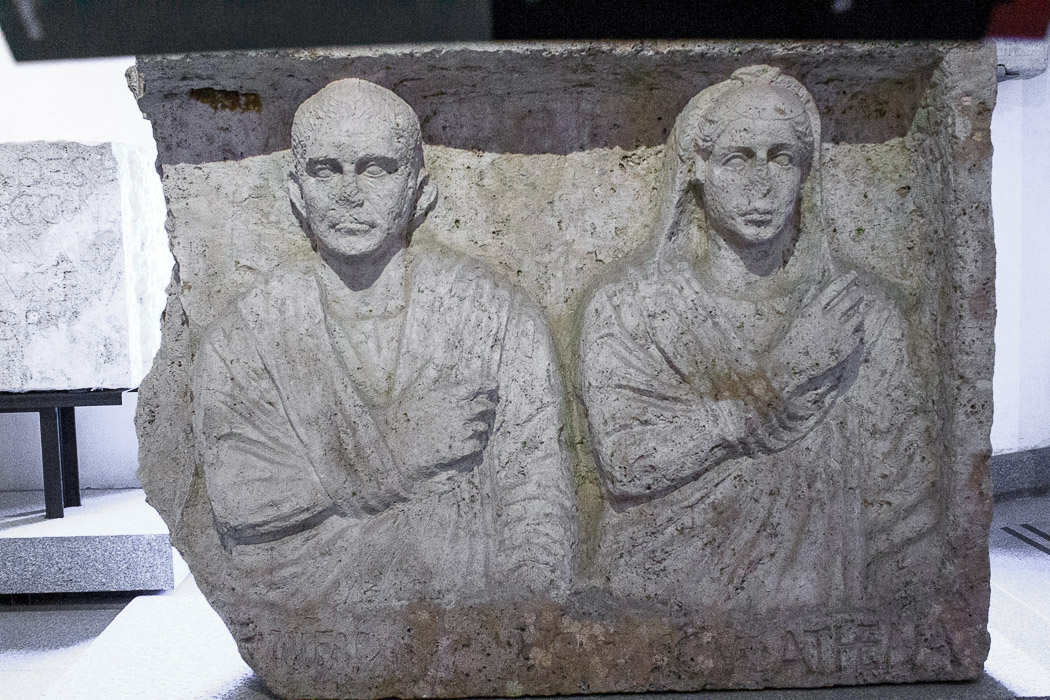
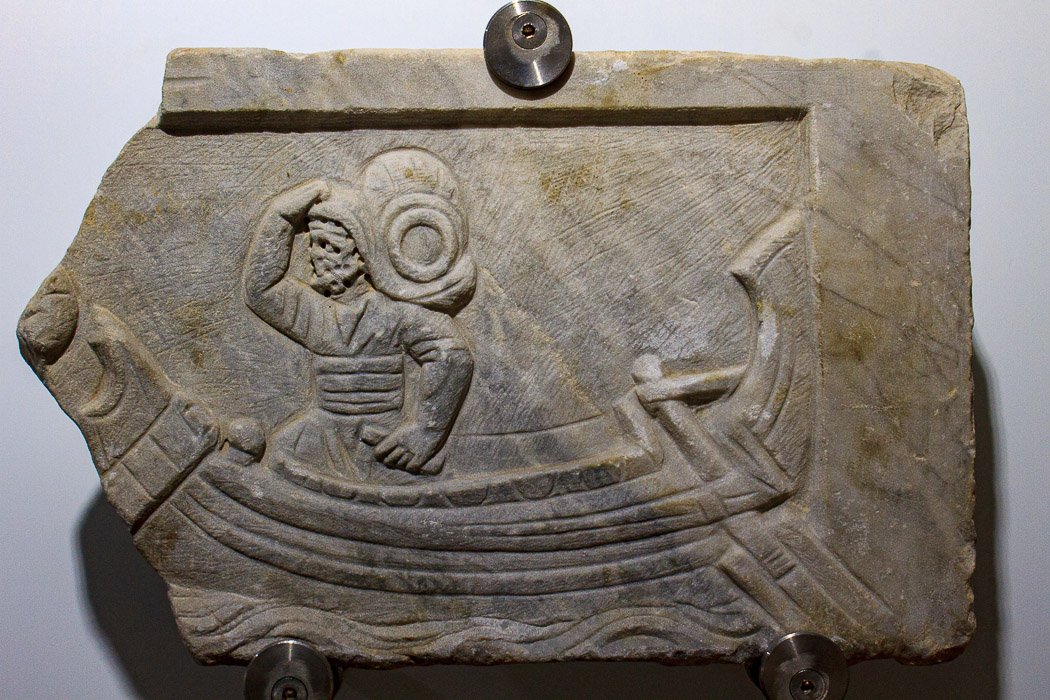
IMG_0203-20141012: In this frieze from the 3rd century AD in the National Museum of Rome, Terme di Diocleziano (Baths of Diocletian), a dockworker is unloading food supplies from a boat in Ostia. He is holding a barrel on his shoulder, and the permit to unload foodstuffs in a scroll in his right hand. In Ostia, little boats were iindispensible for unloading ships since the harbor was too shallow for large ships to enter.
See all
National Museum of Rome - Terme di Diocleziano photos.
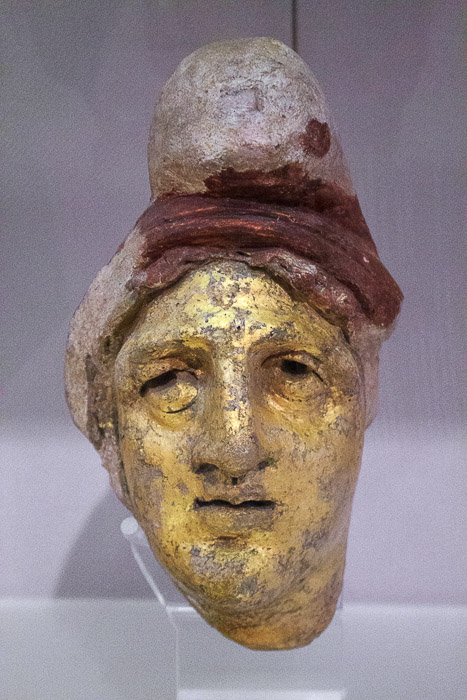
IMG_1485-20131005: Statue from the Mithraeum of the Castra Peregrinorum under the church of St Stefano Rotondo on the Celian Hill, now in Hall IX of the National Museum of Rome, Terme di Diocleziano (Baths of Diocletian)
See all
National Museum of Rome - Terme di Diocleziano photos.
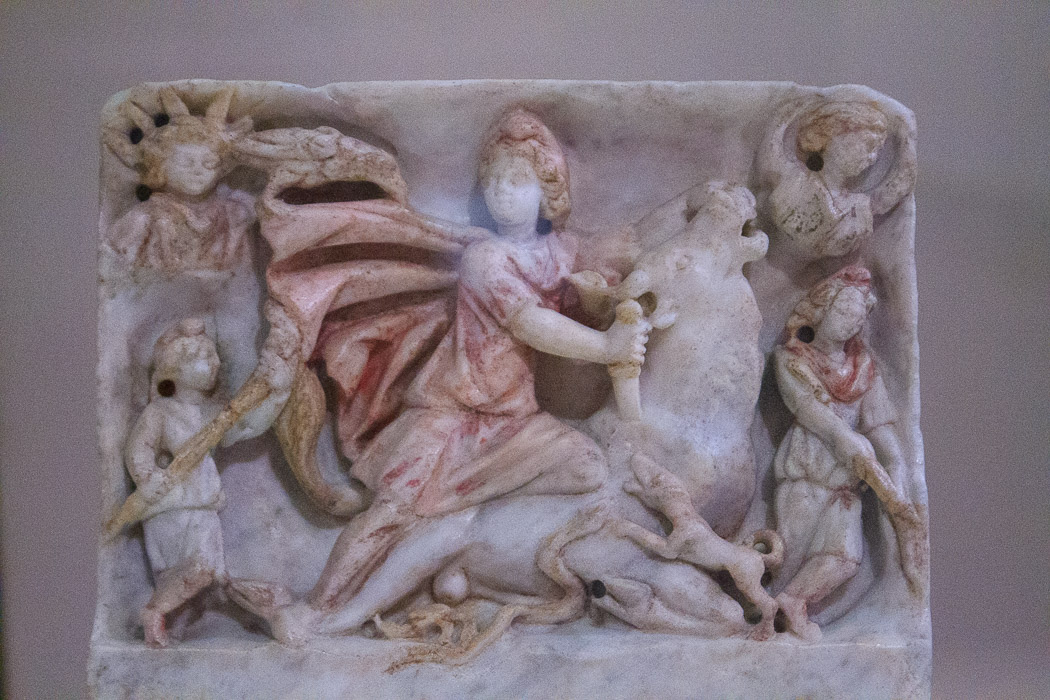
IMG_1486-20131005: Relief from the Mithraeum of the Castra Peregrinorum under the church of St Stefano Rotondo on the Celian Hill, now in Hall IX of the National Museum of Rome, Terme di Diocleziano (Baths of Diocletian)
See all
National Museum of Rome - Terme di Diocleziano photos.
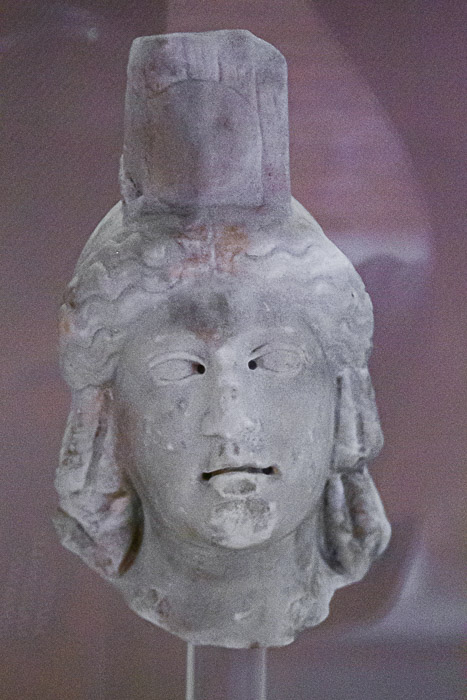
IMG_1487-20131005: Statue from the Mithraeum of the Castra Peregrinorum under the church of St Stefano Rotondo on the Celian Hill, now in Hall IX of the National Museum of Rome, Terme di Diocleziano (Baths of Diocletian)
See all
National Museum of Rome - Terme di Diocleziano photos.
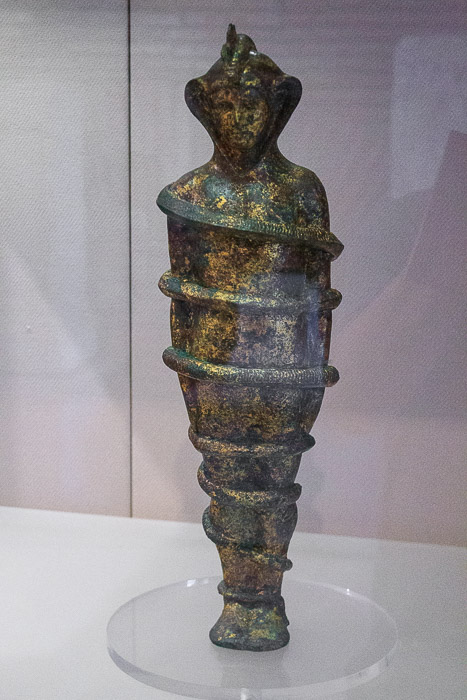
IMG_1488-20131005: The gold-plated bronze statuette represents a veiled male figure wrapped in snake coils. The statue, an oriental deity not precisely identified, was found sealed in a ritual burial pit inside an altar together with offerings such as eggs, seeds and flowers. On the occasion of the annual ceremonies the statuette was extracted, exposed to the followers and re-buried to symbolize death and rebirth of the god, patron of the endless cycles of nature, and promise of resurrection. Found on the Syrian Sanctuary of the Janiculum Hill, from the mid-4th century AD, now in Hall IX of the National Museum of Rome, Terme di Diocleziano (Baths of Diocletian)
See all
National Museum of Rome - Terme di Diocleziano photos.
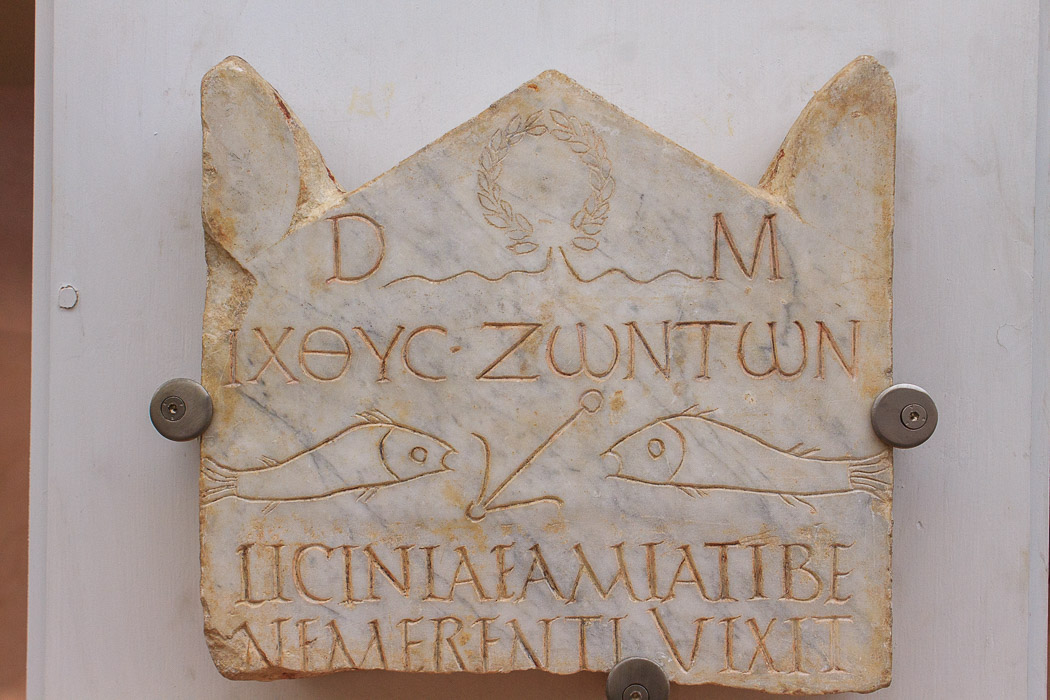
IMG_7808-20141007: The funeral stele of Licinia Amias contains one of the most ancient Christian inscriptions in Rome, translated as 'fish of the living' with the word fish being an acrostic of the name of Jesus Christ, and the second term connected with salvation, in Hall IX of the National Museum of Rome, Terme di Diocleziano (Baths of Diocletian)
See all
National Museum of Rome - Terme di Diocleziano photos.
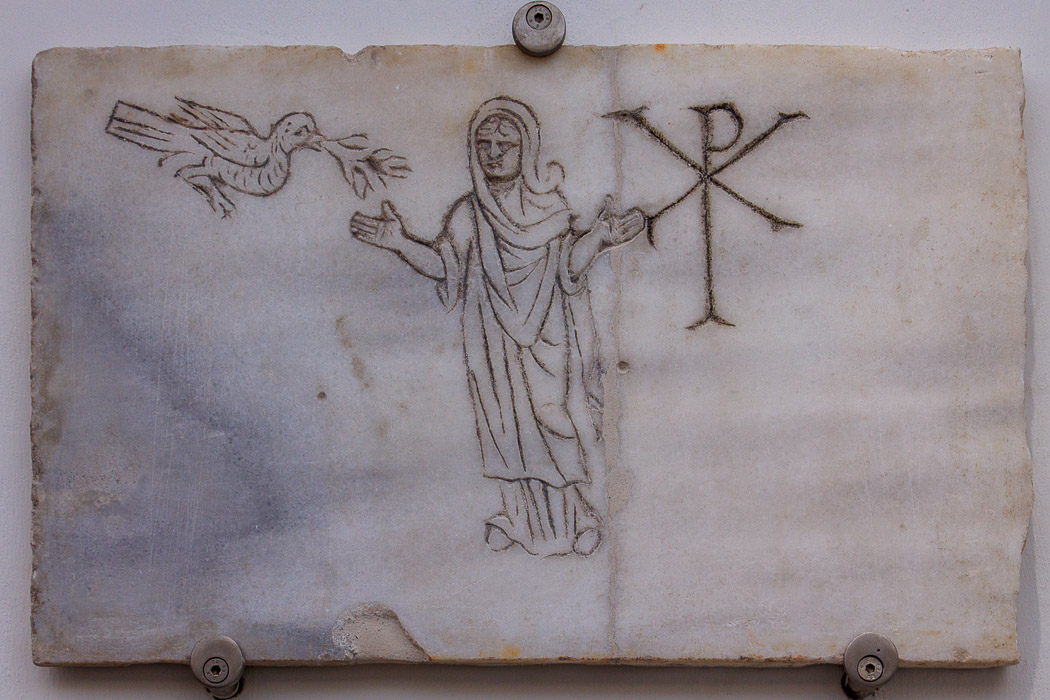
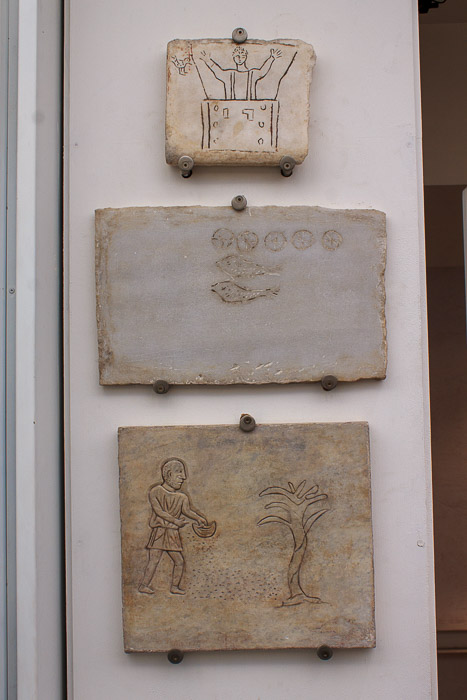
IMG_7810-20141007: Early Christian symbols in Rome, in Hall IX of the National Museum of Rome, Terme di Diocleziano (Baths of Diocletian). The top one is a slab carved with the scene of Noah on the Ark, taken from Genesis.
See all
National Museum of Rome - Terme di Diocleziano photos.
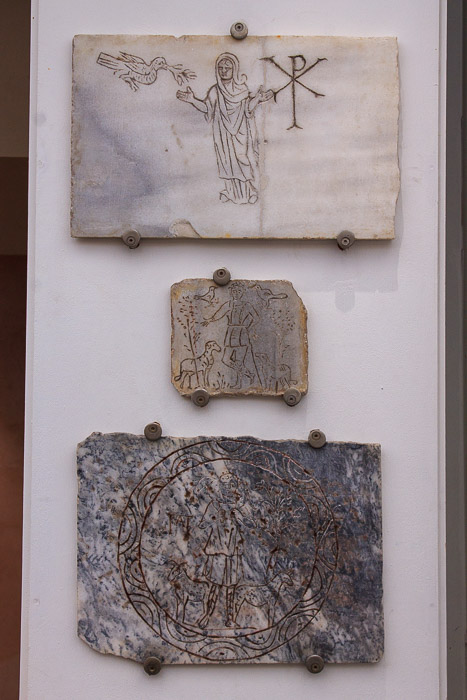
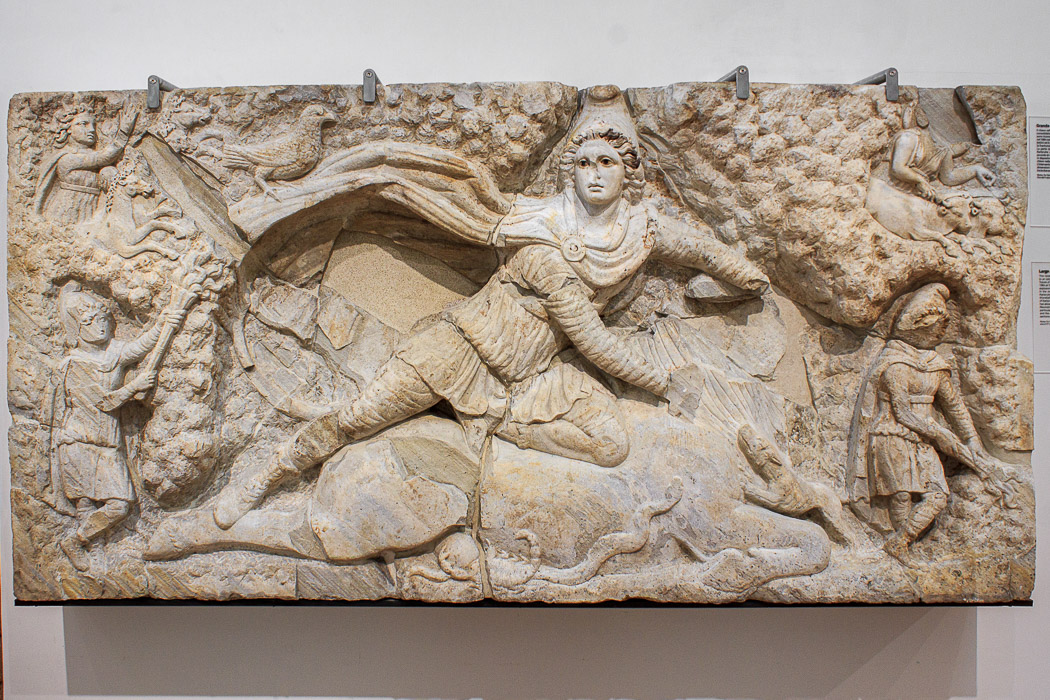
IMG_7813-20141007: Large marble relief of Mithras, illustrating the slaying of the bull inside a grotto, from the late 2nd or early 3rd century AD, in Hall IX of the National Museum of Rome, Terme di Diocleziano (Baths of Diocletian). The relief was found in 1964 at Tor Cervara, broken into at least 50 pieces by explosion of a WWII piece of ordnance. The deity's head had ended up in the Karlsruhe Museum in Germany, but the museum returned the fragment so the relief could be reconstructed in its entirety.
See all
National Museum of Rome - Terme di Diocleziano photos.
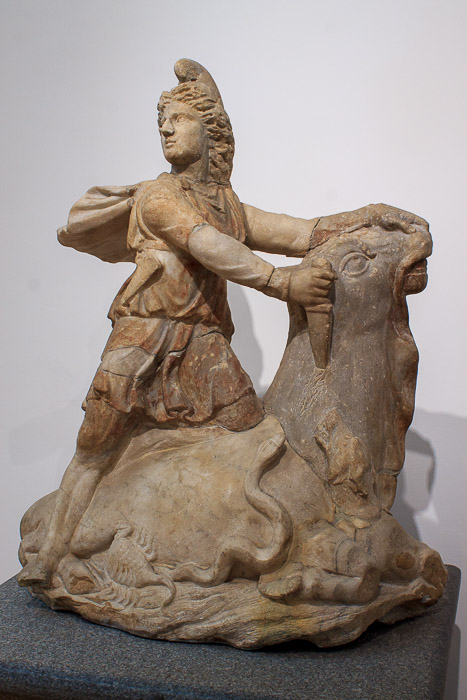
IMG_7815-20141007: Statue of Mithras siezing the bull by the nostrils and thrusting a knife into its neck, while a dog licks the blood gushing from the wound and a scorpion chops off the bull's testicles, from the 4th century AD, in Hall IX of the National Museum of Rome, Terme di Diocleziano (Baths of Diocletian)
See all
National Museum of Rome - Terme di Diocleziano photos.
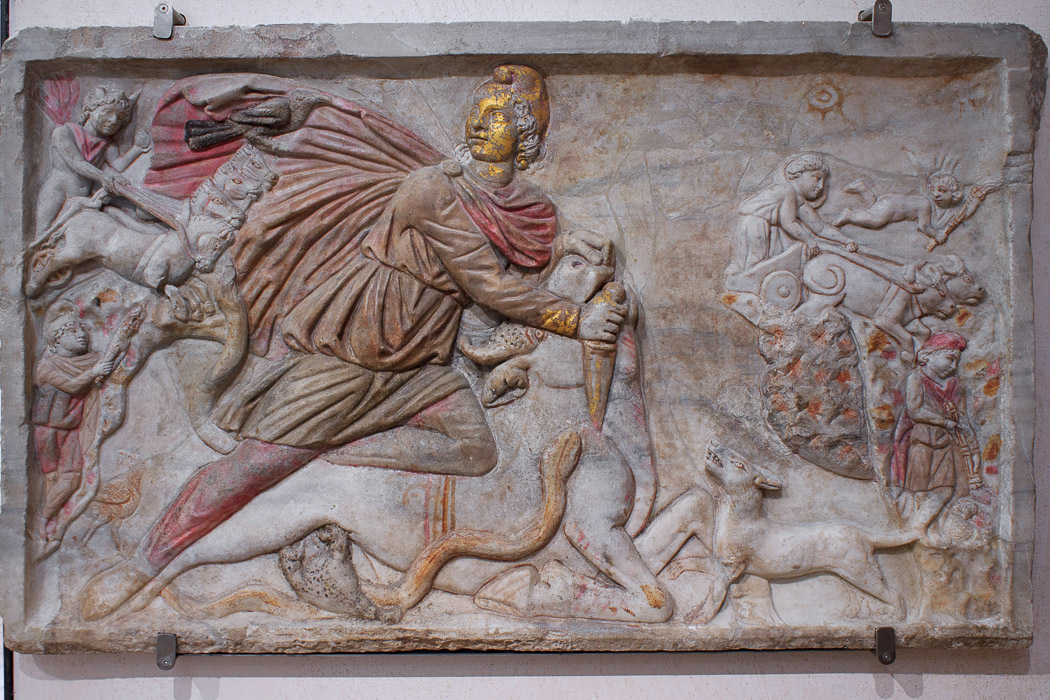
IMG_7817-20141007: Marble Mithraic Relief, with substantial remains of original color and gilding, illustrating the slaughtering of the bull by the god Mithras, from the 3rd century AD, in Hall IX of the National Museum of Rome, Terme di Diocleziano (Baths of Diocletian)
See all
National Museum of Rome - Terme di Diocleziano photos.
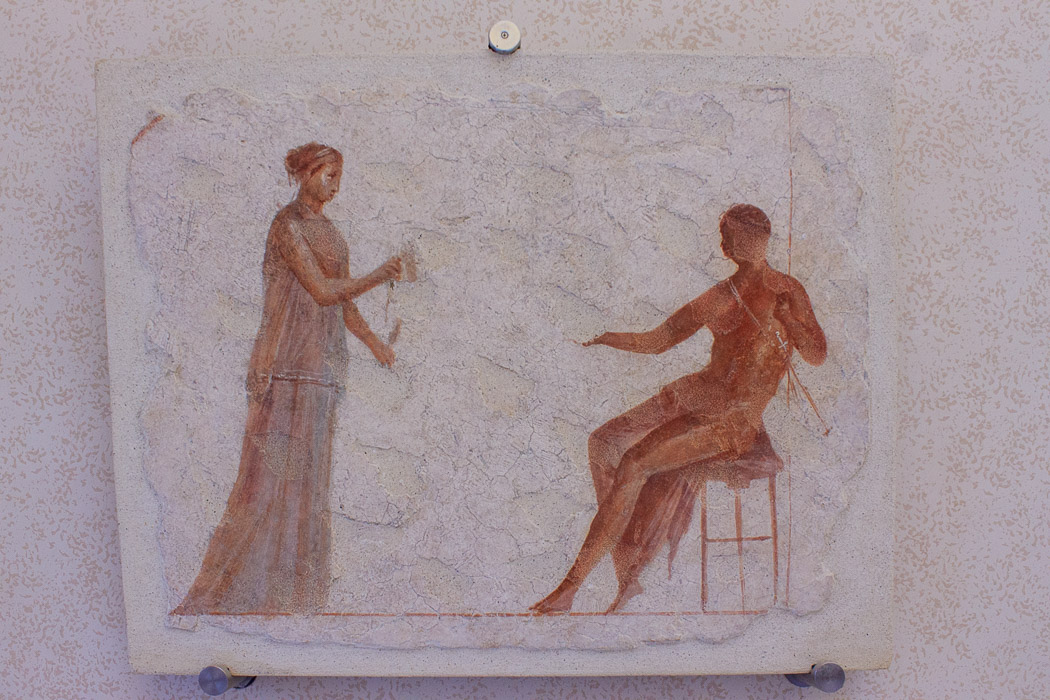

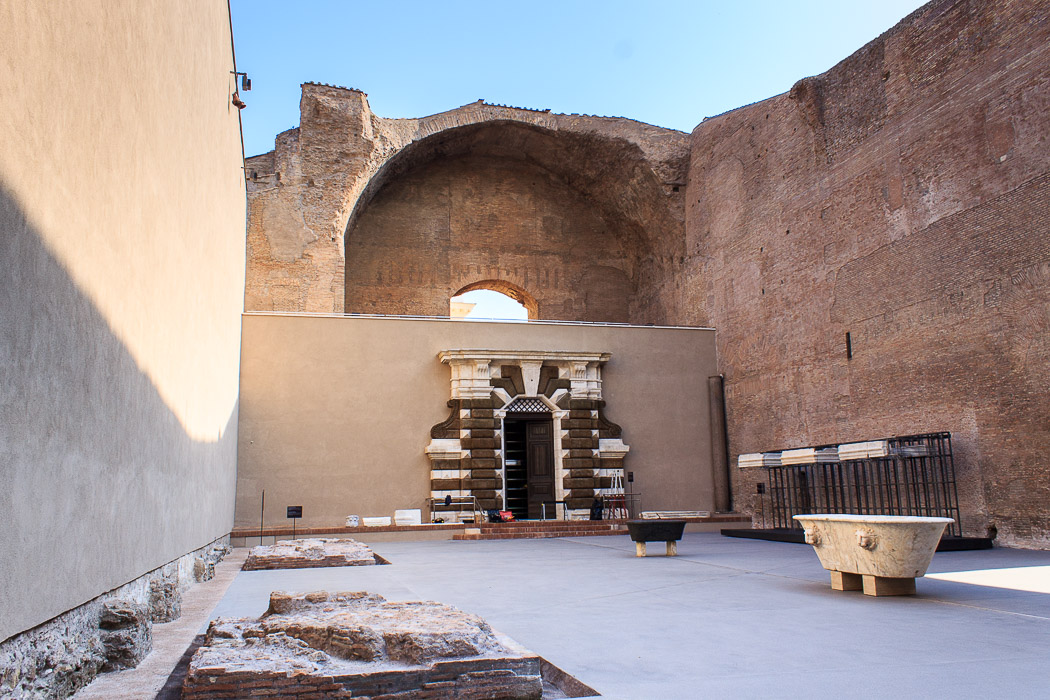
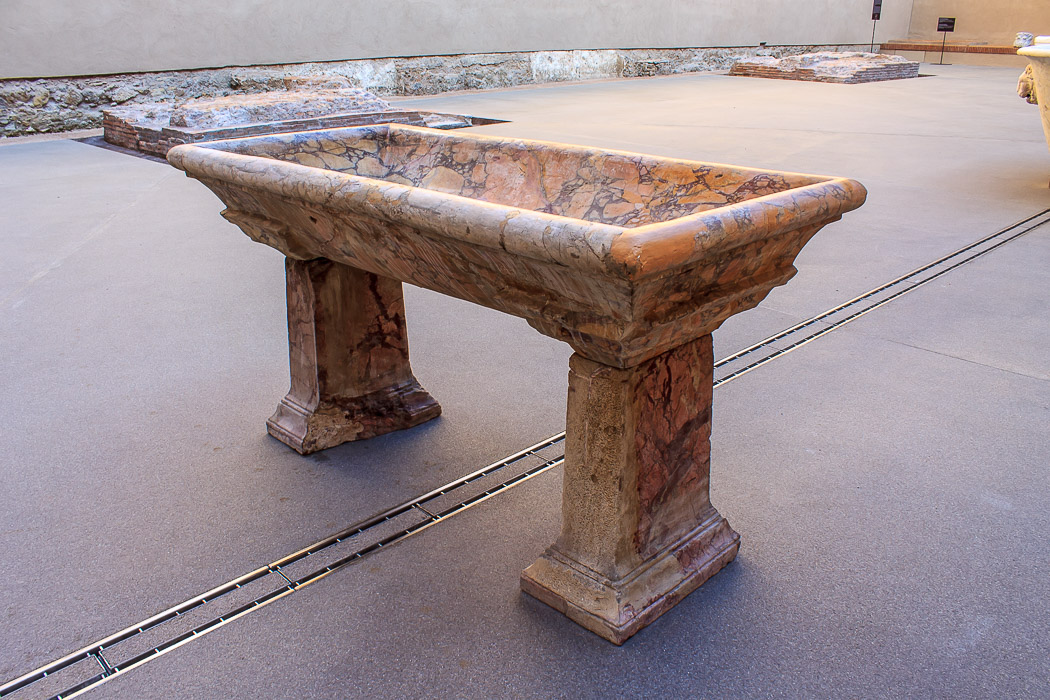
IMG_7846-20141007: Basin in yellow giallo antico marble, from a villa beneath the Baths of Diocletian, 2nd century AD, in Hall VIII of the National Museum of Rome, Terme di Diocleziano (Baths of Diocletian)
See all
National Museum of Rome - Terme di Diocleziano photos.
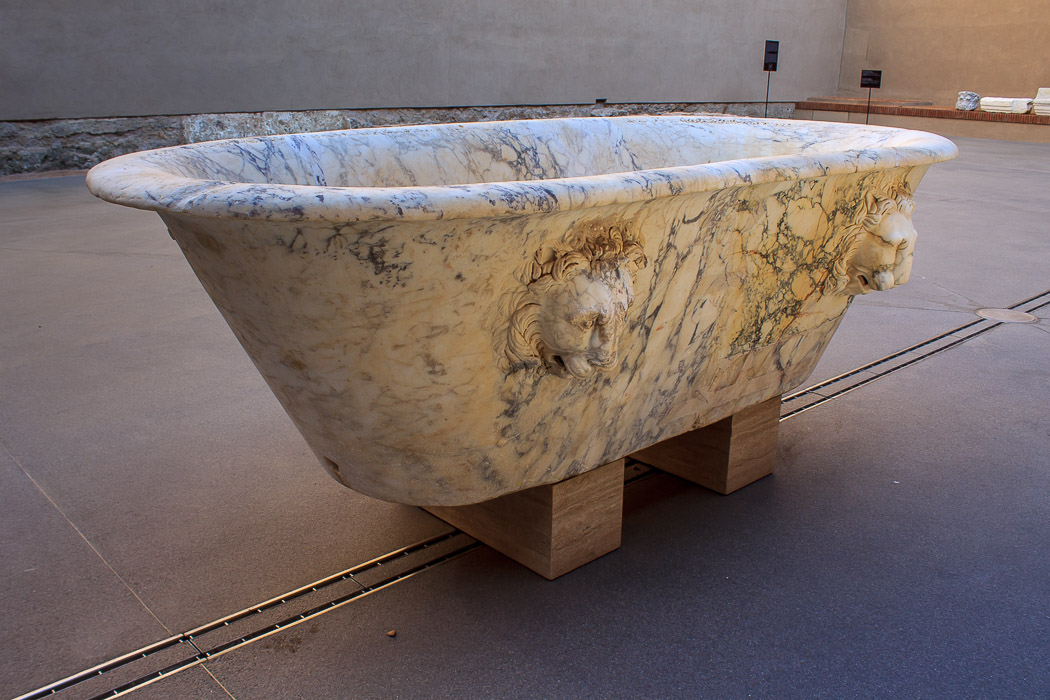
IMG_7847-20141007: Basin in marble imported from Asia Minor, decorated with Lions' heads, of a type often used in the decoration of Roman baths. 2nd century AD, possibly from the Baths of Constantine, in Hall VIII of the National Museum of Rome, Terme di Diocleziano (Baths of Diocletian)
See all
National Museum of Rome - Terme di Diocleziano photos.
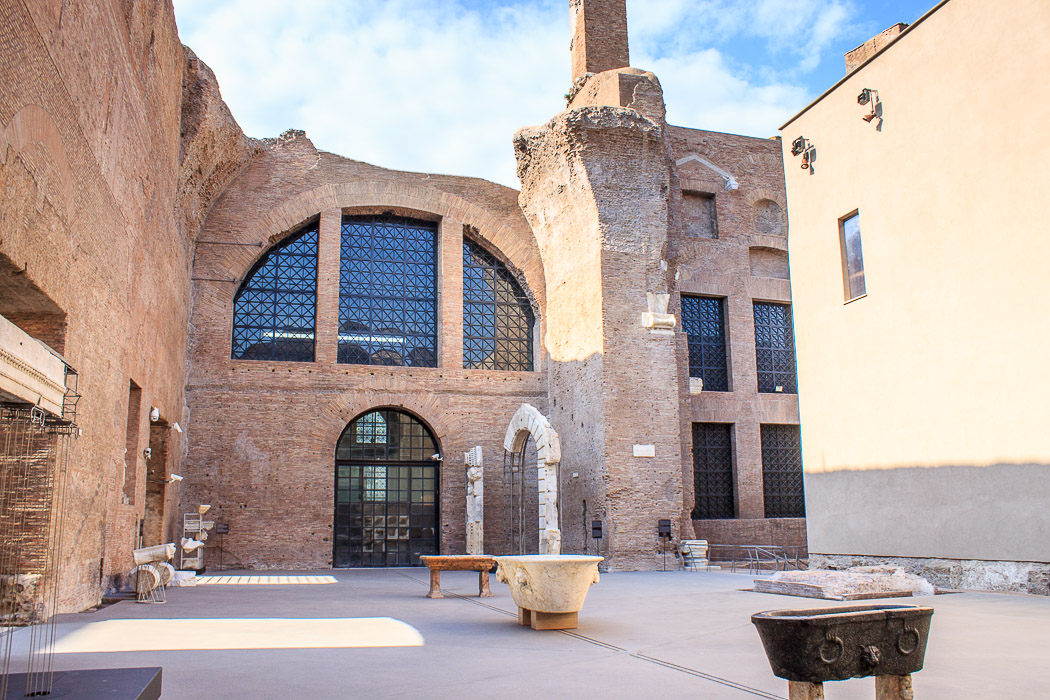
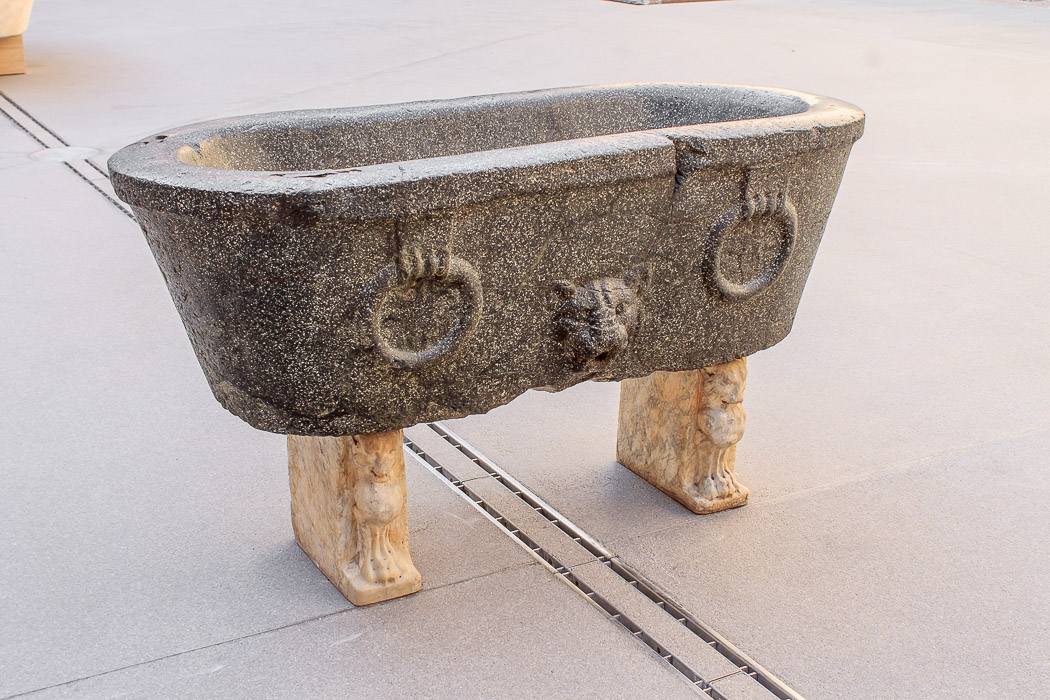
IMG_7851-20141007: Granite basin decorated with two rings and a lion's head, from the Baths of Diocletian in the late 3rd century AD, in Hall VIII of the National Museum of Rome, Terme di Diocleziano (Baths of Diocletian)
See all
National Museum of Rome - Terme di Diocleziano photos.
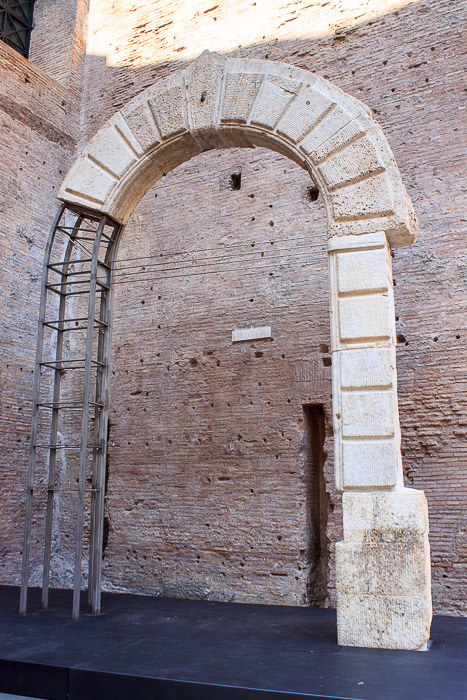
IMG_7855-20141007: The Charterhouse Gateway, a monumental portal made of marble and travetine which formed the entrance to the Charterhouse of Santa Maria degli Angeli, and testifies to the progressive spoliation of the Baths' decorations, in Hall VIII of the National Museum of Rome, Terme di Diocleziano (Baths of Diocletian)
See all
National Museum of Rome - Terme di Diocleziano photos.
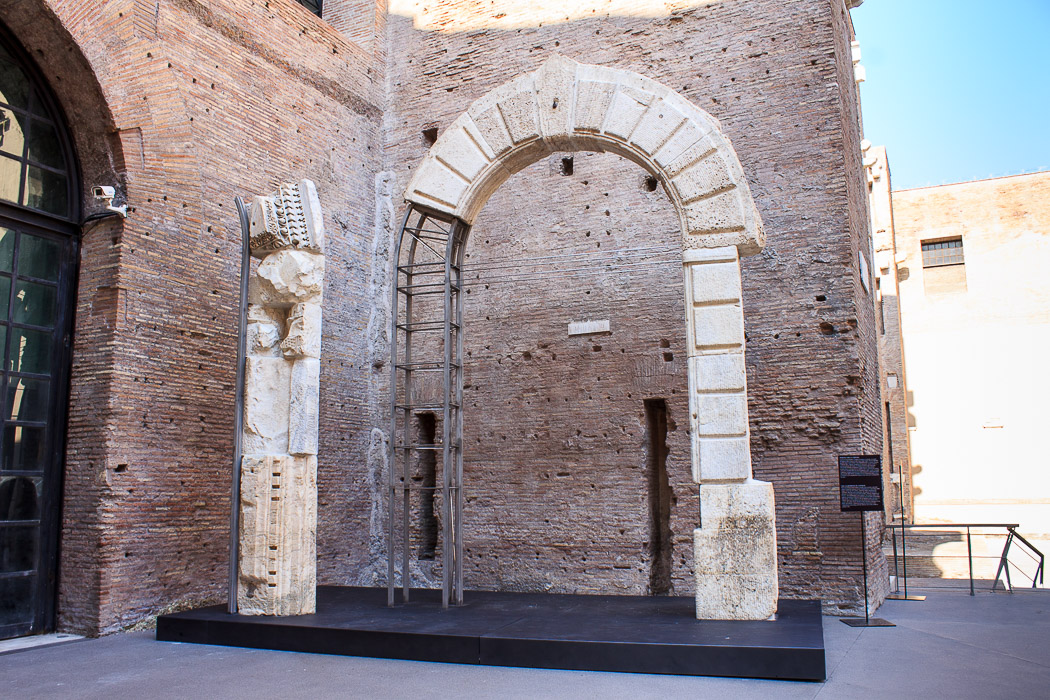
IMG_7856-20141007: The Charterhouse Gateway, a monumental portal made of marble and travetine which formed the entrance to the Charterhouse of Santa Maria degli Angeli, and testifies to the progressive spoliation of the Baths' decorations, in Hall VIII of the National Museum of Rome, Terme di Diocleziano (Baths of Diocletian)
See all
National Museum of Rome - Terme di Diocleziano photos.
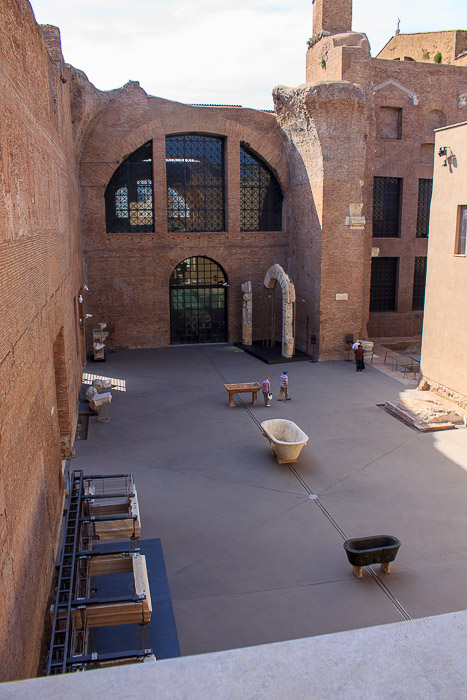
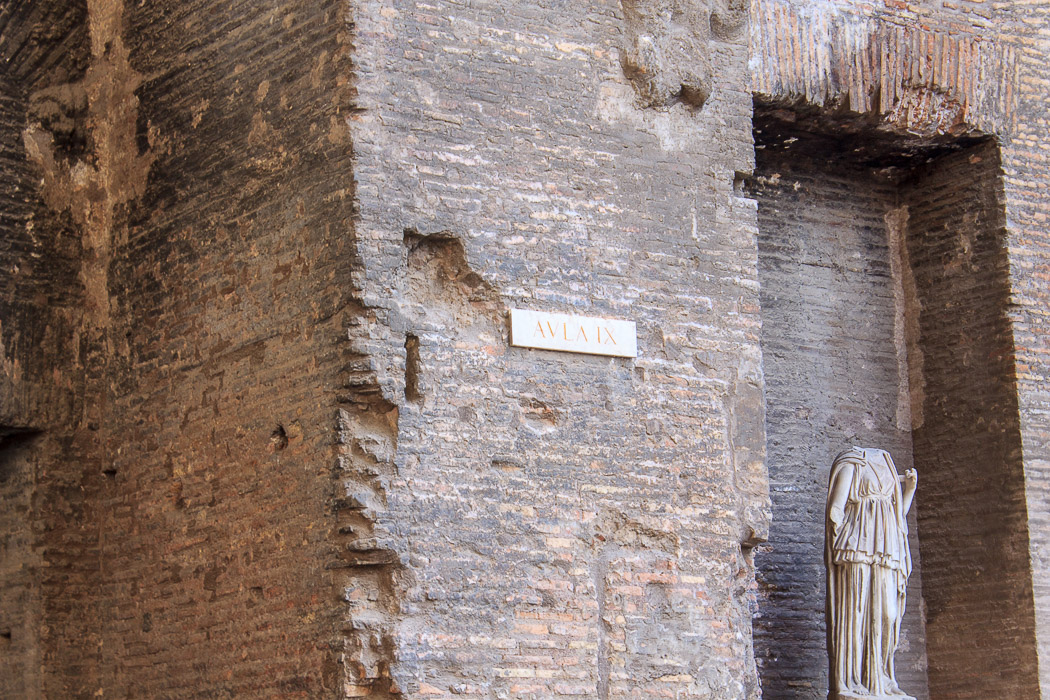
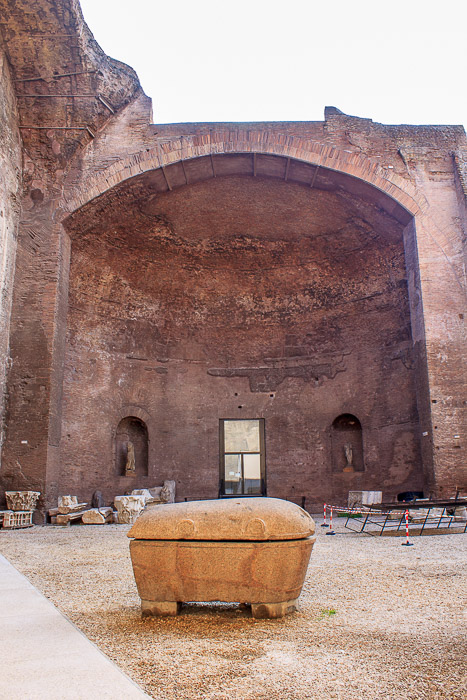
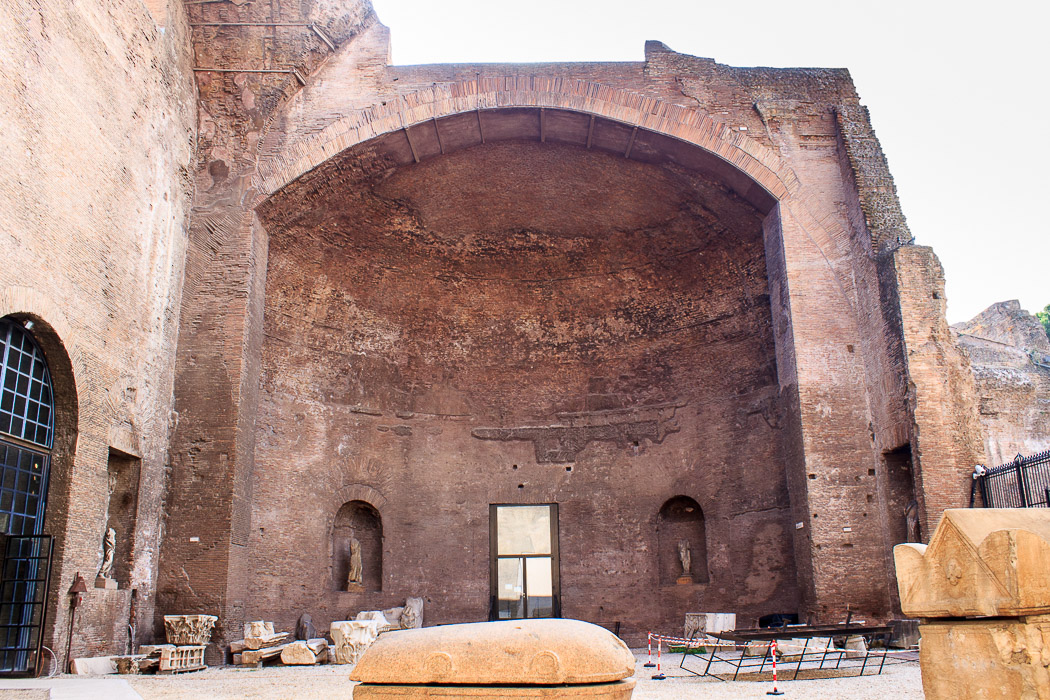
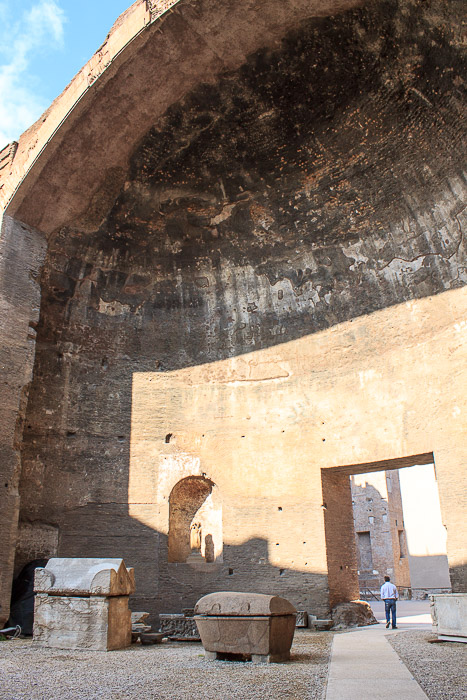
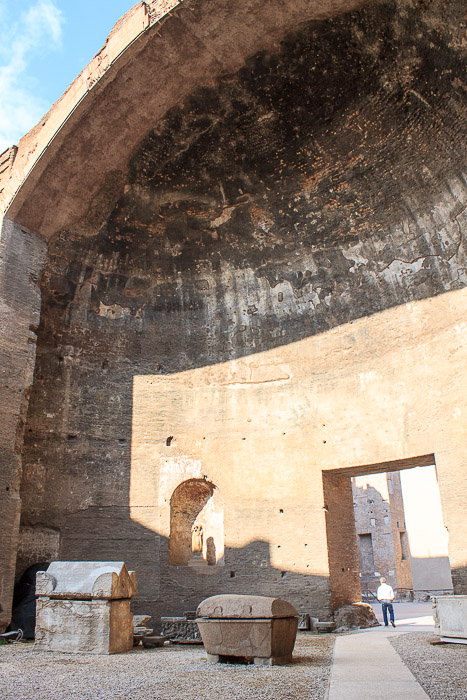
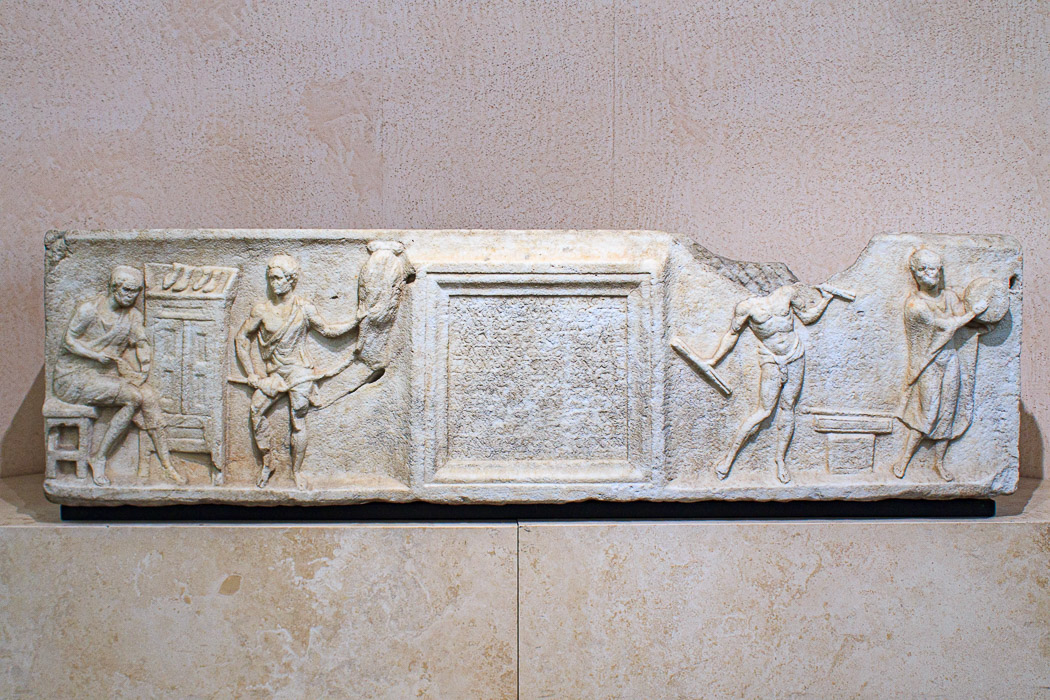
IMG_0210-20141012: A sarcophagus donated by two Roman citizens originated Greek to their friend Titus Flavius Trophimas. At the sides of the inscription there are on the left a cobbler and a spinner, on the right a dancer and a player portrayed. The scenes refer to the deceased and dedicators' work and, perhaps, to their artistic interests or their adhesion to the cult of Isis. From 98-117 AD, now in Hall IX of the National Museum of Rome, Terme di Diocleziano (Baths of Diocletian)
See all
National Museum of Rome - Terme di Diocleziano photos.

IMG_0212-20141012: A fragment of two registers, portraying gladiators fighting. The inscription shows two gladiator names, Scolasticus and Damascenus. The theta sign indicates that Damascenus died in the fight. From the end of the 3rd century AD, now in Hall IX of the National Museum of Rome, Terme di Diocleziano (Baths of Diocletian)
See all
National Museum of Rome - Terme di Diocleziano photos.
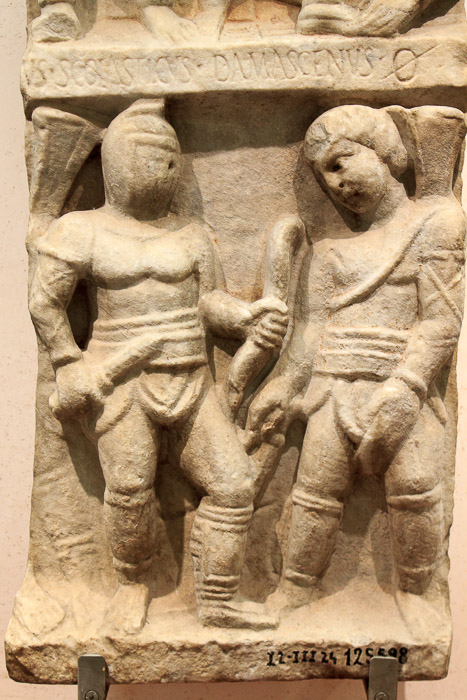
IMG_0213-20141012: A fragment of two registers, portraying gladiators fighting. The inscription shows two gladiator names, Scolasticus and Damascenus. The theta sign indicates that Damascenus died in the fight. From the end of the 3rd century AD, now in Hall IX of the National Museum of Rome, Terme di Diocleziano (Baths of Diocletian)
See all
National Museum of Rome - Terme di Diocleziano photos.
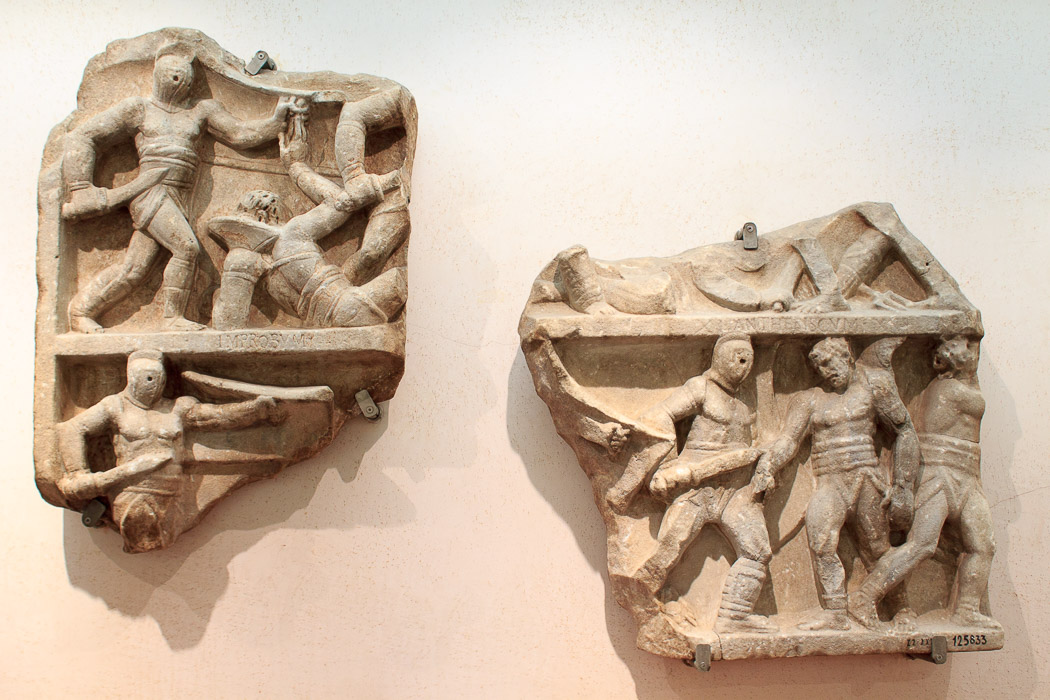
IMG_0215b-20141012: Some fragments of a commemorative relief of an unknown gladiator's ventures, portrayed in several fights with his adversaries (gladiators who used the net and trident). The inscription indicates the number of the fights won (I, XI, XII) and the beaten gladiators' names: Improvus, Pantheriscus and Ilarus. From the 3rd century AD, now in Hall IX of the National Museum of Rome, Terme di Diocleziano (Baths of Diocletian)
See all
National Museum of Rome - Terme di Diocleziano photos.
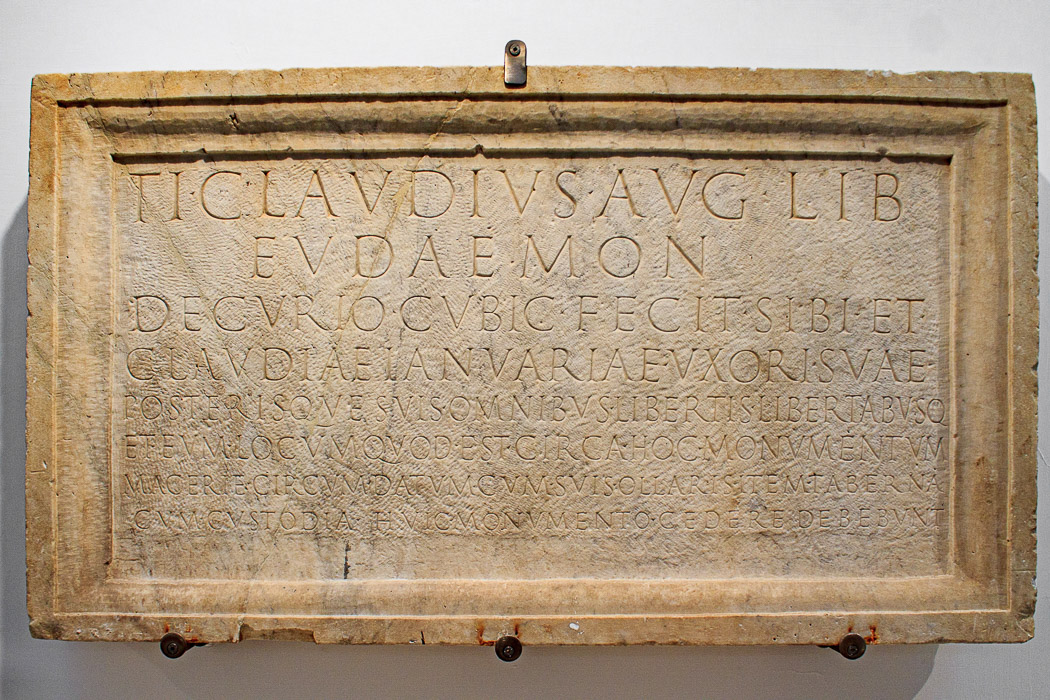
IMG_0217-20141012: A burial inscription put up by Emperor Claudius' freedman, Ti Claudius Eudaemon, head of one of the decuriae in which the emperor's waiters were subdivided. He had the task of coordinating the servants who worked in private rooms. From 41-54 AD, now in Hall IX of the National Museum of Rome, Terme di Diocleziano (Baths of Diocletian)
See all
National Museum of Rome - Terme di Diocleziano photos.

IMG_0219-20141012: A slab placed by Ulpia Priscilla for her husband Aphetus, an imperial freedman, whose duty it was to compile the emperor's guest lists, with a patera with a downflow of holes in the center, from the first half of the 2nd century AD, now in Hall IX of the National Museum of Rome, Terme di Diocleziano (Baths of Diocletian)
See all
National Museum of Rome - Terme di Diocleziano photos.
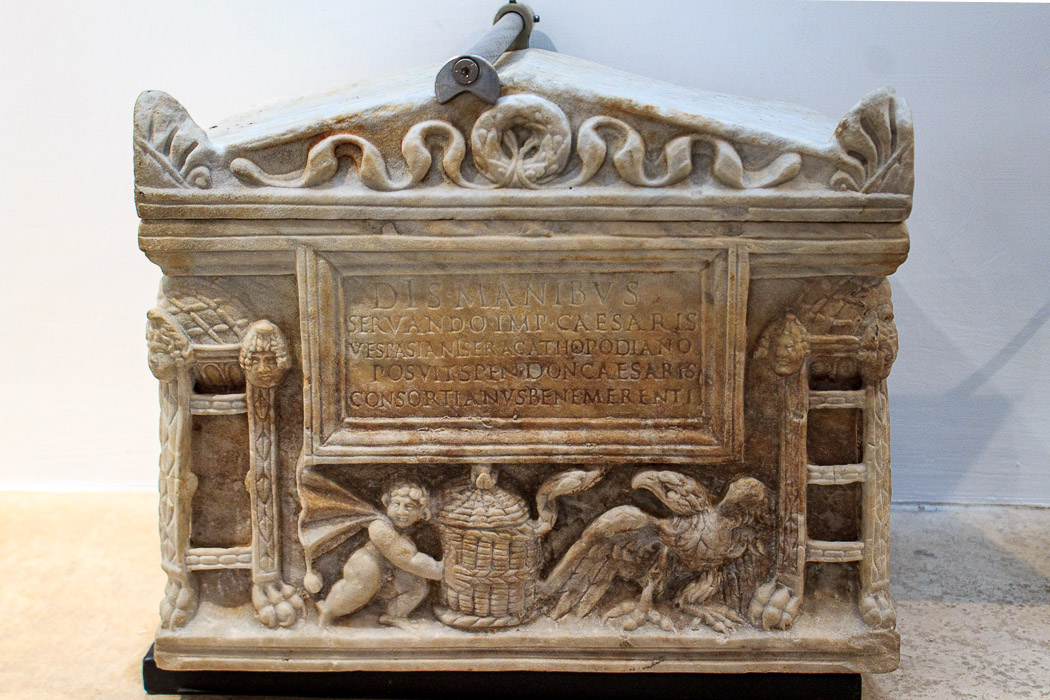
IMG_0221-20141012: An urn of Servandus Agathopodianus, the Emperor Vespasian's slave. Under the inscription there is a cupid with his arms straightened towards a cist where a snake is coming out from, perhaps it is an allusion to the cult of Isis. From 69-79 AD, now in Hall IX of the National Museum of Rome, Terme di Diocleziano (Baths of Diocletian)
See all
National Museum of Rome - Terme di Diocleziano photos.
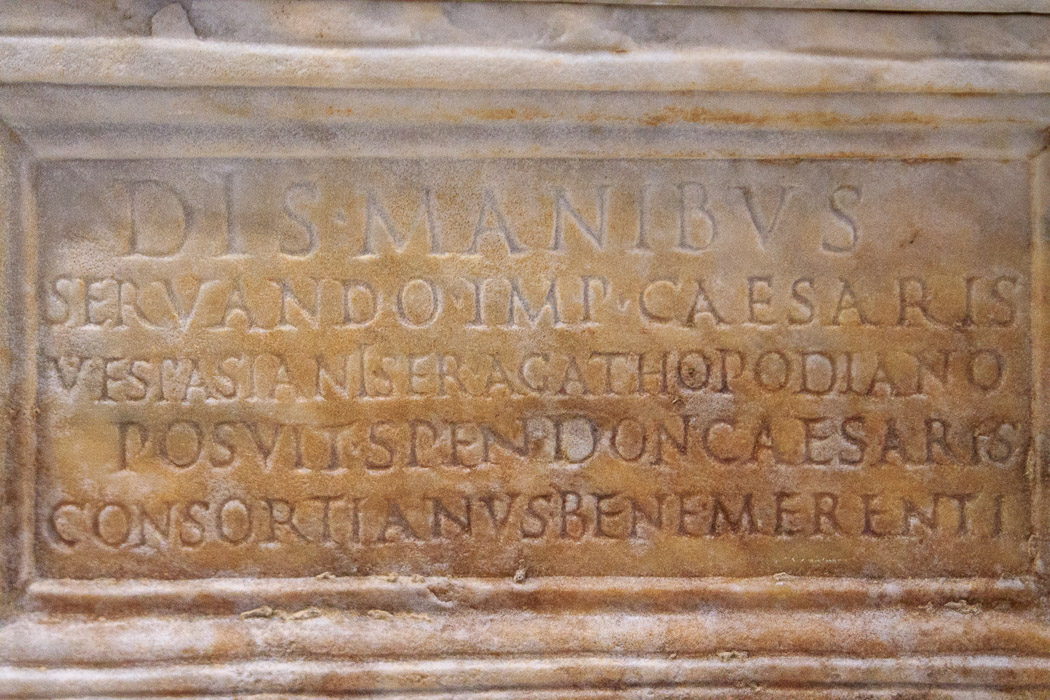
IMG_0222-20141012: An urn of Servandus Agathopodianus, the Emperor Vespasian's slave. Under the inscription there is a cupid with his arms straightened towards a cist where a snake is coming out from, perhaps it is an allusion to the cult of Isis. From 69-79 AD, now in Hall IX of the National Museum of Rome, Terme di Diocleziano (Baths of Diocletian)
See all
National Museum of Rome - Terme di Diocleziano photos.
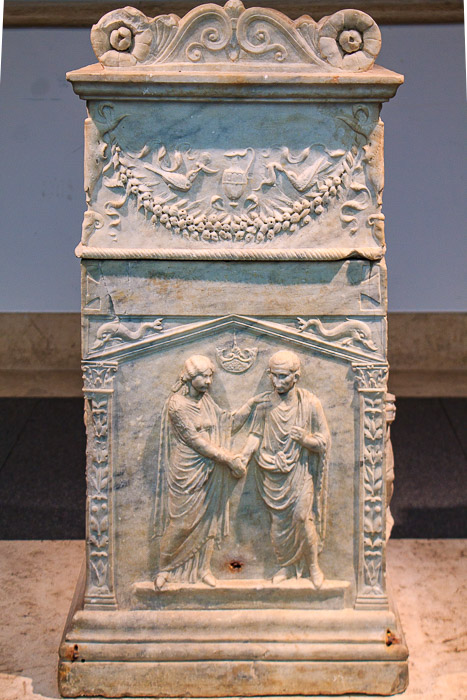
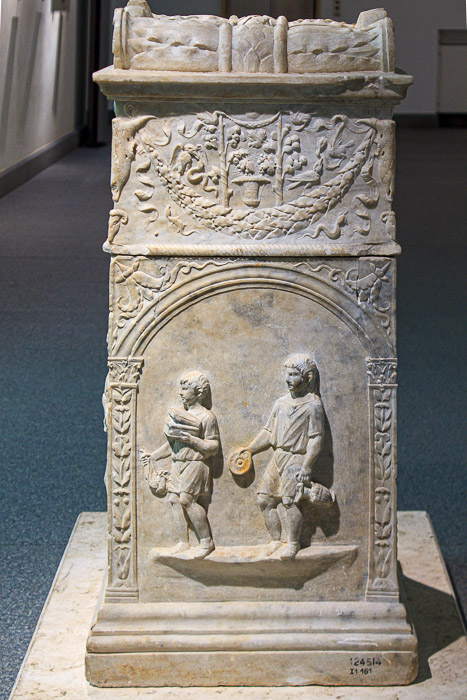
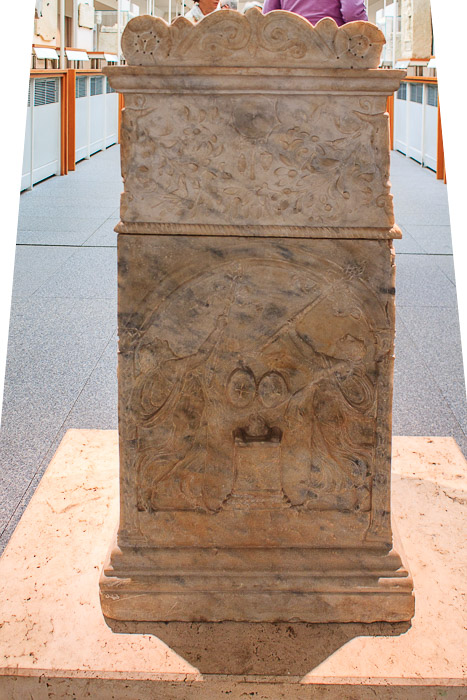
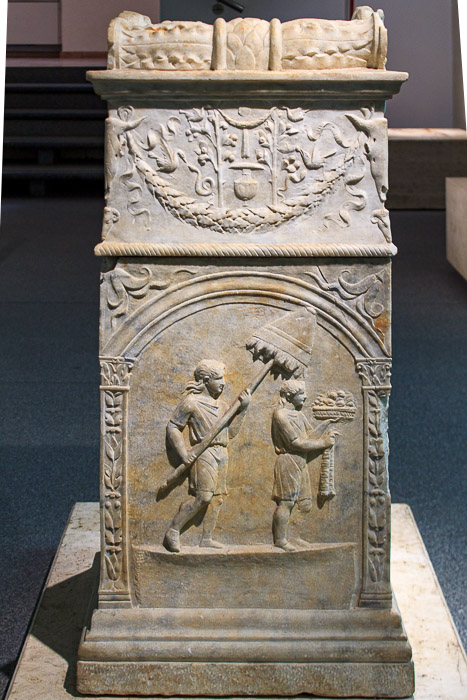
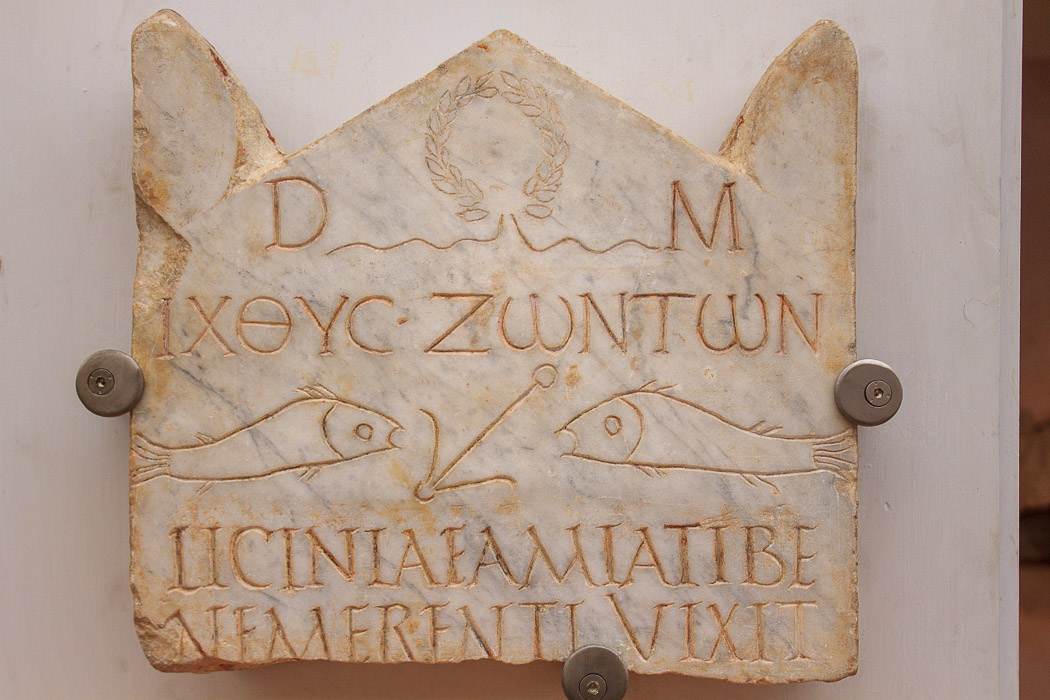
IMG_0228-20141012: The funeral stele of Licinia Amias contains one of the most ancient Christian inscriptions in Rome, translated as 'fish of the living' with the word fish being an acrostic of the name of Jesus Christ, and the second term connected with salvation, in Hall IX of the National Museum of Rome, Terme di Diocleziano (Baths of Diocletian)
See all
National Museum of Rome - Terme di Diocleziano photos.
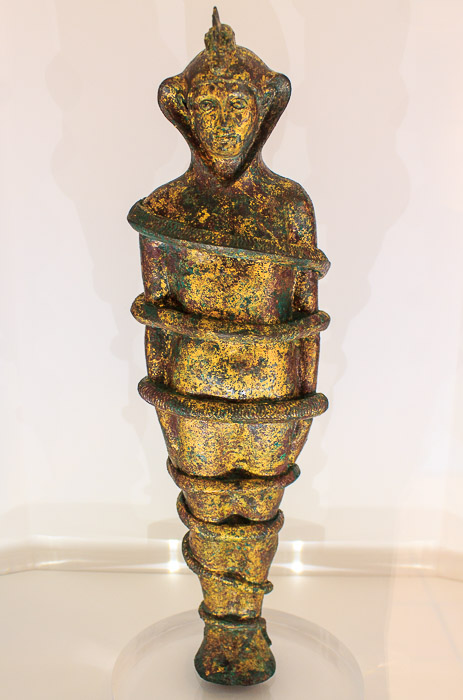
IMG_0230-20141012: The gold-plated bronze statuette represents a veiled male figure wrapped in snake coils. The statue, an oriental deity not precisely identified, was found sealed in a ritual burial pit inside an altar together with offerings such as eggs, seeds and flowers. On the occasion of the annual ceremonies the statuette was extracted, exposed to the followers and re-buried to symbolize death and rebirth of the god, patron of the endless cycles of nature, and promise of resurrection. Found on the Syrian Sanctuary of the Janiculum Hill, from the mid-4th century AD, now in Hall IX of the National Museum of Rome, Terme di Diocleziano (Baths of Diocletian)
See all
National Museum of Rome - Terme di Diocleziano photos.
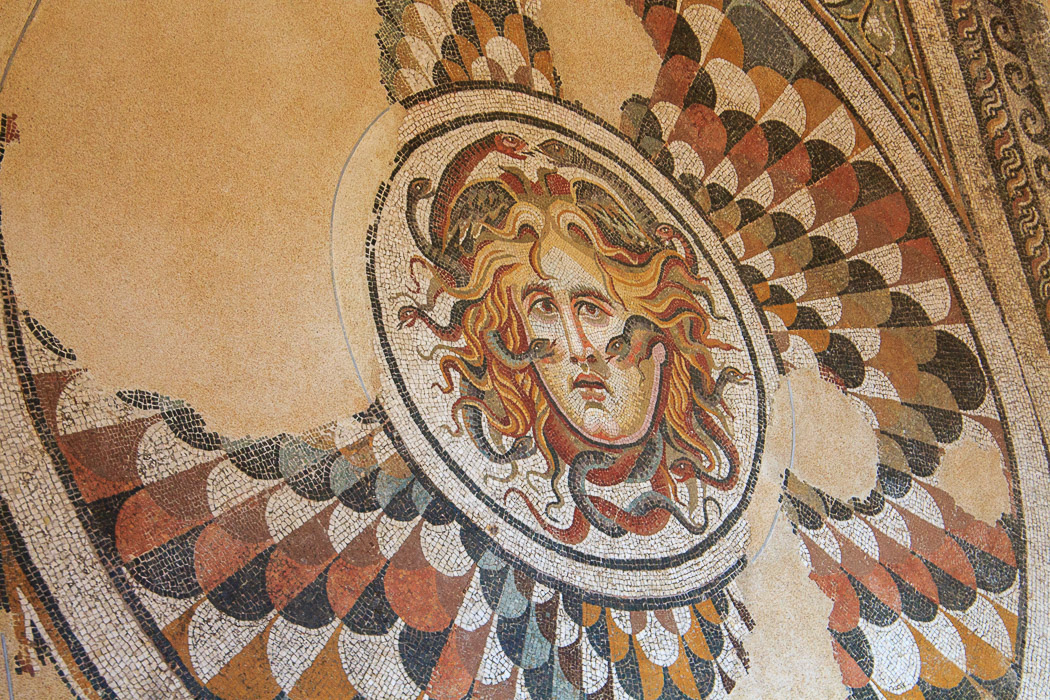
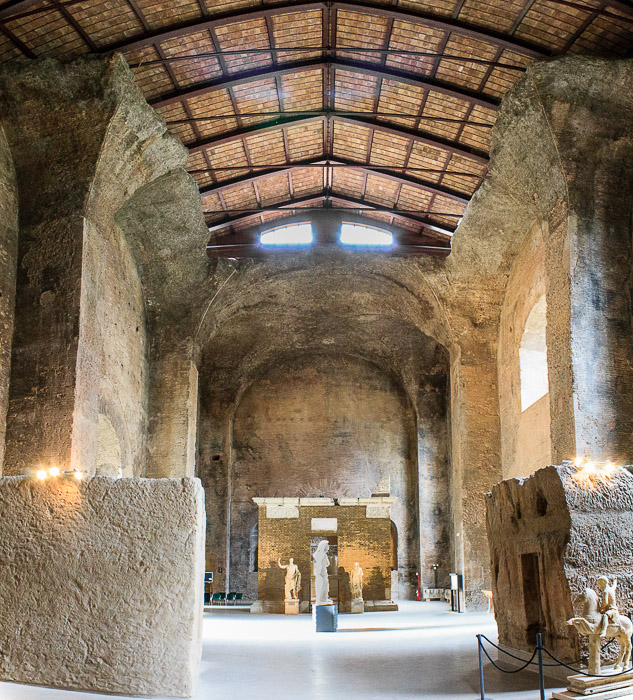
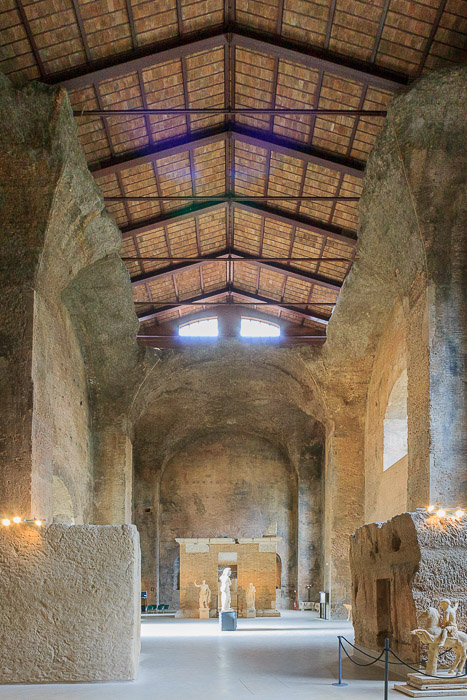
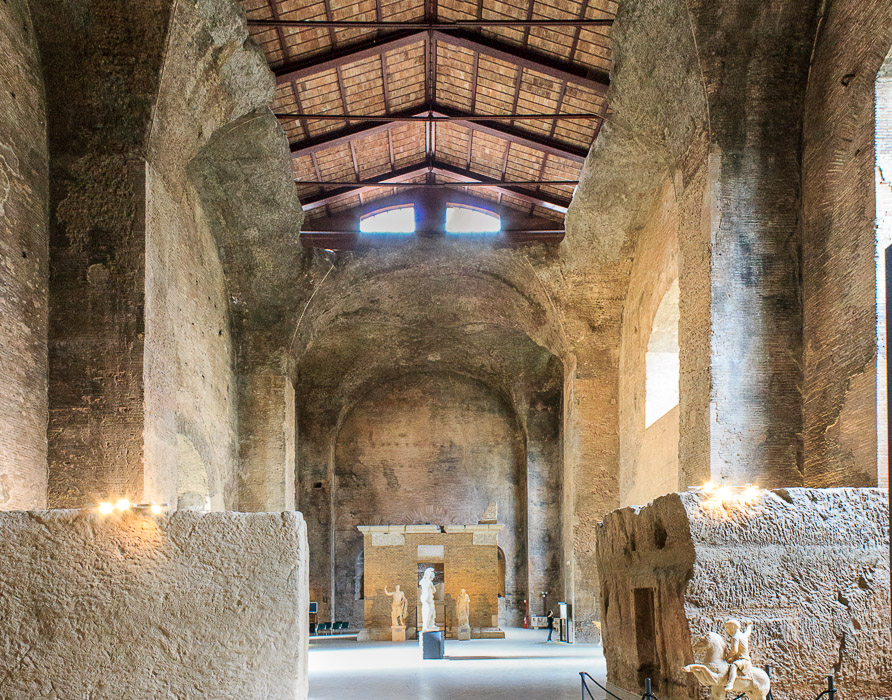

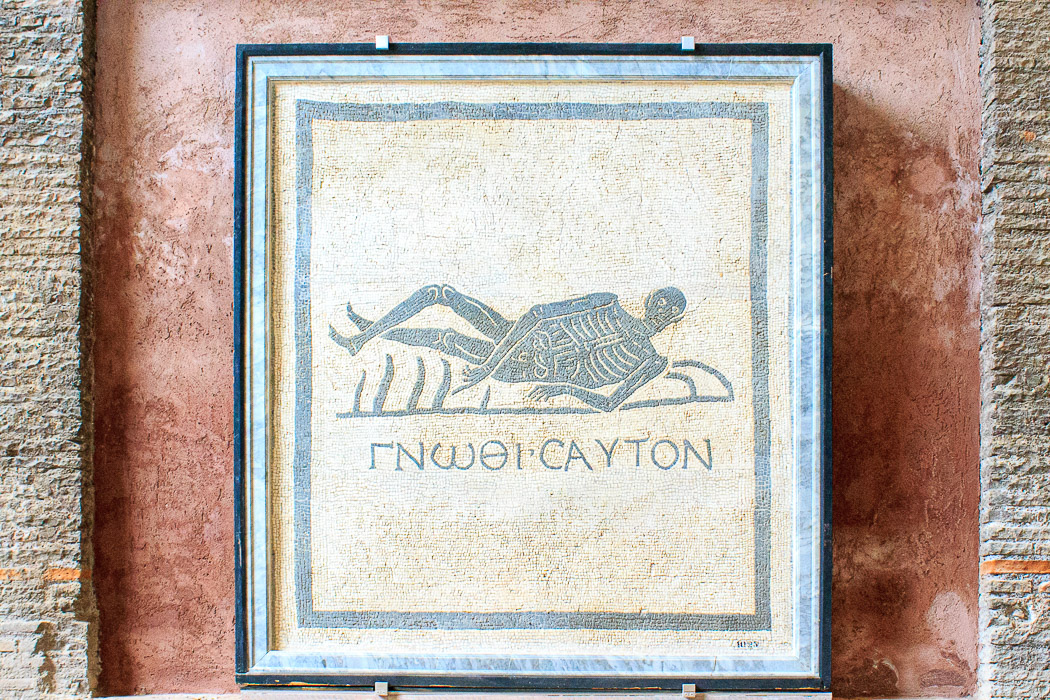
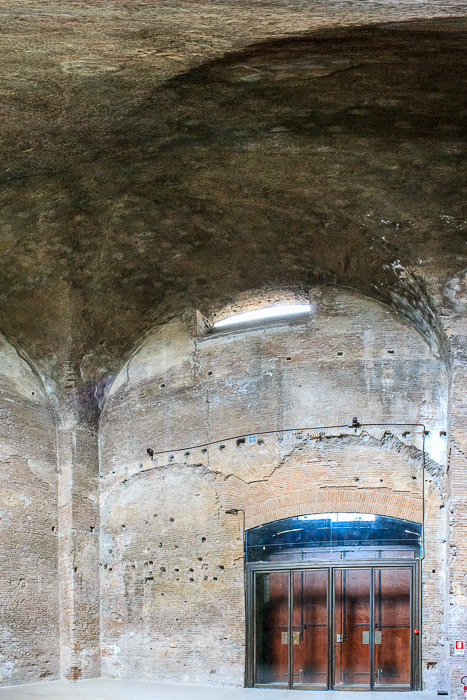
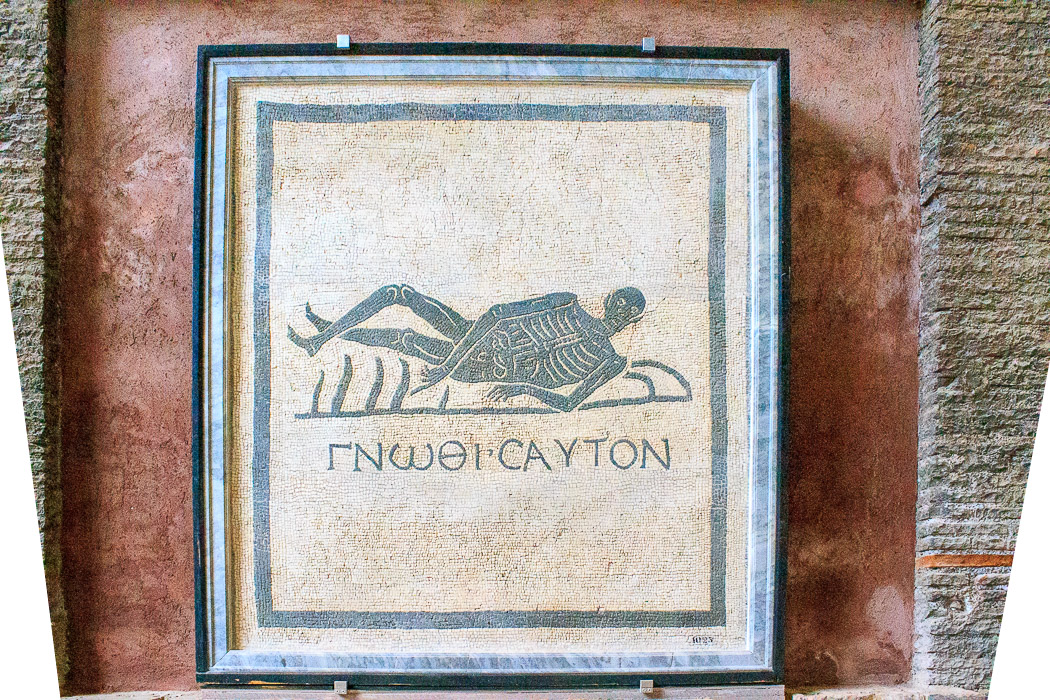
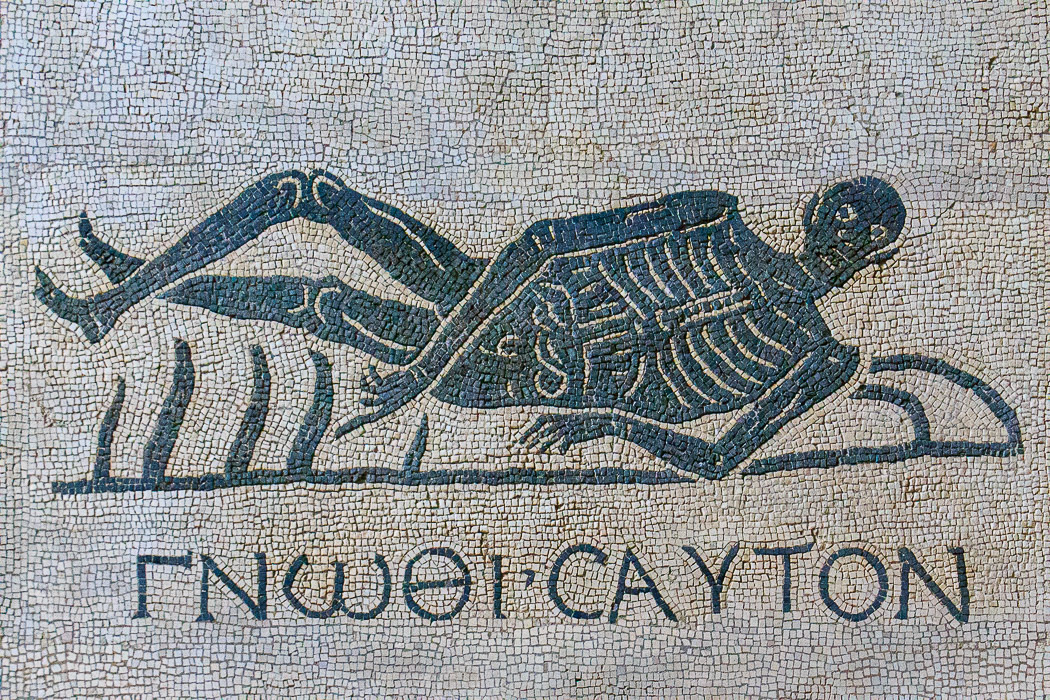
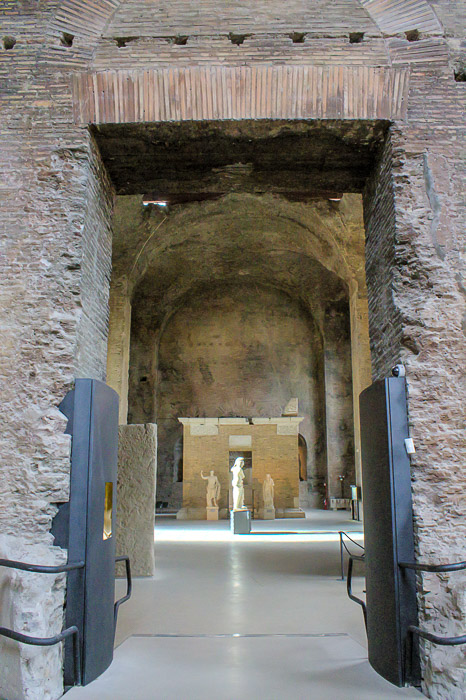
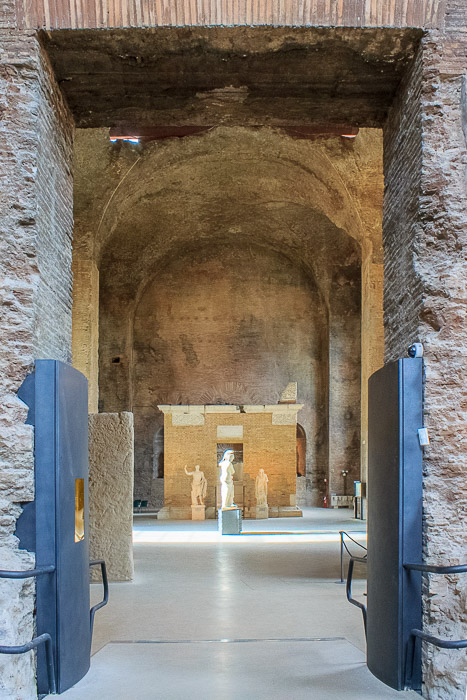
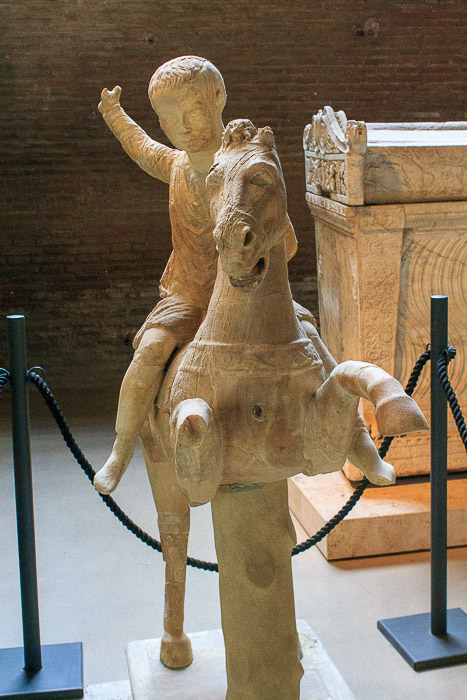
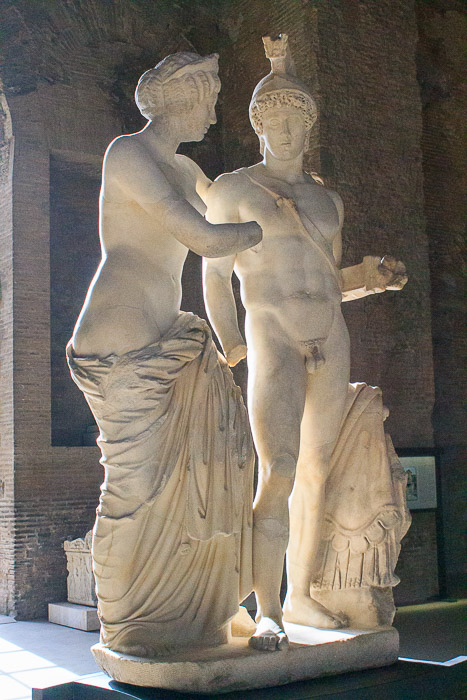
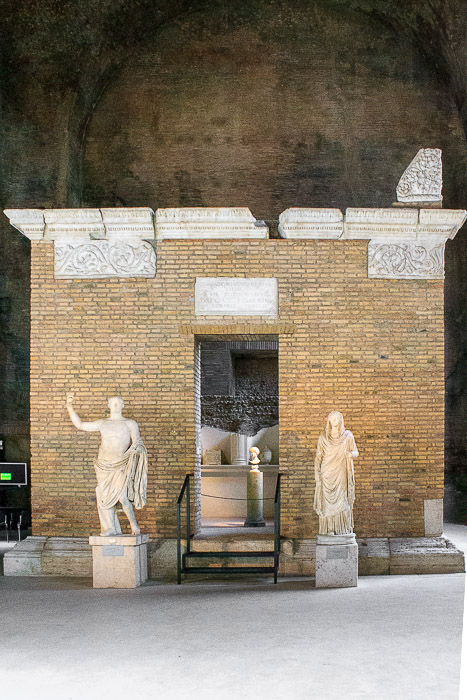
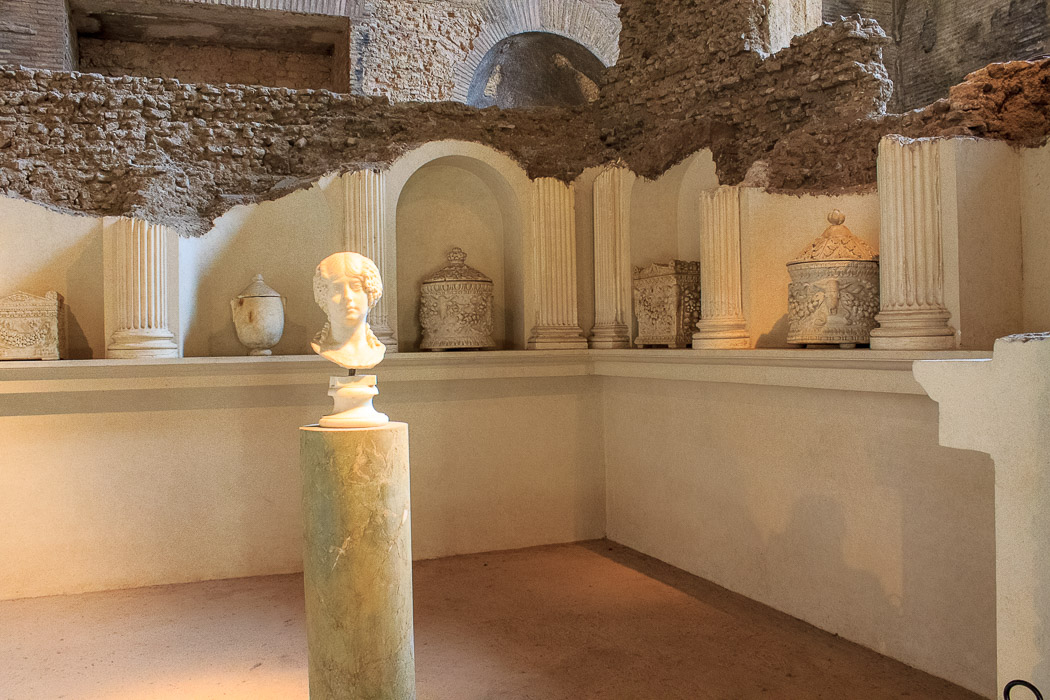
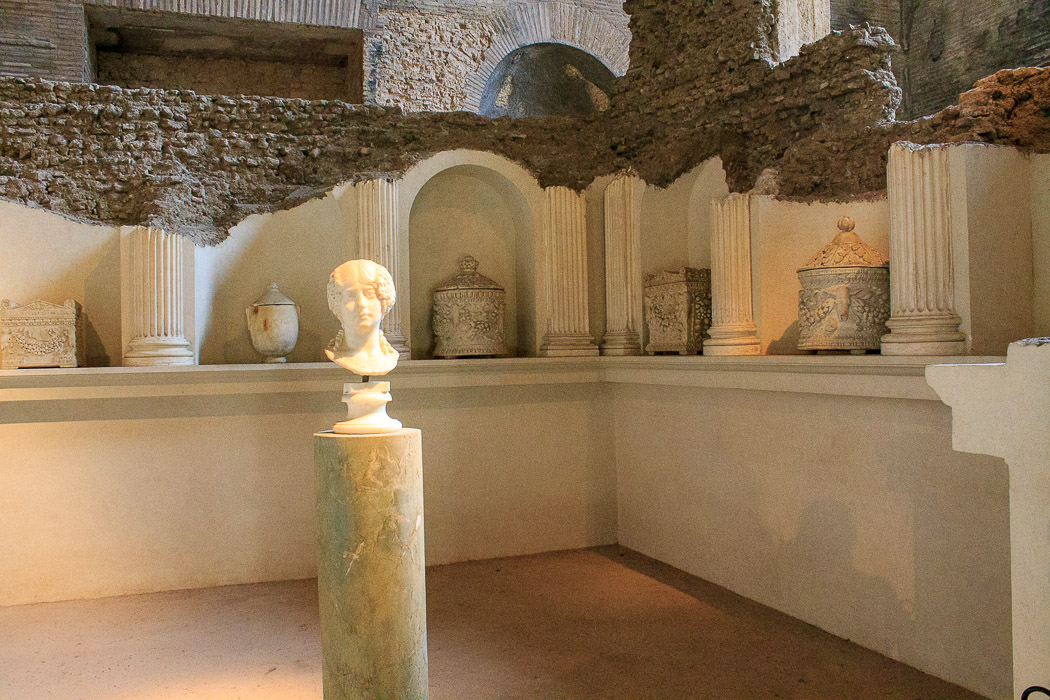
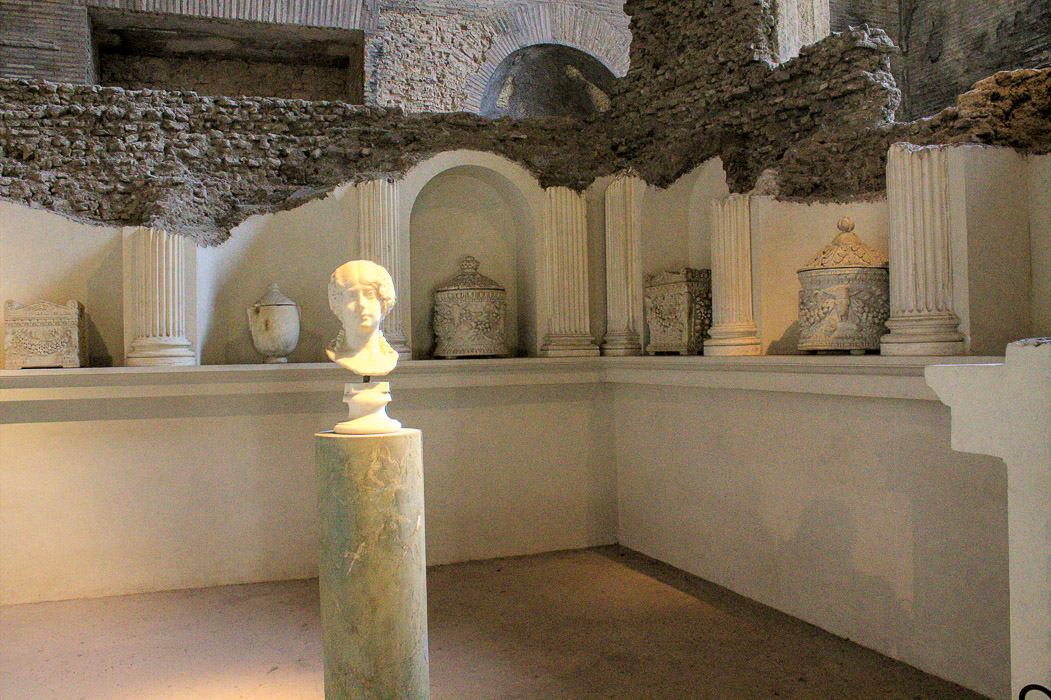
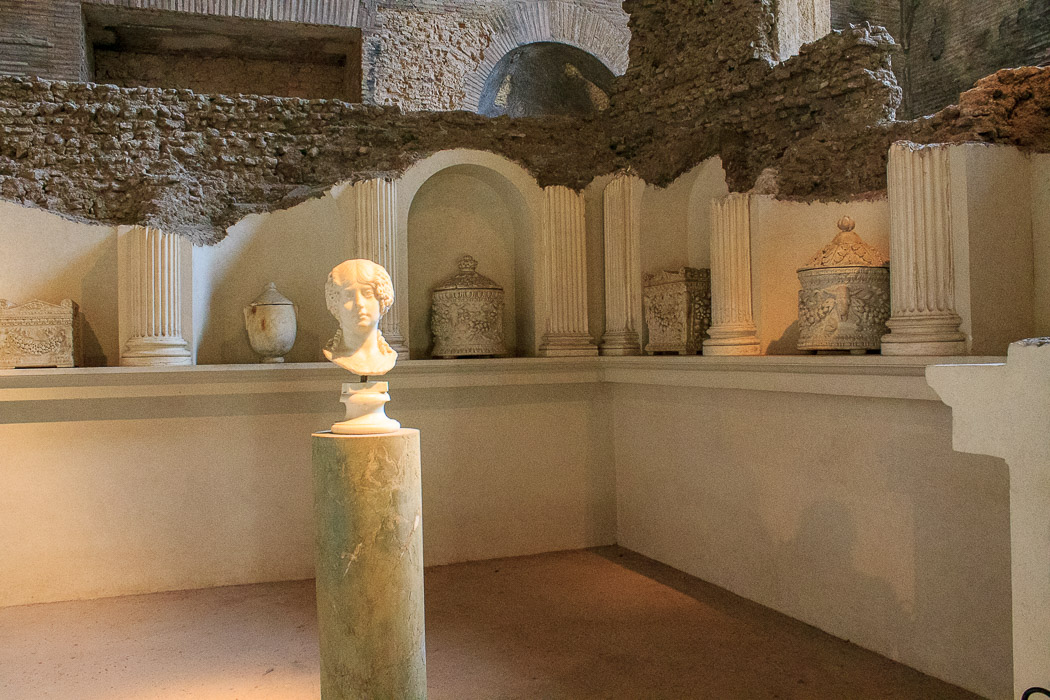
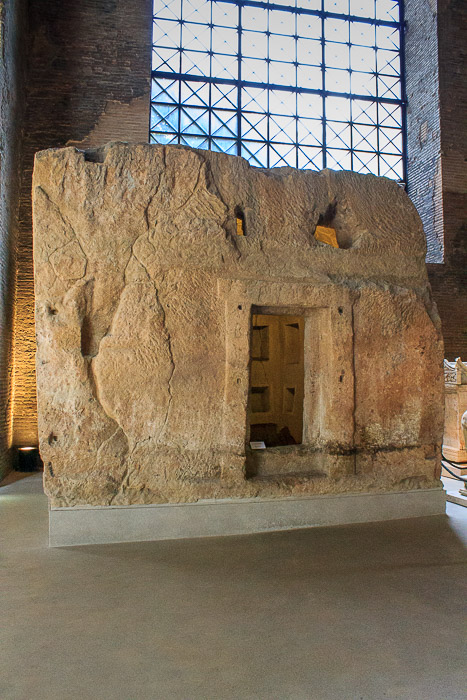
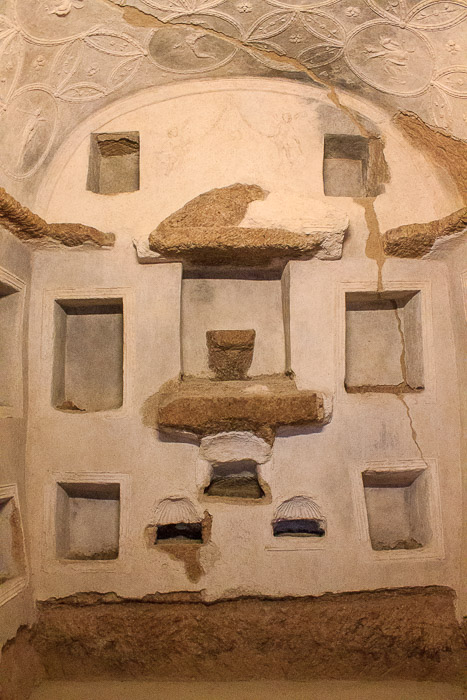
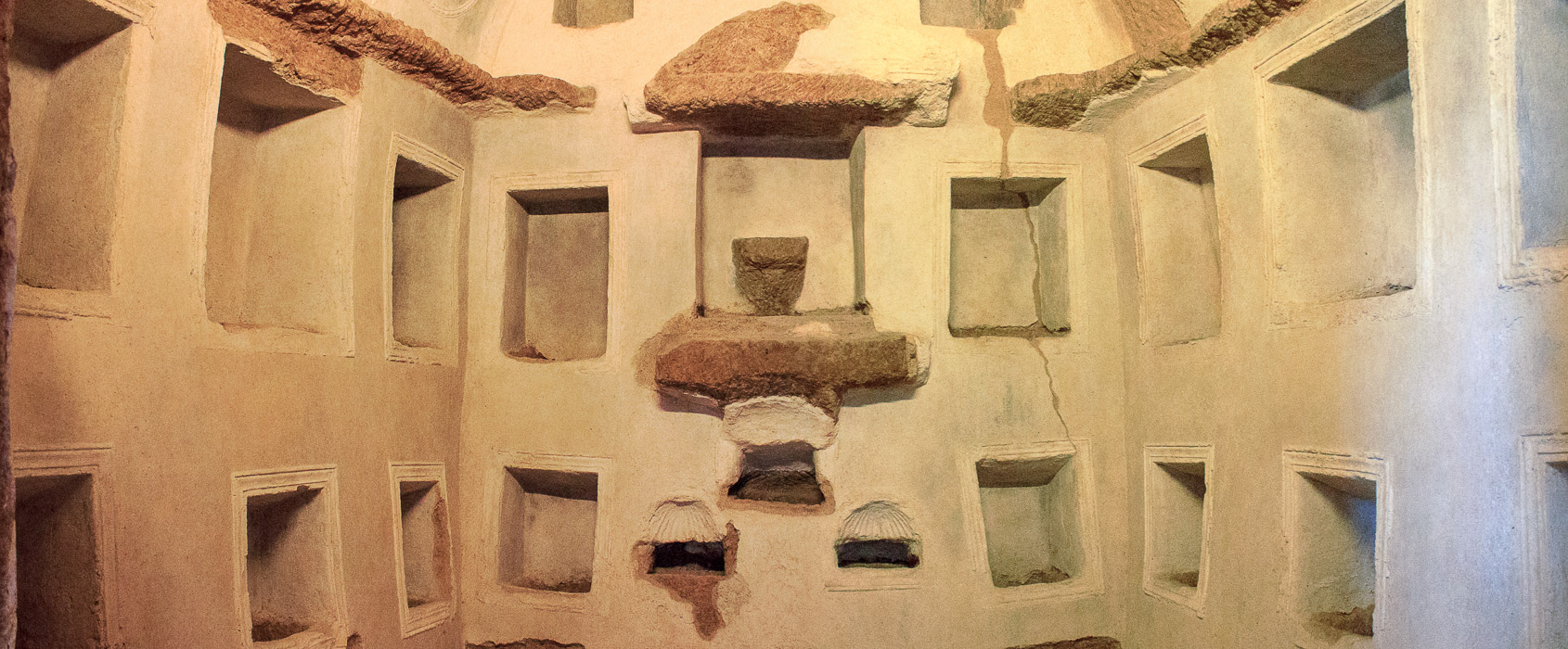
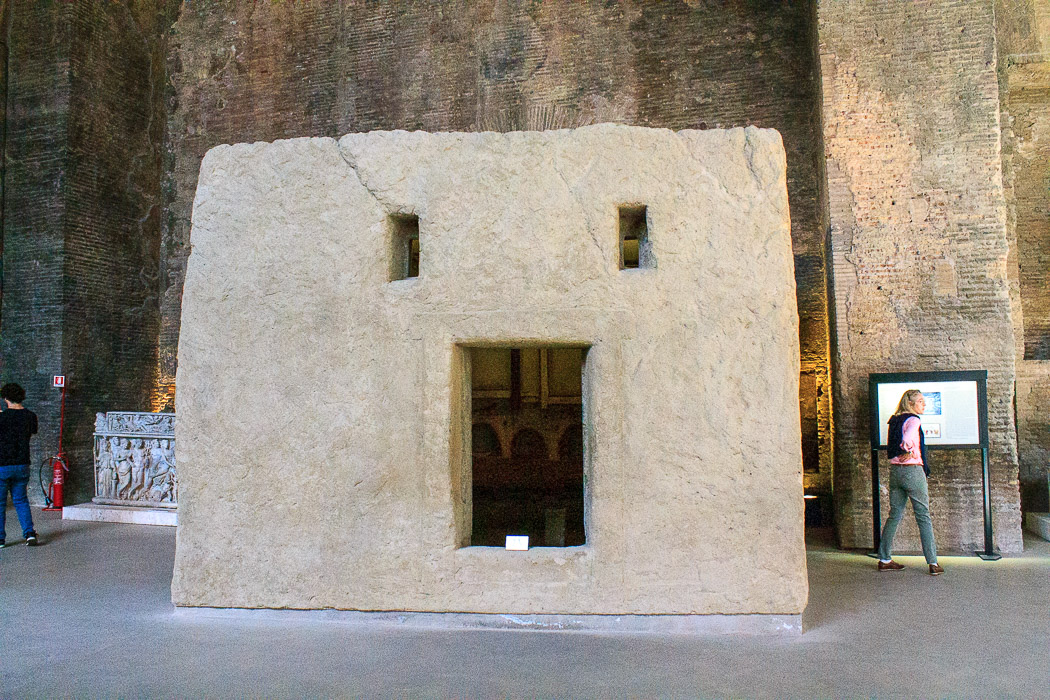

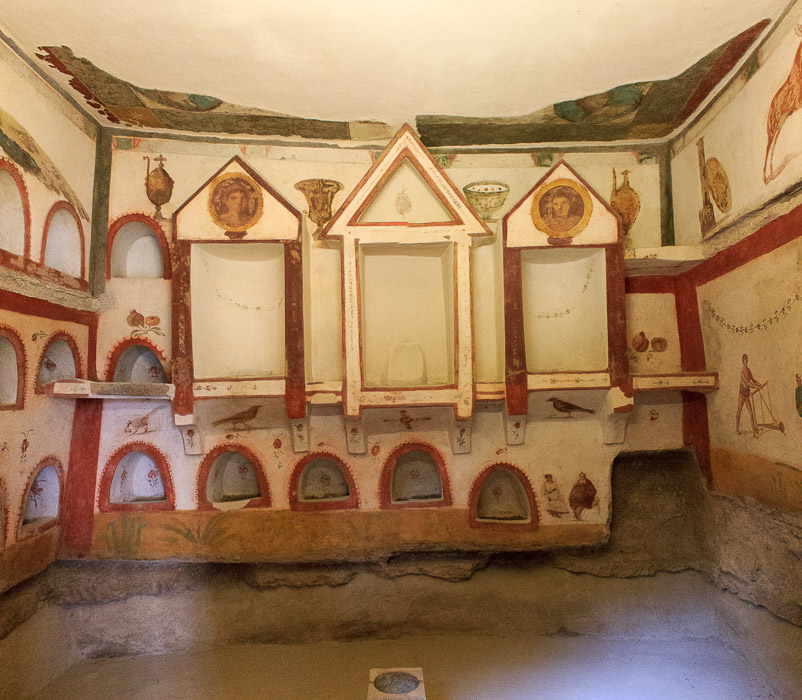
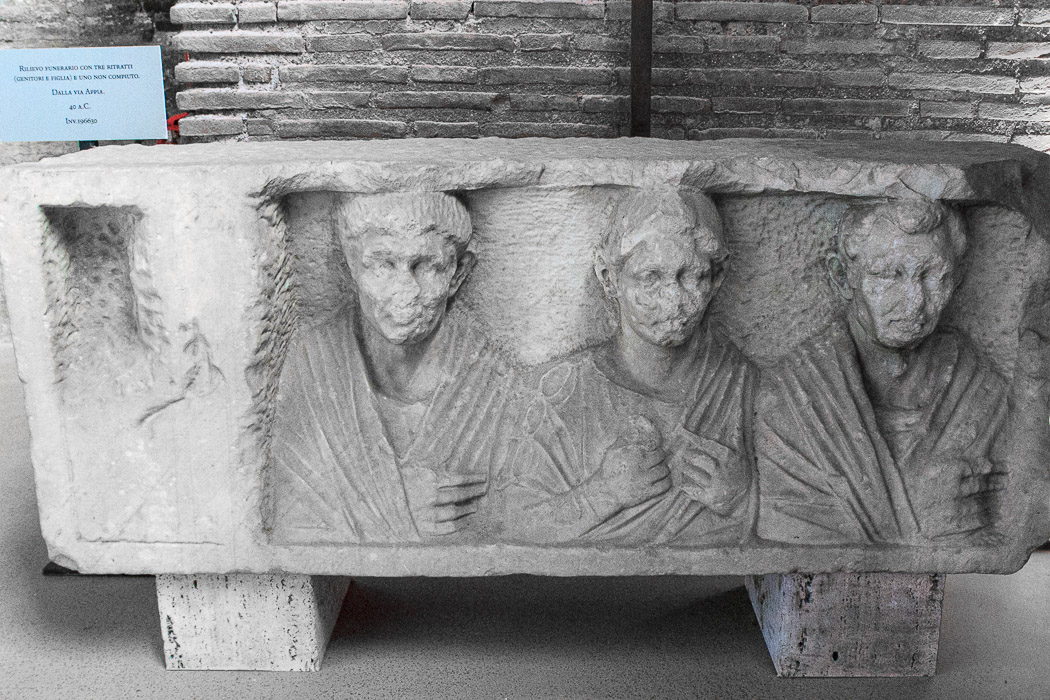
IMG_7865-20141007: Funerary relief with three portraits (parents and daughter) and one incomplete portrait, from the Appian Way, 40 BC, in Hall X of the National Museum of Rome, Terme di Diocleziano (Baths of Diocletian)
See all
National Museum of Rome - Terme di Diocleziano photos.
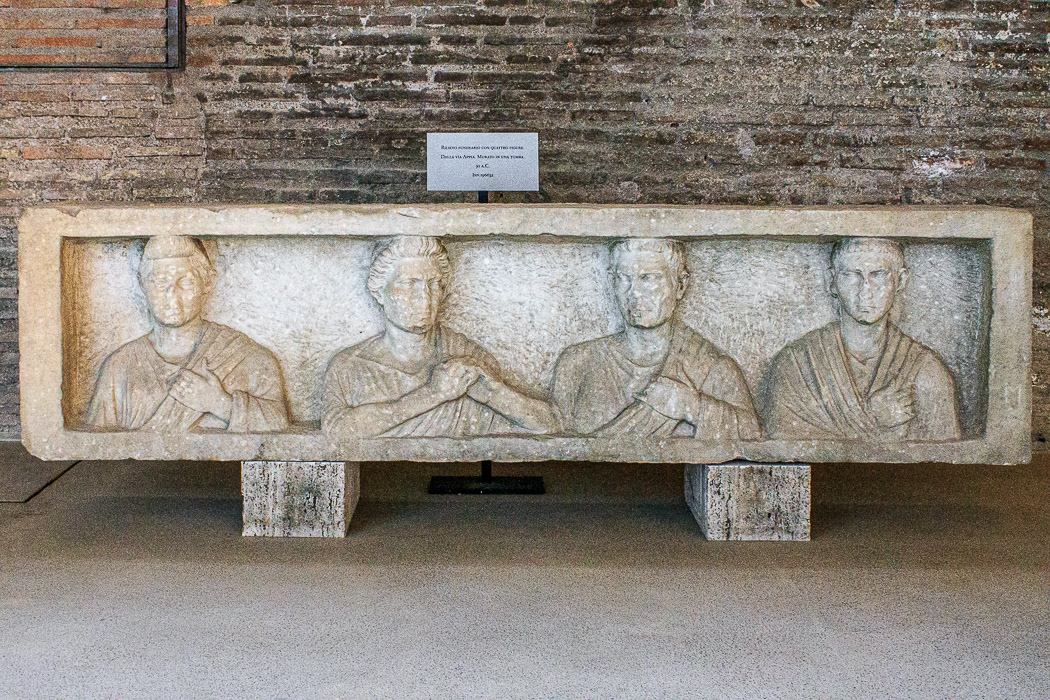
IMG_7867-20141007: Funerary relief with four figures, from the so-called Tomb of the Frontispiece on the Appian Way, 30 BC, in Hall X of the National Museum of Rome, Terme di Diocleziano (Baths of Diocletian)
See all
National Museum of Rome - Terme di Diocleziano photos.
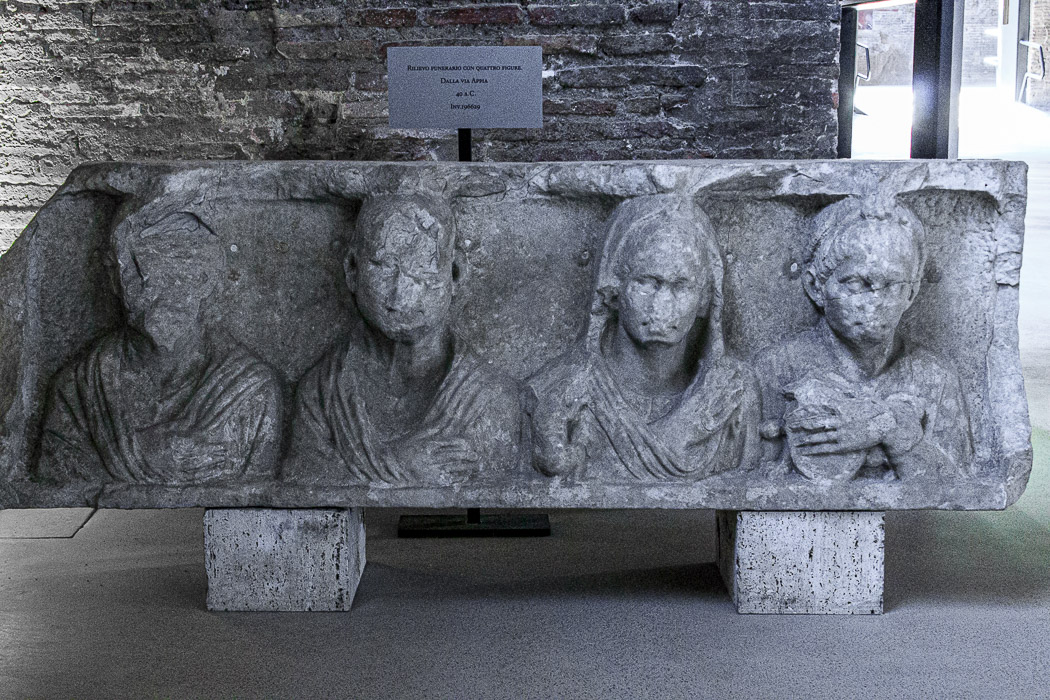

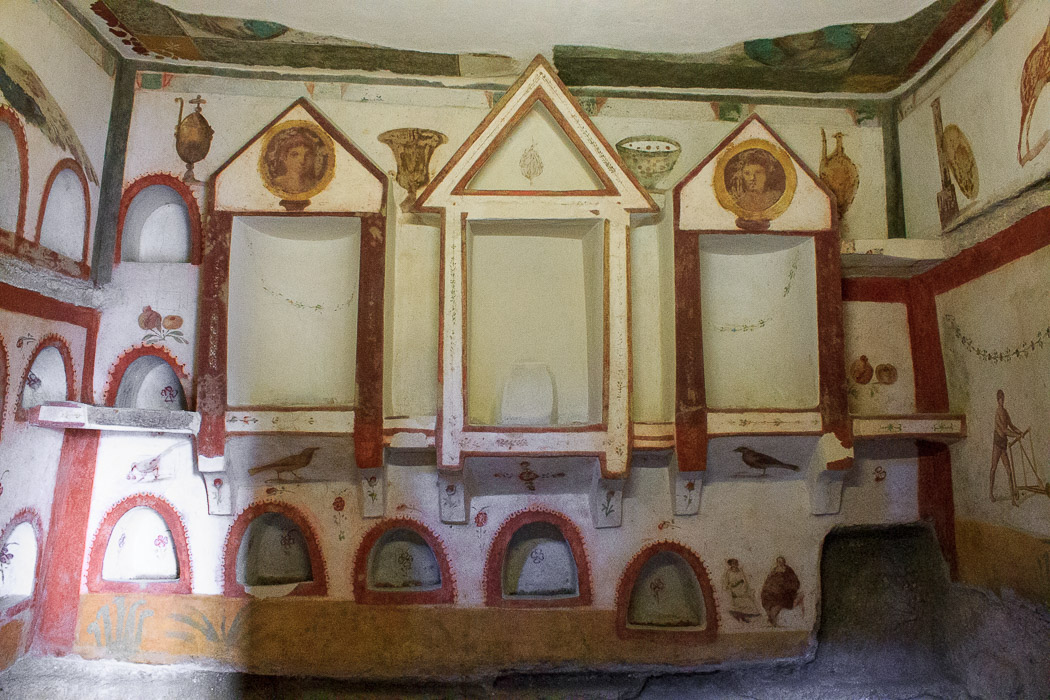
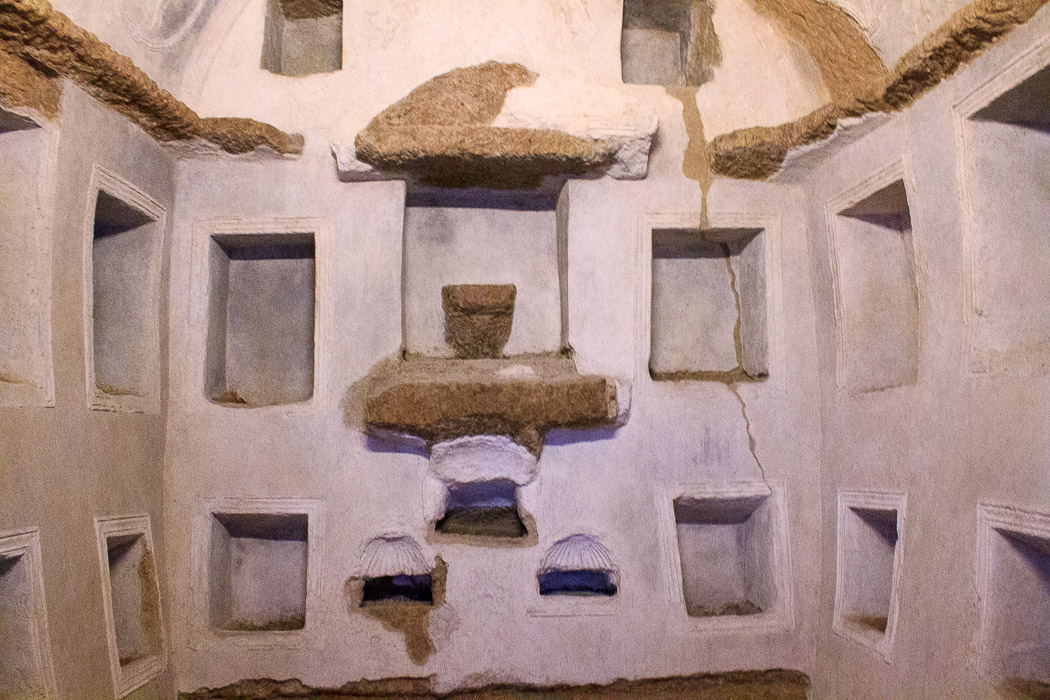
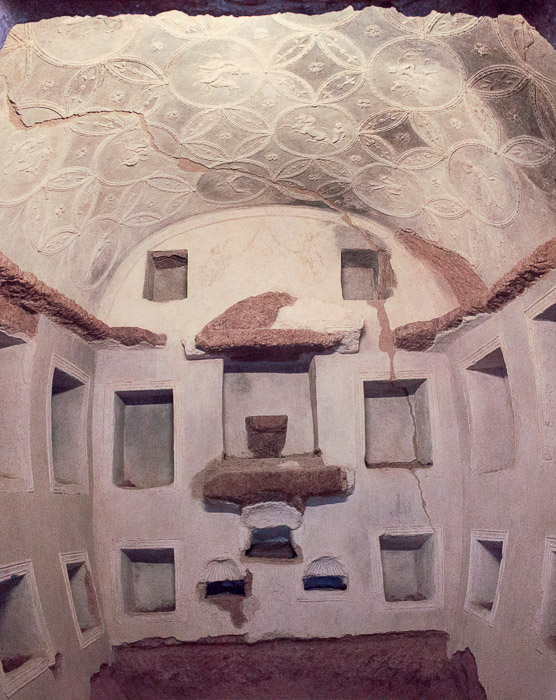
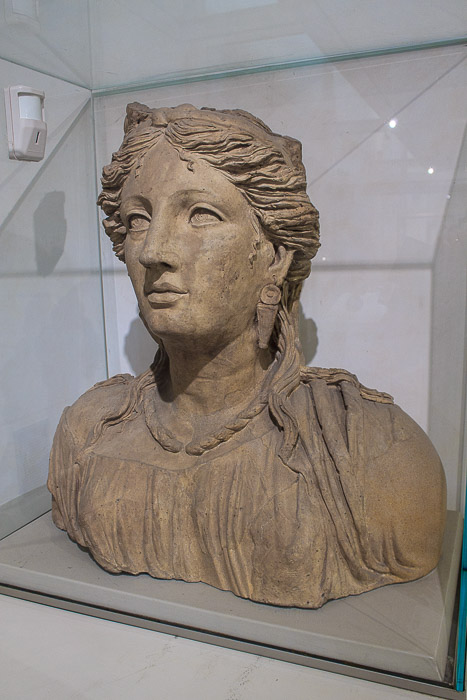
IMG_0251-20141012: A bust of Demeter in beige clay worked by fettling and die. The divinity who is dressed in a chitone and cloak, with a rich hairstyle in bands which are kept by a strip and ornated with an ears of corn diadem. She is richly adorned with rosette earings and a long pyramidal pendant and a torques with a snake's head at the end, from the 4th-3rd century BC, now iin the National Museum of Rome, Terme di Diocleziano (Baths of Diocletian)
See all
National Museum of Rome - Terme di Diocleziano photos.
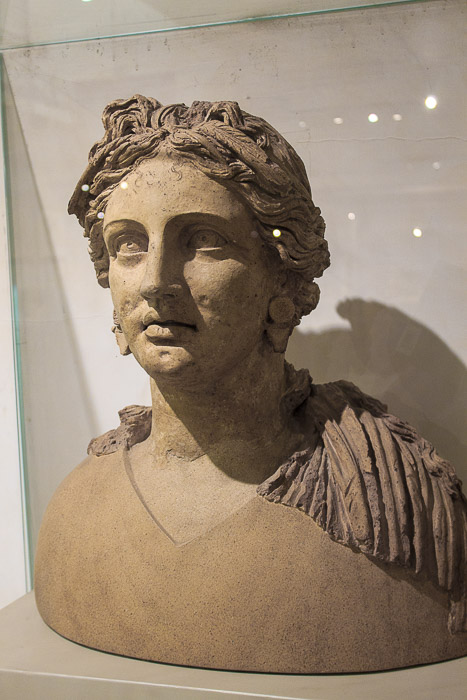
IMG_0253-20141012: A bust of Kore in beige terracotta worked by fettling and die. The divinity who is dressed in a cloak and ornated with Magna Grecia like jewels, presents a rich hairstyle with her locks divided in wavey bands kept by a hairband and tied with some ears of corn, from the 4th-3rd century BC, now iin the National Museum of Rome, Terme di Diocleziano (Baths of Diocletian)
See all
National Museum of Rome - Terme di Diocleziano photos.
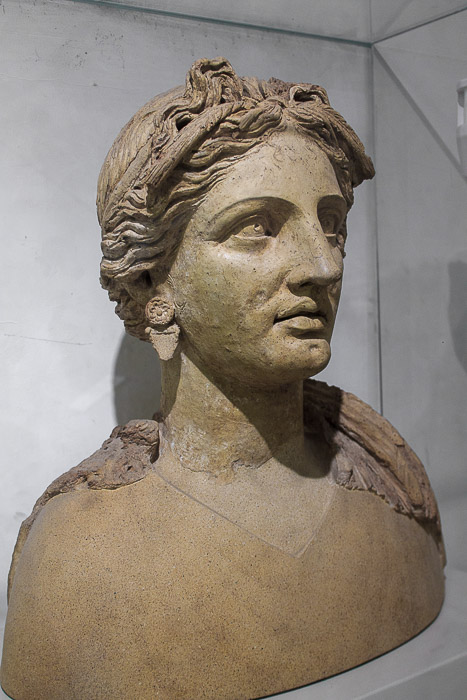
IMG_0254-20141012: A bust of Kore in beige terracotta worked by fettling and die. The divinity who is dressed in a cloak and ornated with Magna Grecia like jewels, presents a rich hairstyle with her locks divided in wavey bands kept by a hairband and tied with some ears of corn, from the 4th-3rd century BC, now iin the National Museum of Rome, Terme di Diocleziano (Baths of Diocletian)
See all
National Museum of Rome - Terme di Diocleziano photos.
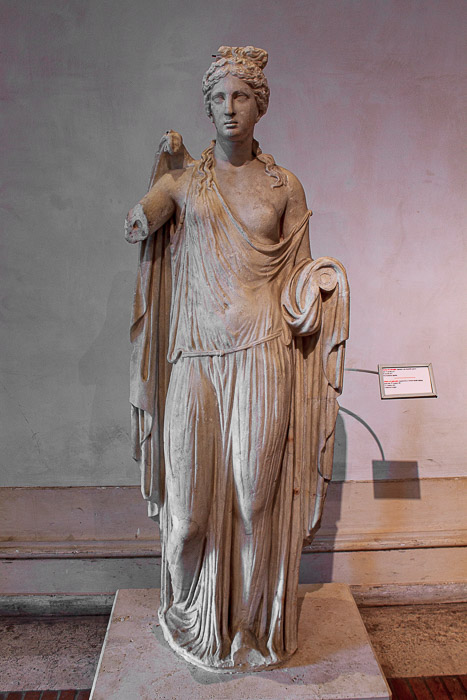
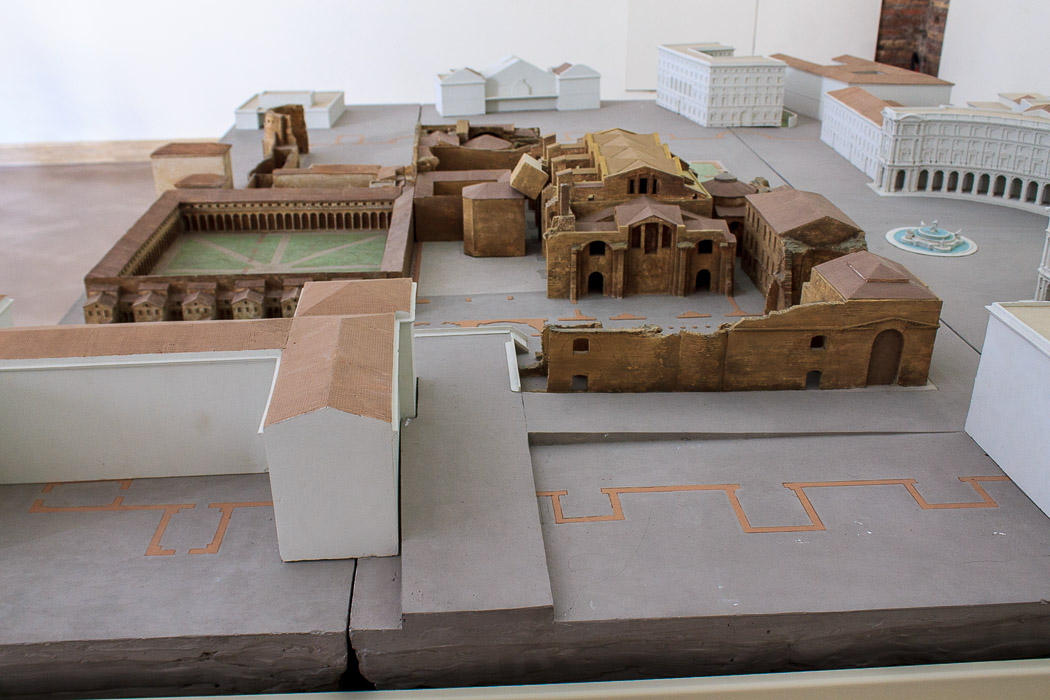
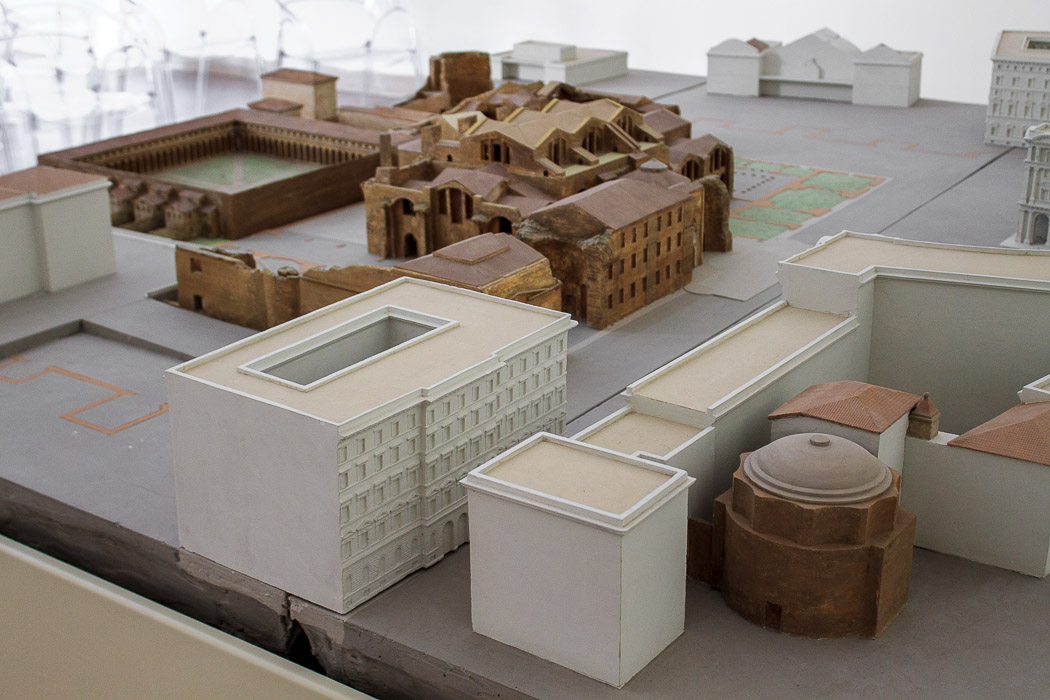
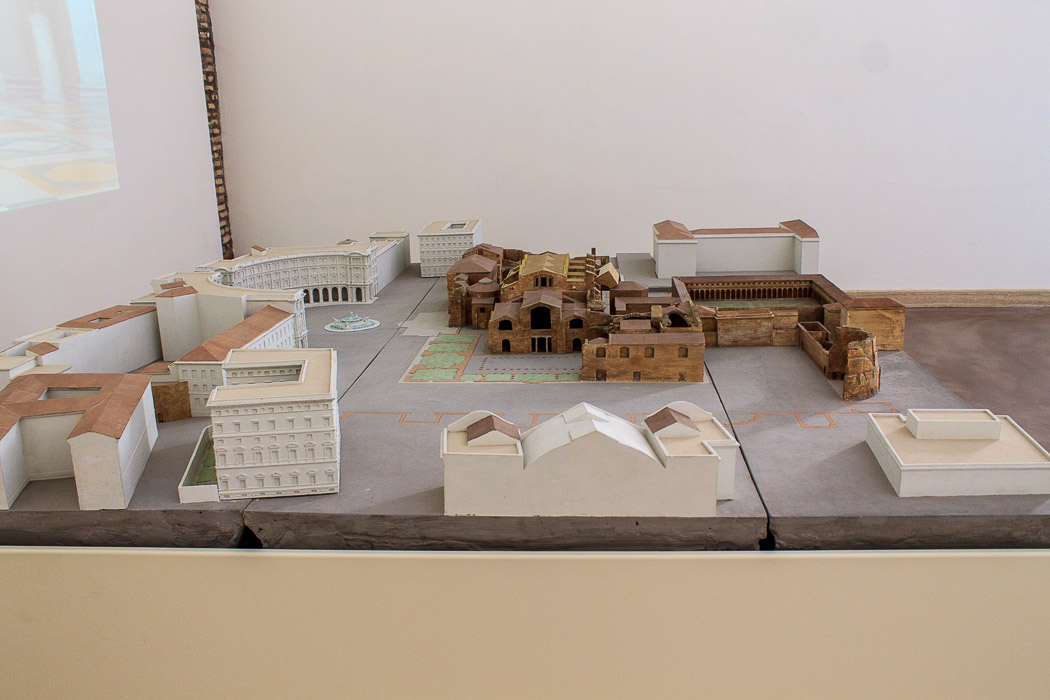
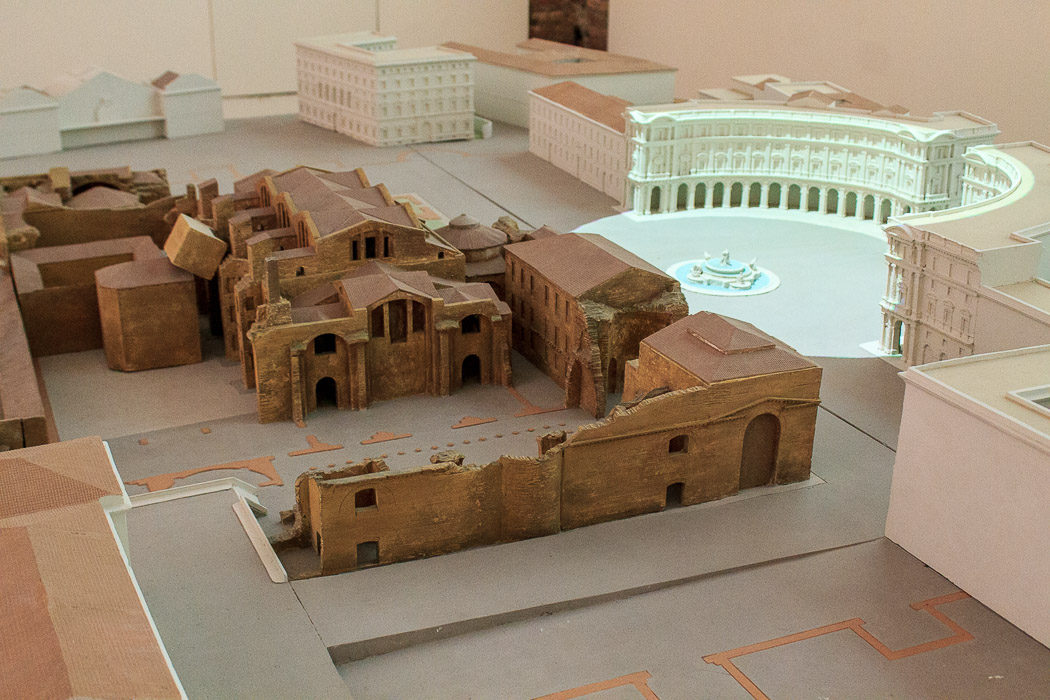
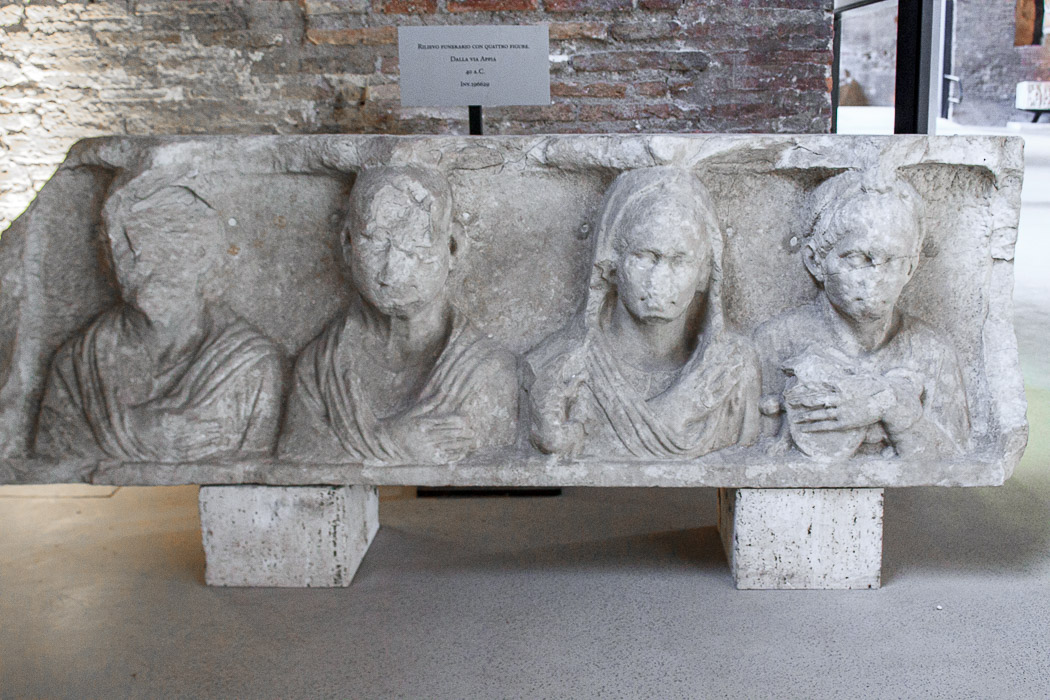
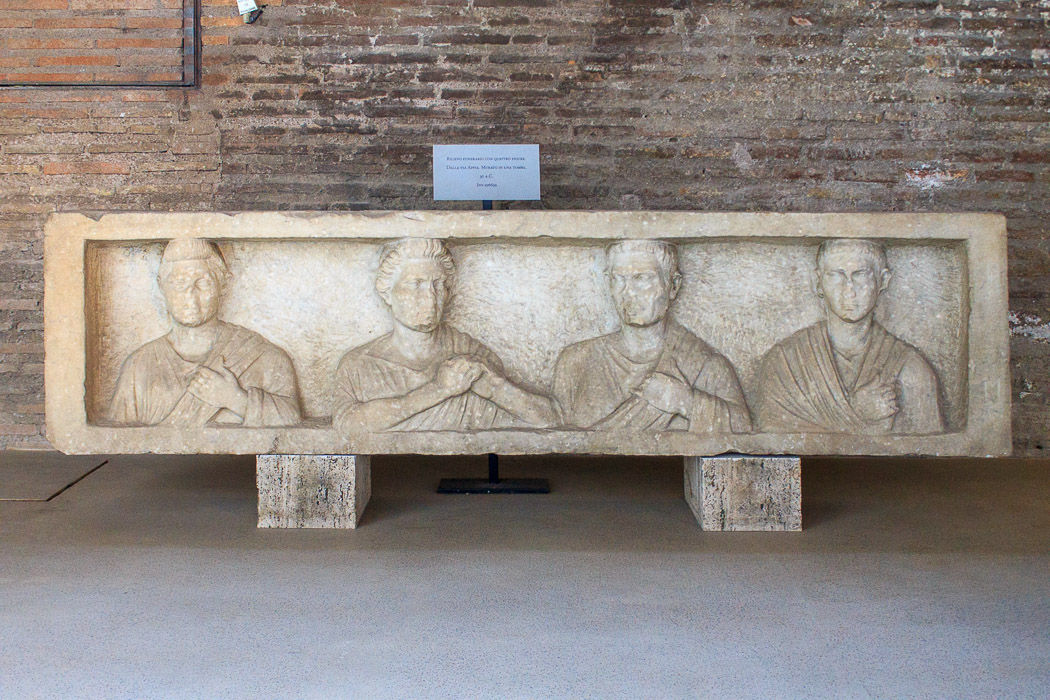
IMG_0240-20141012: Funerary relief with four figures, from the so-called Tomb of the Frontispiece on the Appian Way, 30 BC, in Hall X of the National Museum of Rome, Terme di Diocleziano (Baths of Diocletian)
See all
National Museum of Rome - Terme di Diocleziano photos.
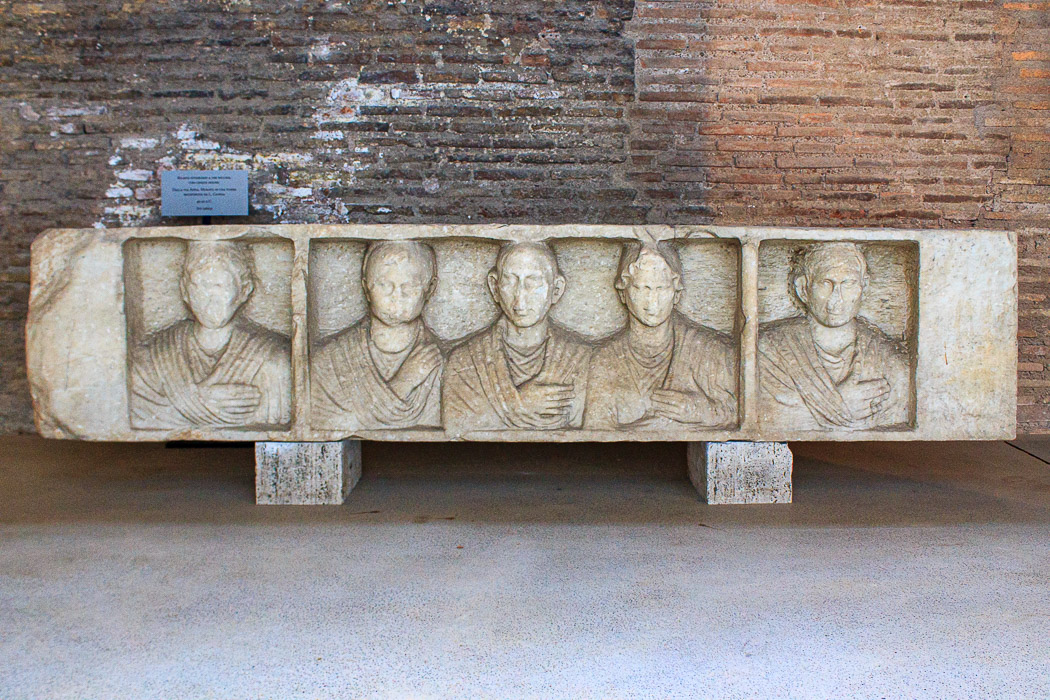
IMG_0242-20141012: Funeral relief from the Tomb of Ilario Fusco on the Appian Way, with three niches and five figures, from 40-30 BC, in Hall X of the National Museum of Rome, Terme di Diocleziano (Baths of Diocletian)
See all
National Museum of Rome - Terme di Diocleziano photos.
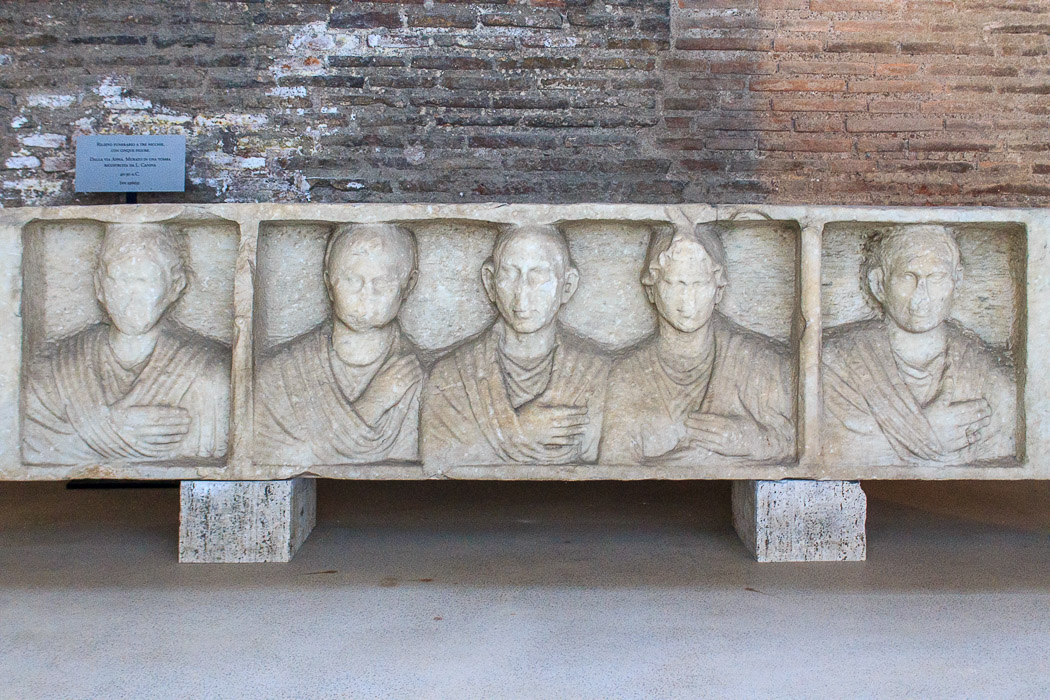
IMG_0243-20141012: Funeral relief from the Tomb of Ilario Fusco on the Appian Way, with three niches and five figures, from 40-30 BC, in Hall X of the National Museum of Rome, Terme di Diocleziano (Baths of Diocletian)
See all
National Museum of Rome - Terme di Diocleziano photos.
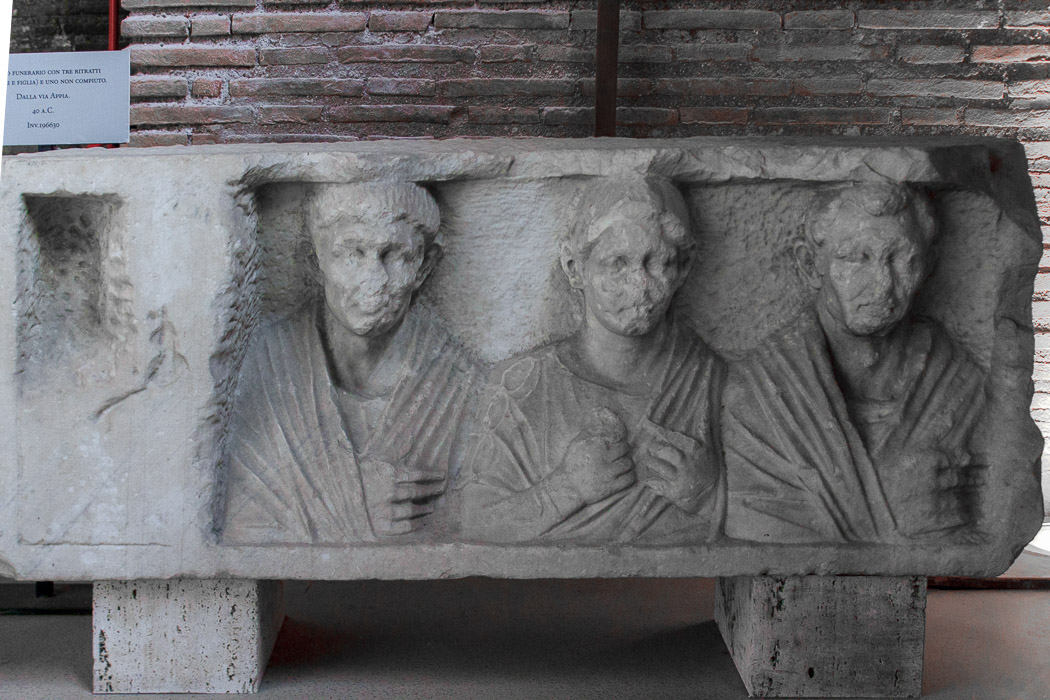
IMG_0245-20141012: Funerary relief with three portraits (parents and daughter) and one incomplete portrait, from the Appian Way, 40 BC, in Hall X of the National Museum of Rome, Terme di Diocleziano (Baths of Diocletian)
See all
National Museum of Rome - Terme di Diocleziano photos.
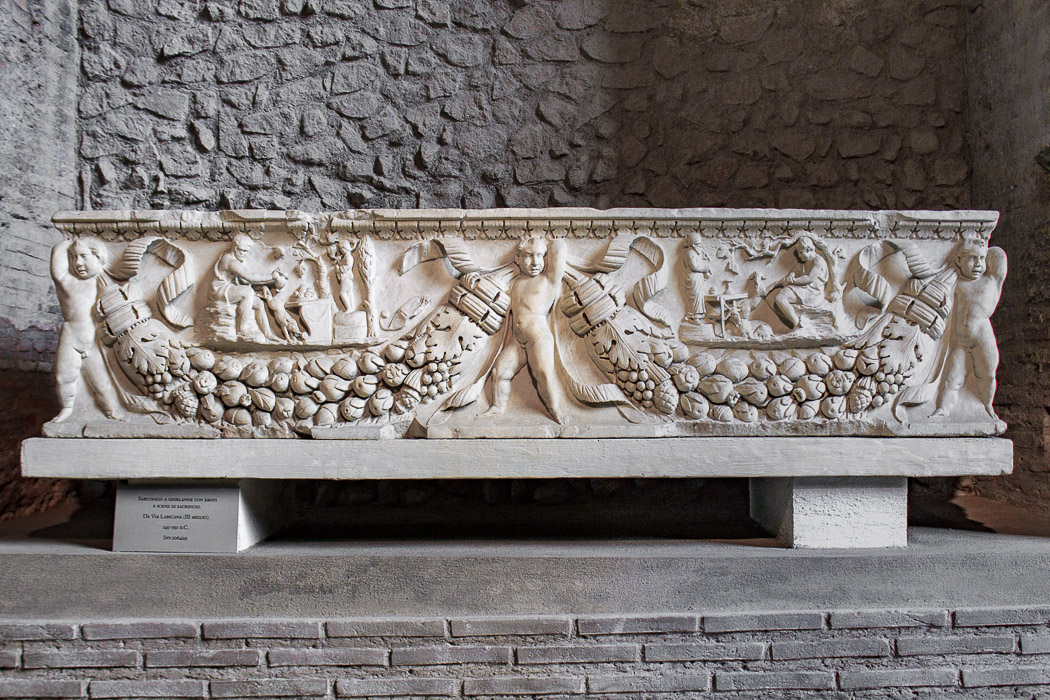
IMG_0247-20141012: Sarcophagus with garlands, with cupids and scenes of sacrifice, found on Via Labicana, from 140-150 AD, in Hall X of the National Museum of Rome, Terme di Diocleziano (Baths of Diocletian)
See all
National Museum of Rome - Terme di Diocleziano photos.
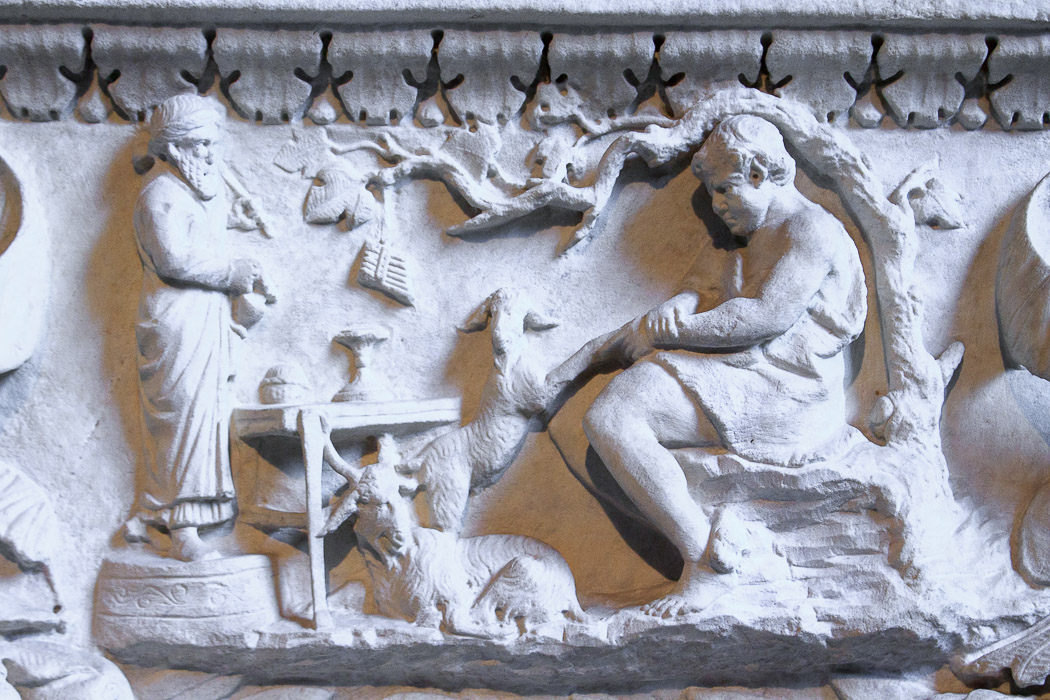
IMG_0248-20141012: Sarcophagus with garlands, with cupids and scenes of sacrifice, found on Via Labicana, from 140-150 AD, in Hall X of the National Museum of Rome, Terme di Diocleziano (Baths of Diocletian)
See all
National Museum of Rome - Terme di Diocleziano photos.
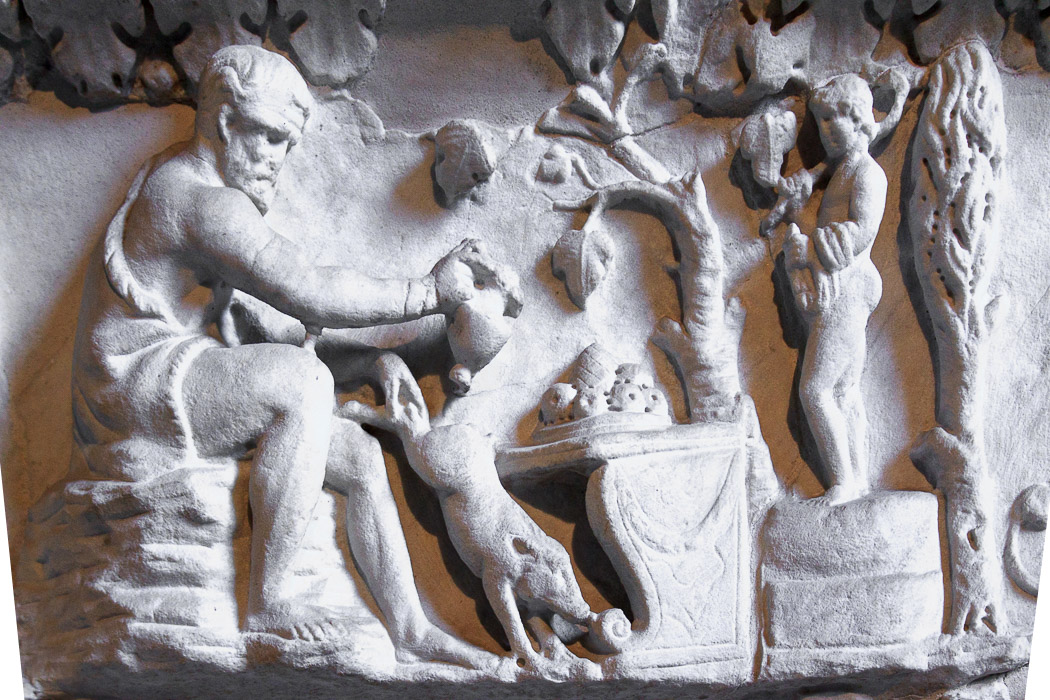
IMG_0249-20141012: Sarcophagus with garlands, with cupids and scenes of sacrifice, found on Via Labicana, from 140-150 AD, in Hall X of the National Museum of Rome, Terme di Diocleziano (Baths of Diocletian)
See all
National Museum of Rome - Terme di Diocleziano photos.
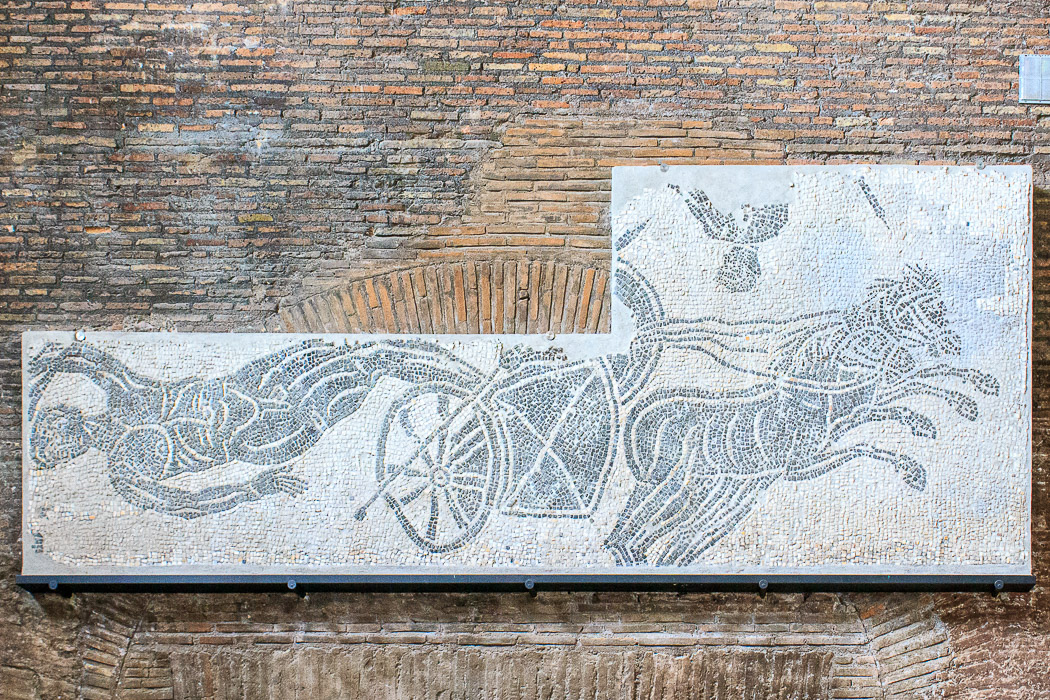
IMG_1524-20131005: Mosaic with Troilus Fallen off the Chariot, 3rd century AD, in Hall XI of the National Museum of Rome, Terme di Diocleziano (Baths of Diocletian). From Virgil's Aeneid, the young Trojan prince Troilus, stabbed by Achilles (in the upper part), hangs from his chariot, his spear scribbling in the dust, while his horses flee.
See all
National Museum of Rome - Terme di Diocleziano photos.
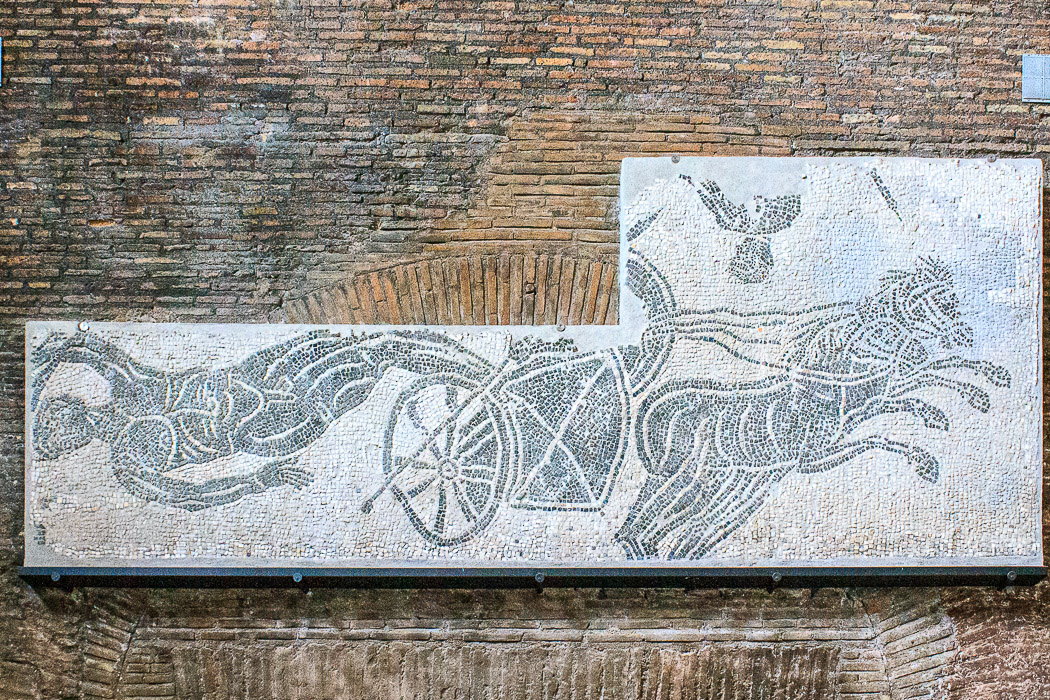
IMG_1528-20131005: Mosaic with Troilus Fallen off the Chariot, 3rd century AD, in Hall XI of the National Museum of Rome, Terme di Diocleziano (Baths of Diocletian). From Virgil's Aeneid, the young Trojan prince Troilus, stabbed by Achilles (in the upper part), hangs from his chariot, his spear scribbling in the dust, while his horses flee.
See all
National Museum of Rome - Terme di Diocleziano photos.
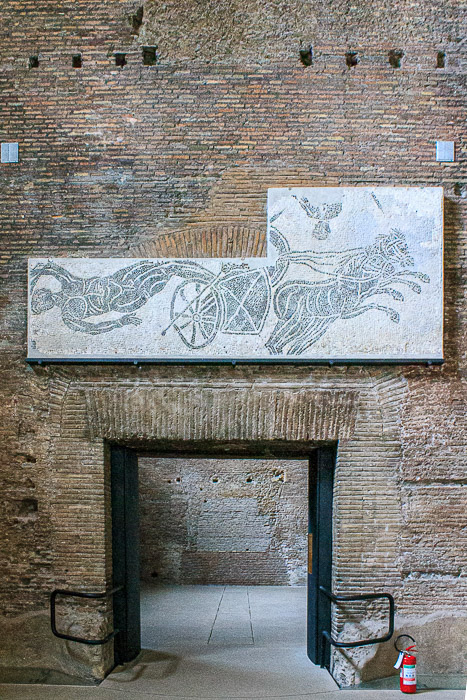
IMG_1529-20131005: Mosaic with Troilus Fallen off the Chariot, 3rd century AD, in Hall XI of the National Museum of Rome, Terme di Diocleziano (Baths of Diocletian). From Virgil's Aeneid, the young Trojan prince Troilus, stabbed by Achilles (in the upper part), hangs from his chariot, his spear scribbling in the dust, while his horses flee.
See all
National Museum of Rome - Terme di Diocleziano photos.
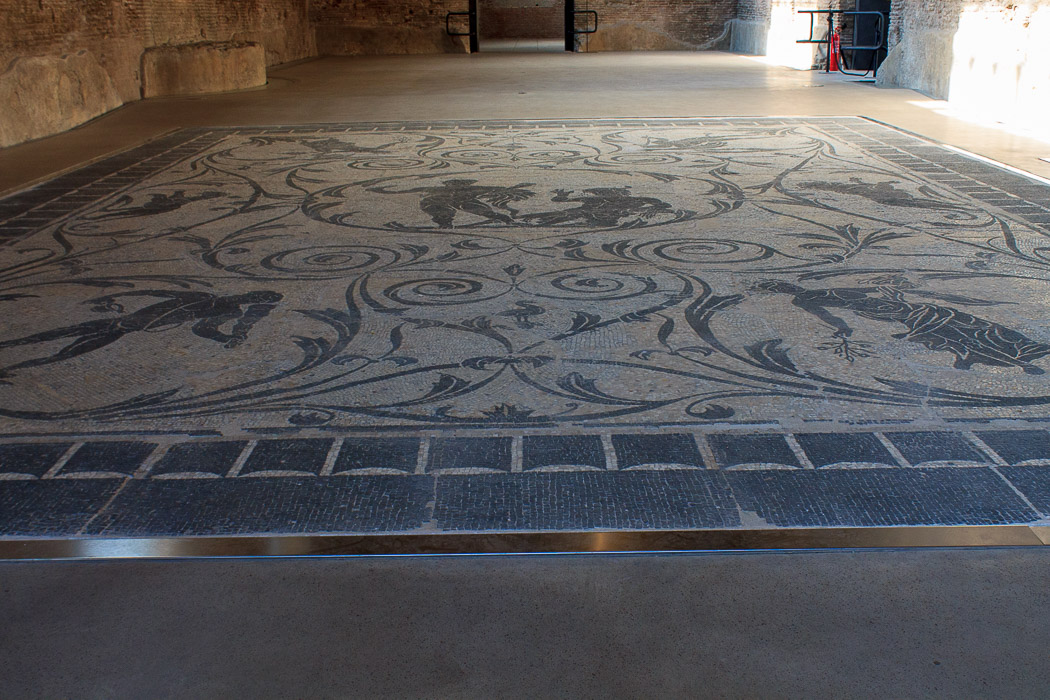
IMG_7879-20141007: Mosaic with Hercules and Achelous, 3rd century AD, from Nero's Villa in Anzio, now in Hall XI of the National Museum of Rome, Terme di Diocleziano (Baths of Diocletian). Hercules, recognizable by the club and lion's skin, holds the horn he tore off the bleeding head of the River-God Achelous, defeated in the contest for the hand of the princess Deianira.
See all
National Museum of Rome - Terme di Diocleziano photos.
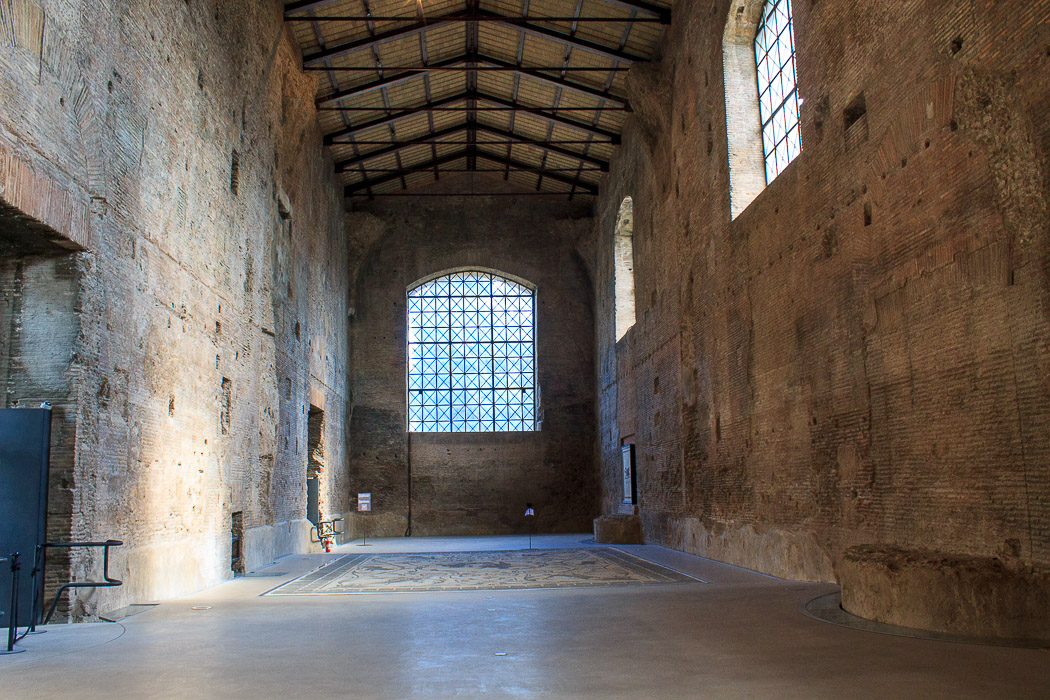
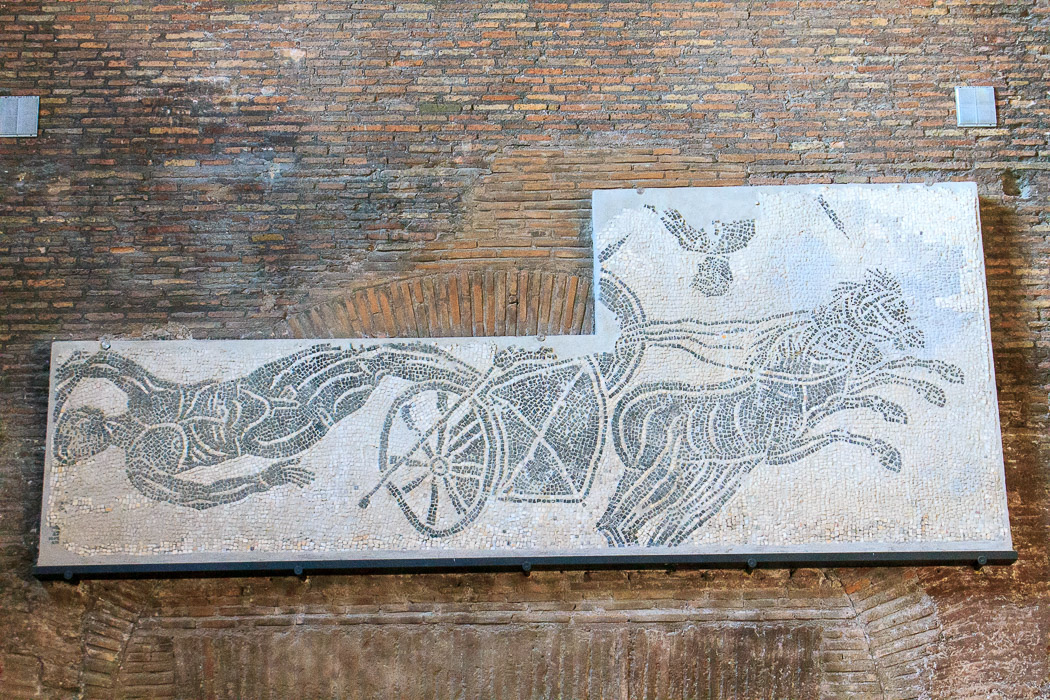
IMG_7882-20141007: Mosaic with Troilus Fallen off the Chariot, 3rd century AD, in Hall XI of the National Museum of Rome, Terme di Diocleziano (Baths of Diocletian). From Virgil's Aeneid, the young Trojan prince Troilus, stabbed by Achilles (in the upper part), hangs from his chariot, his spear scribbling in the dust, while his horses flee.
See all
National Museum of Rome - Terme di Diocleziano photos.
See also: